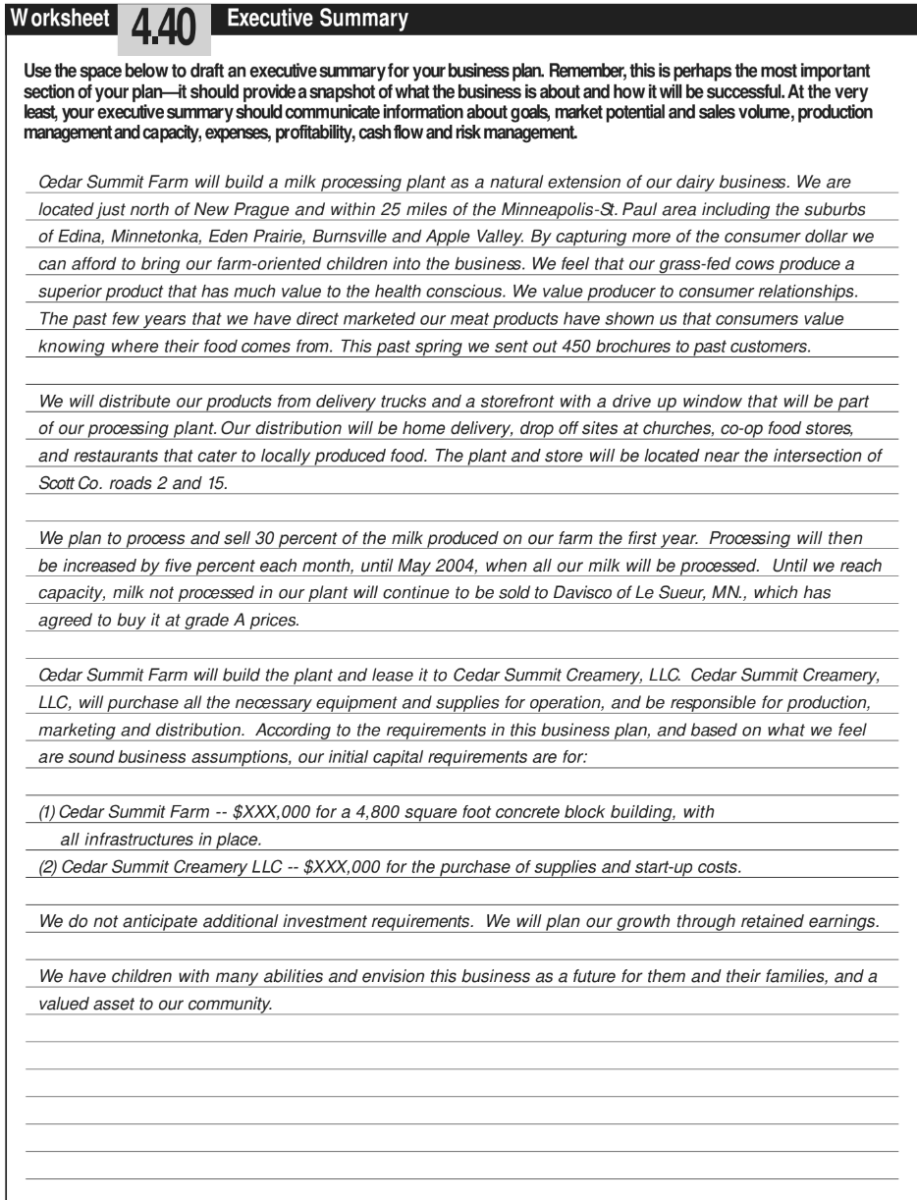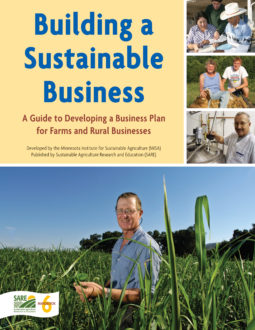Planning Task Four
Develop a business strategy:
Marketing Strategy
- Markets
- Product
- Competition
- Distribution and Packaging
- Pricing
- Promotion
- Inventory and Management
- Develop a Strategic Marketing Plan
Operating Strategy
- Production Management
- Regulations and Policy
- Resource Needs
- Resource Gaps
- Size and Capacity
- Develop a Strategic Operations Plan
Human Resources Strategy
- Labor Needs
- Labor Gaps
- Compensation
- Management and Communications
- Develop a Strategic Human Resources Plan
Financial Strategy
- Risk
- Organizational Structure
- Finance
- Develop a Strategic Financial Plan
Whole Farm Strategy
Choose the best whole farm strategy
Develop contingency plans
Develop the Strategic Planning section of your Business Plan

Strategy is defined as a “careful plan or method for achieving an end.” That’s your challenge in this Planning Task. You’ve envisioned your future, based on your goals and values, so you know what you want the “end” to look like. Now you need to take the time to carefully think through the steps you can take to get there. Think about planning a trip. You know your destination—but what’s the best way to get there? You could fly, take a train, or drive. You might sketch out the trip for each possibility, by researching the plane and train schedules and consulting roadmaps. You develop a “careful plan.” Then you evaluate. You weigh many factors—the cost of each, your enjoyment using each of those means, possible problems such as road construction, delays at airports, and so forth. Then you choose the best option for you. Essentially, that is what you will be doing in the five steps of this Planning Task: Developing a plan to achieve your envisioned business, weighing it against other options, considering how the situation might change (market, interest rates, labor, etc.), and how those changes would affect your plan.
Dave and Florence Minar defined very specific personal, family, and business goals for Cedar Summit Farm. Their goals are tied to a set of values concerning family, environment and community that have grown through time. Their challenge in this Planning Task was to develop a whole farm strategy that, over the course of five, ten or more years, would live up to their values—a strategy that would move them toward their goals, by taking advantage of current business strengths and perceived market opportunities.
If you have completed the Worksheets for the preceding Planning Tasks, then you have already laid the foundation for strategic planning. Your job in Planning Task Four is to begin building a whole farm strategic plan for your future on top of that foundation.
In Planning Task Four you will:
- Develop a business strategy.
- Evaluate strategic alternatives.
- Decide on a whole farm strategic course of action.
- Develop contingency plans.
- Develop the strategic section of your business plan.
Business strategies are realistic actions that communicate how you plan to
reach your goals. There are an endless number of potential strategies that can
be developed for each functional area of the business or the farm as a whole.
Your task will be to narrow the list of possibilities to those marketing, operations, human resources and financial strategies that best address your critical planning needs, and are compatible with your values, vision and goals. A simple rule of thumb to follow when developing strategies is to take advantage of your business’ internal strengths. “A farm’s strategy ought to be grounded in what it is good at doing (i.e., its strengths and competitive capabilities).”
We suggest beginning your strategy research and development with the functional area that most clearly addresses your critical planning need or whole farm strategy idea. Then move on to the other functional areas. Dave and Florence Minar began their strategy research with human resources. They took a look at how on-farm processing might address their critical planning need to provide new jobs and income for family members. They then studied the market to gauge sales potential and competition while simultaneously researching equipment options and processing capacity. The last thing they developed was a financial strategy.
As you research and develop your business strategies, you will consider many of the same marketing, operations, human resources and finance questions that you first considered when you assessed your current situation in Planning Task Two. This time around involves more research. You will answer these same questions, using educated guesses rather than actual experience.
Once you have identified a set of feasible strategic alternatives for each functional area of the business through research and evaluation, you will link them together into a system-wide, whole farm business strategy complete with contingency and implementation plans. When you are done with this Planning Task you should be ready to draft your business plan.
This is a very involved Planning Task—take your time. Most importantly, consult planning team members and get outside help when you need it. Don’t
expect to be an expert on everything (marketing, operations, people management, legal issues, financial analysis), particularly when researching a new idea. The Minars created a board of advisors, in addition to planning team members, to help them identify and evaluate strategic marketing and operations alternatives. Their advisors included a local banker, farm business management consultant, meat processor, clients, and other farmers. Consult the “Resources” section at the end of this Guide for assistance in locating outside help whenever and wherever you need it.
Because each business is unique, every strategic need cannot be addressed in this Guide. Clearly, most of your strategy work will take place in person with your planning team members. Worksheets are provided to help you flesh out and record the details of your business strategy alternatives.
Develop a Business Strategy

This first step in your strategic plan, Develop a Business Strategy, is where you’ll spend the majority of your time and effort for this Planning Task. You will consider all four functional areas, and you’ll consider many variables within each of those areas. We’ll remind you of where you are in the process from time to time. In the sections that follow, you will have the opportunity to identify and research alternative strategies for each functional area of the business—marketing, operations, human resources and finances. Begin by returning to your Whole Farm SWOT Analysis (Worksheet 2.18) to review the internal strengths of your present business and any perceived industry opportunities, as well as the internal weaknesses and external business threats you and your planning team identified. Good business strategies always take advantage of current business strengths and market opportunities. At the same time, a solid business strategy will address current weaknesses and perceived threats. With your SWOT Analysis in hand, you are ready to begin developing specific marketing, operations, human resources and finance strategies for the business.
Marketing Strategy
The marketing component of your business strategy will determine, in large part, the success of your business. As marketing consultant Barbara Findlay Schenck said: “Without customers, a business is out of business.”Your marketing strategy is about defining your customer or target market and tailoring your product, pricing, distribution and promotion strategies to satisfy that target market. Marketing experts warn that businesses that are product oriented—those that try to sell what they can produce without first looking at customers’ needs—risk developing a product that won’t sell. Instead, most successful businesses are customer oriented—they design marketing strategies around the needs of their customers.
At the end of this step, you should be able to confidently answer the following questions:
- Markets: Who are our target customers and what do they value?
- Product: What product will we offer and how is it unique?
- Competition: Who are our competitors and how will we position ourselves?
- Distribution and packaging: How and when will we move our product to market?
- Prices: How will we price our product?
- Promotion: How and what will we communicate with buyers or customers?
To complete the Marketing segment of the Develop a Business Strategy step, you will address the issues shown at right.
As you begin your research, track any expenses associated with the marketing strategies that you develop. You will be asked to record this information in your Marketing Strategy Summary (Worksheet 4.9).
markets: Who are our target customers and what do they value?
Most marketing plans begin with a description of the business’ target market, or its potential customers. Your first task in building a customer strategy is to identify your target market. Target markets are most commonly characterized as either individual households or businesses.
Direct marketing to individual households or customers can be performed on a small scale. This form of marketing tends to be more profitable than business-to-business marketing because of value-added opportunities and the lack of middlemen. Most direct market products are consumer goods or services. Popular direct market opportunities include Community Supported Agriculture (CSA), Pick Your Own (PYO) and farmers’ markets.
Business-to-business marketing typically involves sales of a raw commodity or product that will be used as an input. Traditional commodity producers almost always practice business-to-business marketing where customers include grain companies, processors, packers and millers. Today’s specialty or differentiated commodity producers, however, are learning to build in more profit by responding directly to market demand for unique products, such as tofu grade soybeans, high oil corn, grass-fed livestock, organic feed, and heirloom vegetables. Don’t overlook today’s business-to-business opportunities to contract and market specialty commodities.
Figure 37. Market Segmentation Alternatives
Geographic:
Segmenting customers by regions, counties, states, countries, zip codes and census tracts.
Demographics:
Segmenting customers into groups based on age, sex, race, religion, education, marital status, income and household size.
Psychographics:
Segmenting customers by lifestyle characteristics,
behavioral patterns, beliefs and values, attitudes about themselves, their families and society.
That said, if you plan to market a raw commodity directly to an elevator, packer or overseas broker, your marketing strategy will be very different (and presumably less intensive) than that of someone who is looking at direct marketing a differentiated product to a well-defined market of individual customers.
In order to fully define your target market and corresponding customer strategy, you will need to identify your target market segment (who your customers are and what they value) and sales potential (how much they are willing to buy). This research is critical for building your business. Marketing author Michael O’Donnell notes that one of the most common planning mistakes is failure to fully “understand the market makeup and what segment the company will concentrate on.”
Segmentation. Dave and Florence Minar identified. “individuals” (as opposed to other businesses) as their target market for Cedar Summit Farm dairy products. This target market was very different from their customer at the time, Davisco, which acted as a distribution intermediary by purchasing bulk milk for further processing. Consequently, when the Minars began the planning process, they had to conduct substantial research to learn about their new target market size, geographic location, purchasing patterns and preferences.
This process of identifying customers’ preferences and dividing the large target market into submarkets is called market segmentation. By identifying and targeting specific market segments you should be able to develop more effective packaging, price and promotion strategies.16 Markets can be segmented in a variety of ways. The most common forms of segmentation are by demographic, geographic, psychographic and product-use characteristics.
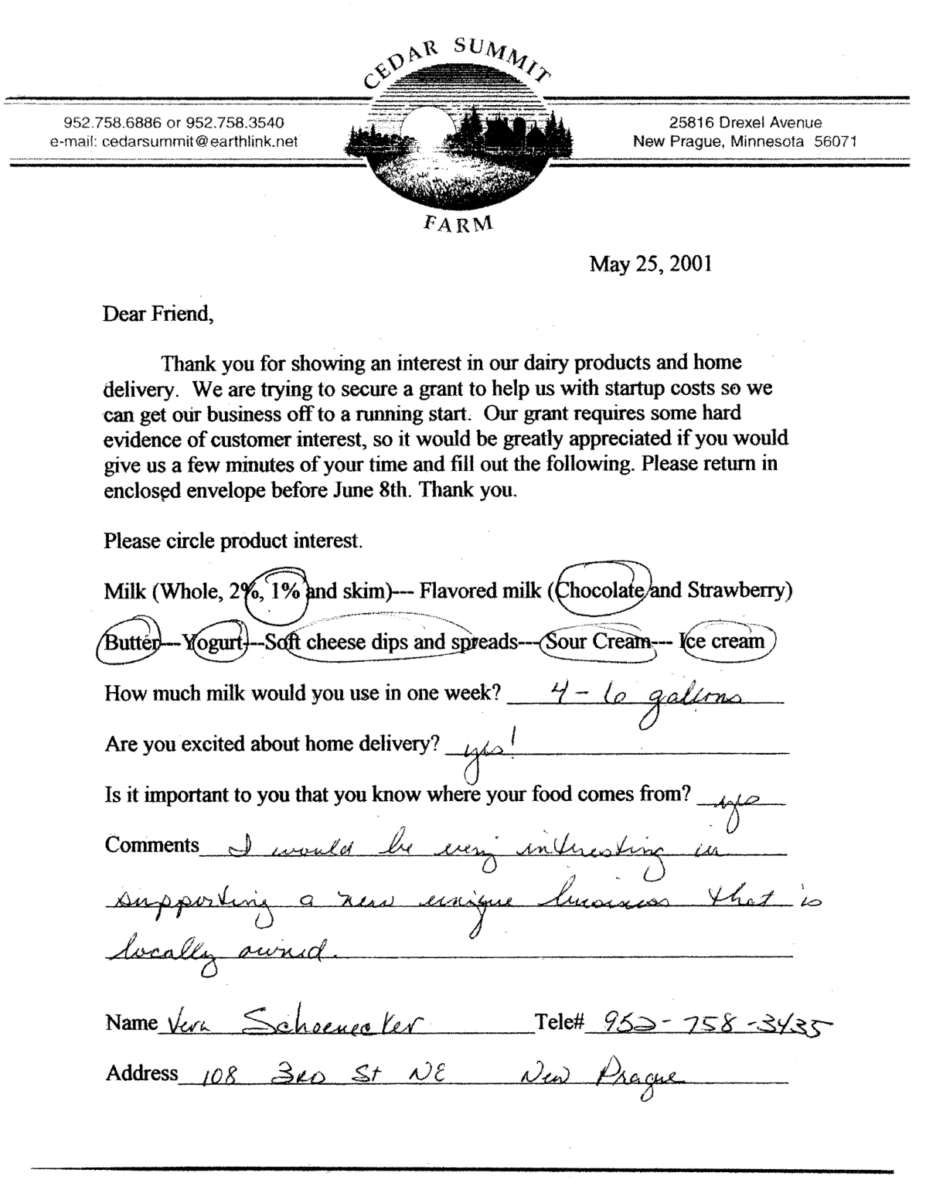
For instance, a market can be segmented into domestic and international subgroups if you are planning to market organic soybeans like Mabel Brelje; or into on-farm and off-farm buyer groups for gourmet cheese like Dancing Winds Farm owner Mary Doerr. Your market can also be segmented by the frequency of customer purchases, as considered by Riverbend Farm owner Greg Reynolds for weekly versus monthly vegetable customers.
Dave and Florence Minar divided their target market for bottled milk into two major groups by distribution channel, home delivery and retail customers (see Worksheet 4.1). In an effort to learn about their potential home delivery customers, the Minars surveyed 75 New Prague residents about their preferences for flavored milk, weekly milk consumption, and overall interest in home delivery. Based on this research, they developed a customer profile for New Prague home delivery customers.
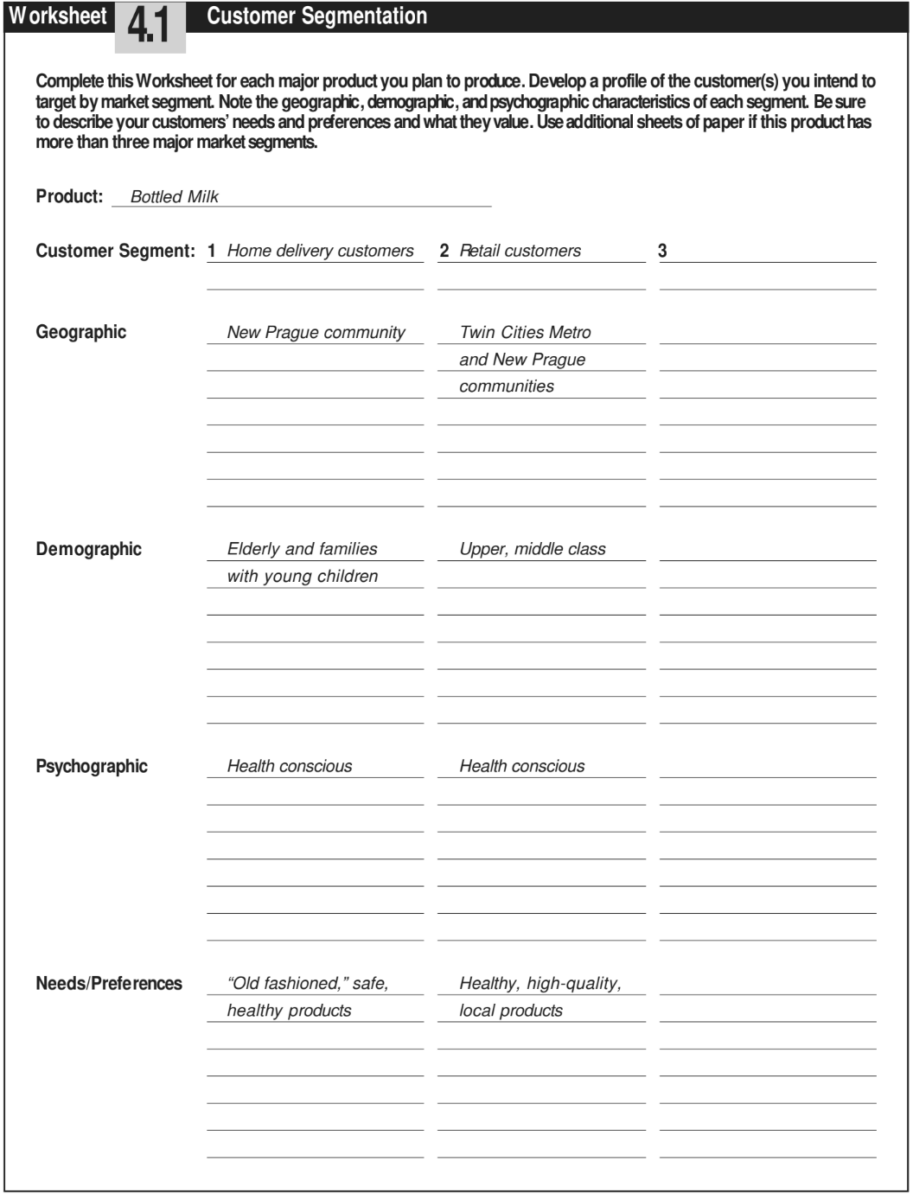
Like the Minars, begin your target market research by developing a customer profile. Customer profiles can help you determine if a market segment is large enough to be profitable. Break your target market up into segments based on differences in their geographic location, demographic characteristics, social class, personality, buying behavior or benefits sought. Use Worksheet 4.1: Customer Segmentation (download worksheets for task 4) to help you develop and research customer profiles.
Sales potential. If you plan to produce and market a traditional bulk commodity, you won’t have much trouble calculating sales potential. The market for undifferentiated commodities is fluid and can typically absorb all that you produce (albeit at a lower price sometimes). Estimating sales potential becomes more challenging and important when tapping into a specialty commodity market (such as lentils) that may have limited demand, or when your target market is highly sought after and made up of individual households.
As a specialty commodity producer, your customer (usually another business) will make known how much they are willing to buy short-term (one to two years either through a written contract or verbal agreement. Projecting long-term sales potential may prove more difficult as these markets are usually immature and untested. Similarly, your task of projecting sales potential can be tricky when marketing to individual households. You will need to conduct careful research and be honest with yourself about the market’s growth potential. As mentioned earlier, Dave and Florence Minar of Cedar Summit Farm surveyed their local community about milk usage and demand for home delivery services. From this research, they were able to project sales of up to 798 gallons of home delivered bottle milk per week.
Alternatively, if the Minars did not have the luxury of time or funds to survey their target market, they might develop conservative sales estimates based on the number of households/residents within 25-50 miles of their farm.17 This is how far customers typically travel to purchase something. Cooperative Development Services representative Kevin Edberg says that as a general rule, 75 percent of direct market customers will live within 20 miles of your business.
Using this rule of thumb, Edberg and author Ron Macher suggest a simple way to project direct market sales potential. Begin by locating your farm on a county map and draw 25 and 50 mile radius circles around your farm. Count how many towns or cities fall within the circles. Using this map, add up the number of potential households that live in the nearby cities. These households represent your core potential business customers. Then, with a feel for the number of potential customers, estimate
the potential value of sales per household. This is your sales potential. Begin by estimating the number of customers in each segment and projecting their weekly, monthly or annual purchases. You can develop sales estimates from household or county purchasing records (available at your public library), from your own surveys, in person interviews, or from secondary sources, such as published purchasing pattern data. Excellent sources for consumer demographic and purchasing pattern data are CACI Market System Group Sourcebook, SRDS Lifestyle Market Analyst, and New Strategist Publications’ Household Spending: Who Spends How Much on What. These are available in the reference section of your public library.
Use the space in Worksheet 4.2: Potential Sales Volume (download worksheets for task 4) to begin developing sales estimates for each product that you plan to produce.
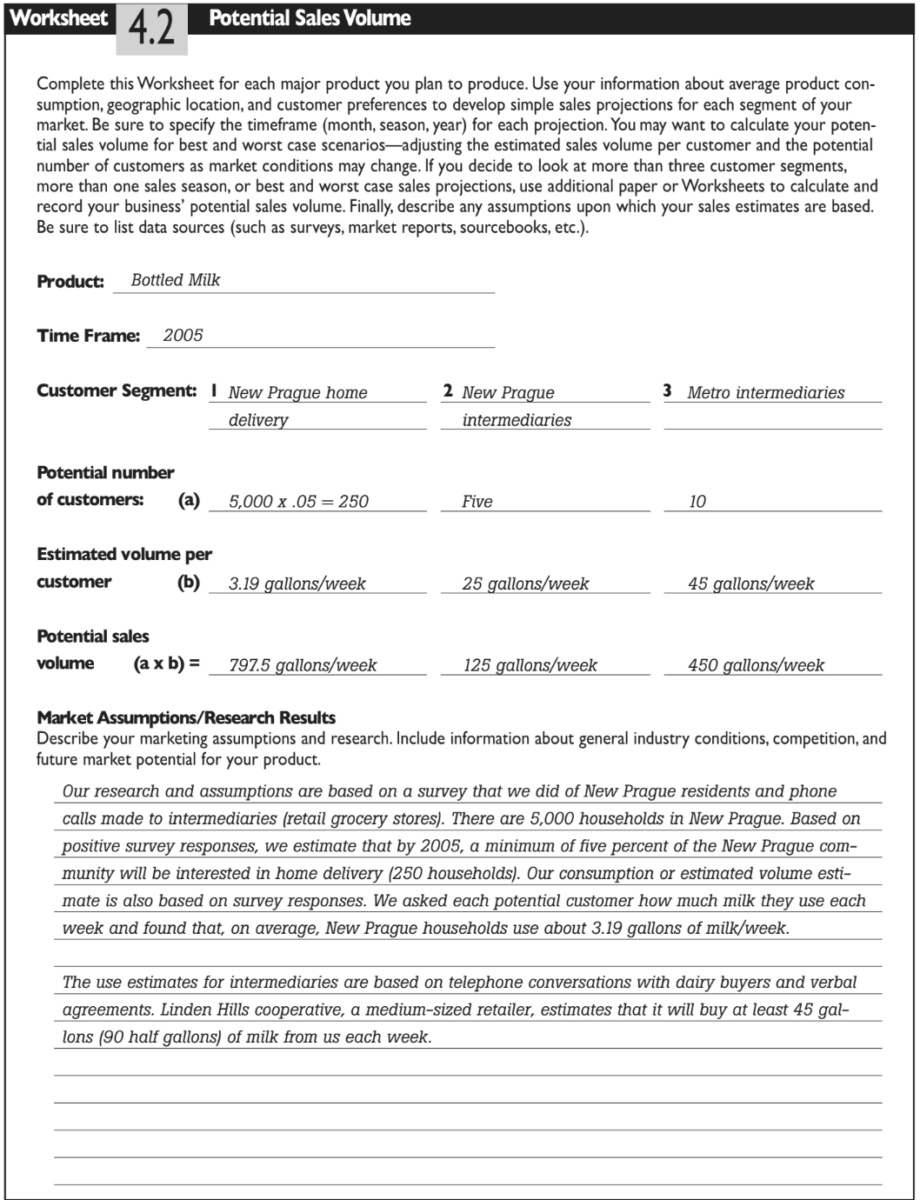
Although much of the market research needed for a business plan can begin with your own impressions and a little footwork at the library, you may reach a point where professional help is needed. Many businesses find it useful to hire a marketing consultant to develop proper surveys, lead focus groups, or to conduct telephone interviews. Representatives from your local Extension service or your state Department of Agriculture may be able to assist you in locating qualitative and quantitative information for a customer profile. The Minnesota Department of Agriculture (MDA), for instance, conducted its own surveys of farmers’ market, u-pick, and Christmas tree farm customers about spending patterns. Survey results are available from MDA’s Minnesota Grown Program. MDA also offers a comprehensive listing of more than 65 regional businesses that buy or process certified organic grains, oilseeds, fruits, vegetables, herbs and maple syrup.
Financial assistance may also be available to help cover some of the costs associated with your marketing research. You should check with your state Department of Agriculture, your local county Extension service (these phone numbers should be listed in your telephone book), as well as the United States Department of Agriculture (USDA), to see what programs are available in your area. The USDA Service Center locations give you access to the services and programs provided by the Farm Service Agency, Natural Resources Conservation Service, and the Rural Development agencies. You might also contact the Sustainable Agriculture Research and Education (SARE) Program in your region to see if they know of any programs available to fund market research for farmers (www.sare.org/). In Minnesota, the Minnesota Department of Agriculture and the Agricultural Utilization and Research Institute (AURI) both provide some financial assistance for marketing research. AURI provides grants to individual business owners and cooperatives for the development of logos, labels and marketing plans.
product: What product will we offer and how is it unique?
Although customer research is the single most important component in building a marketing strategy, it is often the product itself that inspires and excites many business owners. Here’s your chance to develop a thorough product description. Recall that a “product” is any commodity, final consumer good, or service.
As you think about the products your business will offer, try to describe them in terms of the value they will bring to your customers. What is it that customers are actually buying? Dave and Florence Minar described their bottle milk products as “non-homogenized, cream-top milk from grass-fed cows.” In the Minars’ case, customers will be buying old-fashioned taste (non-homogenized milk) and perceived health benefits (associated with milk from grass-fed cows). Moreover, New Prague families will also be purchasing a service: home delivery. This service required research and a pricing strategy just like all of the other products offered by Cedar Summit Farm.
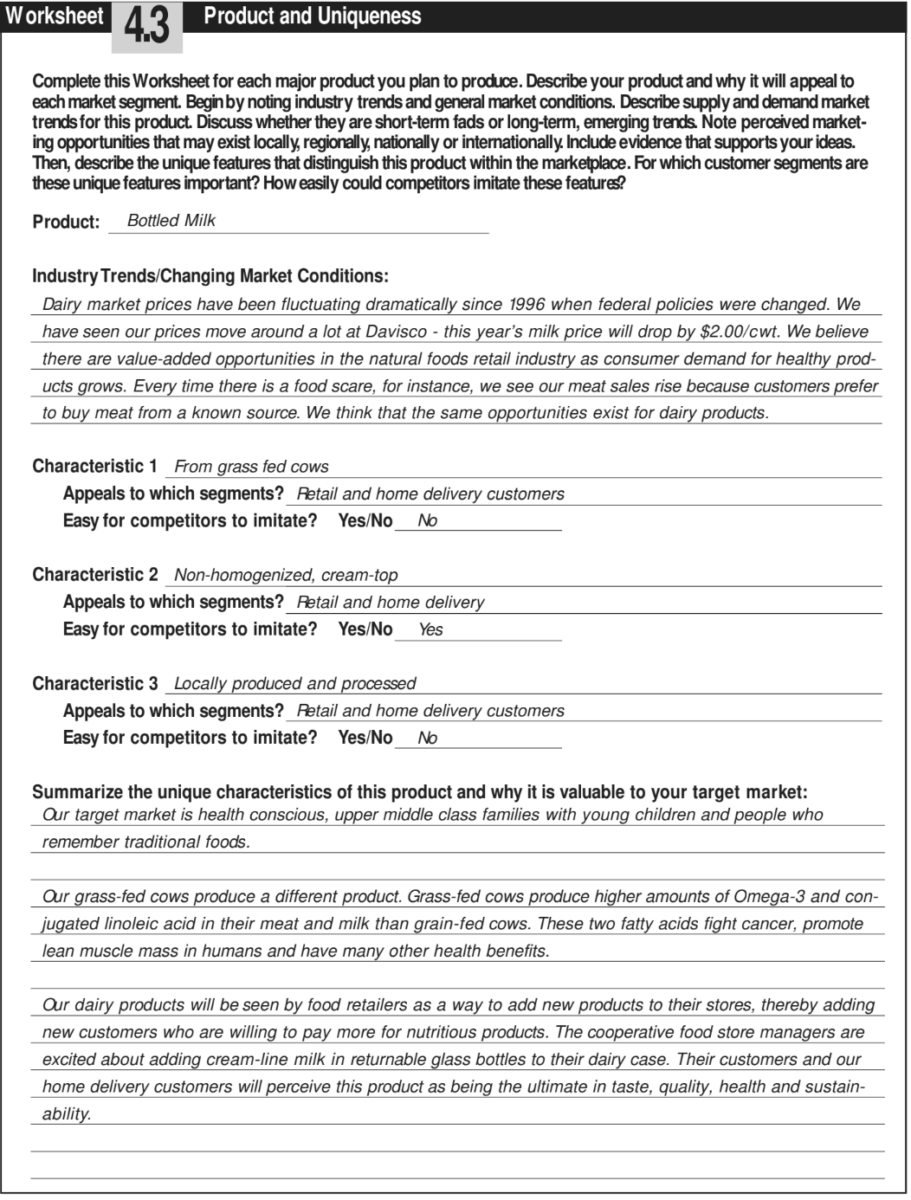
Another way to look at your product is in terms of its uniqueness. What makes your product truly unique? Why would customers prefer your product to another farmer’s? Are there differences in the production process that make it more wholesome and fresh? Can you appeal to the environmentally conscious? Try to look down the road a bit as you profile your product. Will there be new opportunities to add value through processing, packaging, and customer service? How might your product line or services change over time? Use Worksheet 4.3: Product and Uniqueness (download worksheets for task 4) to describe each of the products that you plan to offer, why they are unique, and how they may change in the future.
competition: who are our competitors and how will we position ourselves?
Nearly every business or product has competition of some kind. Find out who your competitors are and what they offer to customers. A trip to the local grocery store, farmers’ market, or even a bit of time on the Internet to research how many growers offer organic asparagus or specialty grains may be all that is needed. Is anyone else serving your target market? If so, find out everything you can about their business or their buyers. You might even consider contacting them. Try to find out how they market and price, and, if possible, get a feeling for their cost structure. You need to determine what share of the market you can realistically capture.
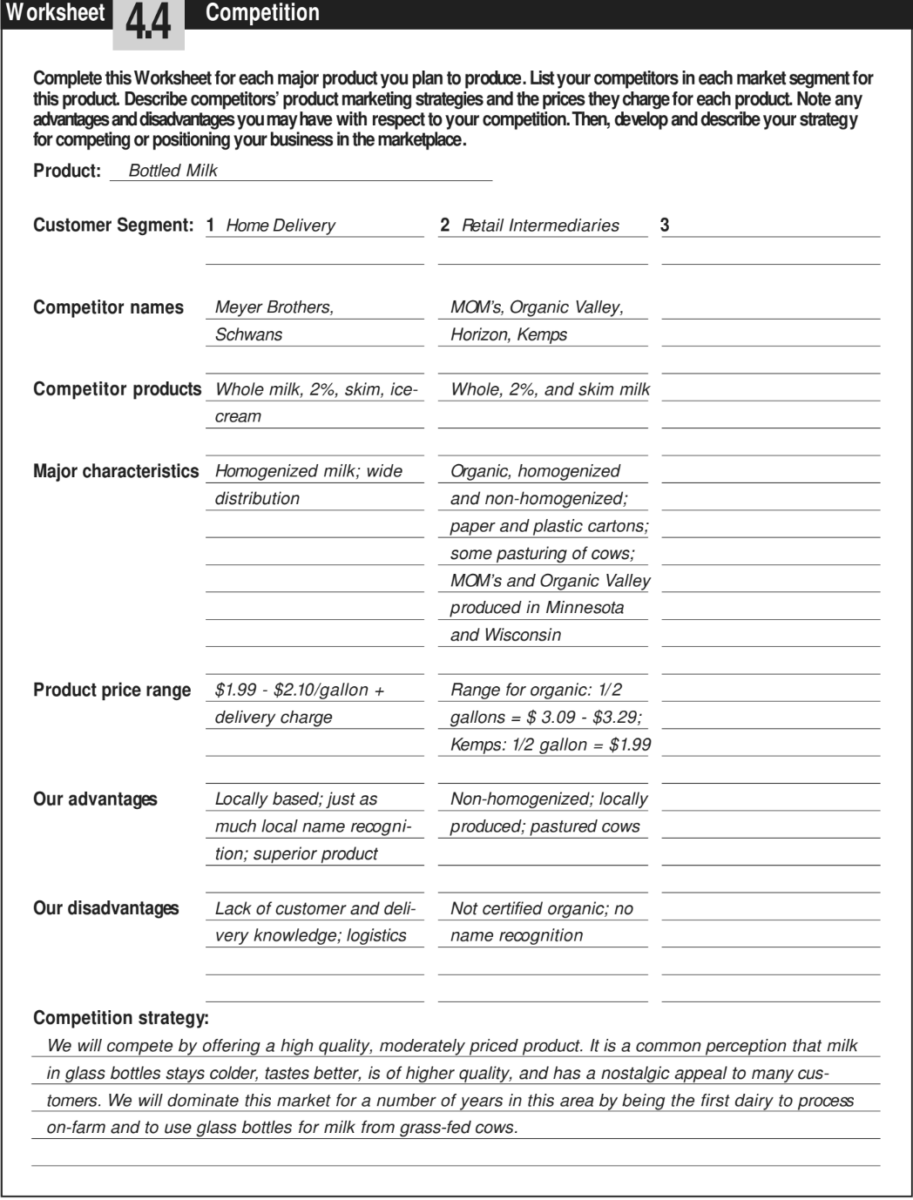
Dave and Florence Minar made phone calls to other home delivery services and visited local retailers when beginning their research. They found that “No farmer in our area is processing and selling his own dairy products. Sources of competition for home-delivered milk into New Prague are Meyer Bros. and Schwans. Meyer Bros. buys milk off the open market and resells it—they do not purchase milk locally or offer non-homogenized products. Schwans will affect us only with ice cream. Some of our competitors in the metro area cooperative groceries are Schroeders, Organic Valley
and MOM’s.”
Use Worksheet 4.4: Competition (download worksheets for task 4) to analyze the competition that exists for each of the products you plan to offer. List your competitors. Then, consider where you have an advantage over them. Can you produce at a lower cost? Do you have access to markets that they cannot reach? Are you better at working with people—at attracting and keeping customers? Do you have better business skills? In other words, what’s your niche? You may want to return to Worksheet 4.3 (Product Uniqueness) where you described your product to ask again, is our product truly unique?
Distribution and packaging: how and when will we move our product to market?
Now that you have a customer and product in mind, your next task is to identify how to move or distribute products from your farm to the customer’s dinner table, store shelves, elevator or barn. Distribution strategies typically describe scope (market reach), movement, packaging and scheduling/handling.
Scope. The first component in your distribution strategy is scope - how widely you plan to distribute your product. Will you pursue an intensive, selective or exclusive distribution strategy?
Intensive product distribution typically involves widespread placement of your product at low prices. Your aim is to saturate the entire market for your goods. This strategy can be expensive and very competitive. Large-scale manufacturers or businesses that market nationwide often employ this method.
Selective product distribution involves selecting a small number of intermediaries, usually retailers, to handle your product. For example, if you plan to produce an upscale product, such as gourmet cheese, you may want to be selective about the stores that stock your product (choosing only those retailers who offer other gourmet, high-quality products). Selective distribution offers the advantages of lower marketing costs and the ability to establish better working relationships with customers and intermediaries.
| District Marketing Distribution Alternatives | Intermediary Distribution Alternatives |
| Community Supported Agriculture (CSA) Farmers' markets Home delivery service Internet sales Pick Your Own (PYO) Mail Order Roadside Stands | Retailers Wholesalers Distributors Brokers Cooperatives |
Exclusive distribution is, in effect, an extreme version of selective distribution. In this case, you grant exclusive stocking rights to a wholesaler or retailer. You agree not to sell to another buyer. In exchange, you might demand that the retailer stock only your farm’s salad greens, milk, meat or cheese. You may work closely with a retailer to set market prices, develop promotion strategies, and establish delivery schedules. Exclusive distribution carries promotional advantages, such as the creation of a prestige image for your product, and often involves reduced marketing costs. On the other hand, exclusive distribution may mean that you sacrifice some market share for your product.
Figure 43. Direct Marketing Options
Community Supported Agriculture (CSA)
CSA organizations are similar to a cooperative in that you produce for members. CSA members purchase annual shares of production at the beginning of the year or season. In return, they receive weekly or bi-monthly deliveries of fruits, vegetables, and/or livestock products. CSA projects usually work best close to urban areas. Structures vary and decisions are usually made based on group consensus. You will need good people skills and may have to be creative to keep customers from year to year.
Farmers’ Markets
Farmers’ markets are a relatively low-cost alternative if there is one already operating in your area. You can plug right into an established market (letting it do the promotion for you) and spend most of your energies on production. Typically a full-year or a per market fee is required to reserve stall space at farmers’ markets. The downside is that you will be selling in a very competitive environment and you will not be able to set higher prices.
Mail Order and Internet Sales
Mail order and Internet sales may be a good choice if you are not close to a large urban area and if your product stores and ships well. Perishable and heavy products are not good candidates. These outlets are difficult to get started and work best if you can grow them slowly while relying on other methods for the bulk of your sales. Computerized records or high-quality Web site design are important.
Pick Your Own (PYO)
PYO marketing is a relatively low-cost marketing option. It works best for products in which ripeness is easily recognized. Often you can charge a price that is similar to that for picked produce because the consumer enjoys picking and will pay for the opportunity to do so. Disadvantages include potential damage to the produce, liability concerns, and the fact that a stretch of bad weather can dramatically reduce sales when the product is ripe. Fruit and Christmas trees are traditional examples of PYO enterprises. Fresh flowers are fast becoming a favorite PYO product.
Roadside Stands
Roadside stands require a good location and cheap labor. The most important ingredient to success is attracting repeat customers. Quality, appearance and friendly service are important. Capital requirements can be near nothing if you are in the right location, or they can be substantial if you have to rent space. Check with local authorities for legal requirements and regulations.
Movement. The most common distribution strategies or channels for moving your product to the final customer are direct marketing and intermediary marketing. Examples of each distribution alternative are listed below.
Traditionally, farmers have been positioned at the bottom of the distribution channel — offering a bulk of commodity that required further processing or packaging before it could be sold to customers. Distribution intermediaries, such as brokers and cooperatives, were seen as the only option for moving products from their farm to the final customer. However, a growing number of farmers today are doing their own processing, packaging and delivery. This adds value to their raw product and helps them to retain raw product and helps them to retain a greater share of the profit. As a result, farmers have expanded their distribution strategies to include direct marketing— selling consumer goods such as goat cheese, bundled fruit trees, or bottled milk directly to the final customer.
In filling out Worksheet 4.5: Distribution and Packaging, (download worksheets for task 4) the Minars identified two general distribution strategies for their dairy products: direct marketing (via farmers’ markets and home delivery), and intermediary sales (via traditional grocers and natural foods cooperatives). As they continued the planning process, the Minars focused their research and evaluation on the two distribution strategies with the most potential for reaching each of their market segments: home delivery to New Prague households and sales to Twin Cities Metro and New Prague retailers.
If you choose to direct market, consider the options listed in Figure 43. Think about the investment required, marketing and labor costs, pricing options, grower liability, and barriers to entry.
Service providers also distribute directly to customers. In this case, it might be from an office, via fax, or on site at the customer’s home or business.
While direct sales can be a profitable strategy for the individual grower, they generally make up only a small portion of total sales and can be costly in terms of time. You often take on wholesaler responsibilities such as grading and packing when direct marketing. The majority of consumer goods reach grocery stores or restaurants through some type of intermediary. Intermediaries are businesses that help buy, sell, assemble, store, display and promote your products; they can help you move your product through the distribution channel. Intermediaries include retailers, wholesalers, distributors, brokers and cooperatives. The advantages and disadvantages of distributing through well-known intermediaries are briefly described below.
If your distribution strategy includes sales to retailers or wholesalers, you will need to conduct substantial research. A recent study by the Center for Integrated Agricultural Systems indicated that Minnesota and Wisconsin retailers are very interested in purchasing and stocking local produce. However, they are often unwilling to do so because of inconsistent product quality. “Consistent quality means a predictable product for customers. . . When it comes to quality, many buyers want it all—produce that is shaped and sized consistently and of uniform ripeness and flavor; something they can get from California growers.” The study also identified six basic tips for approaching or selling to retail buyers, listed in Figure 45.
Figure 45. Recommendations for Approaching Retail Buyer
Become knowledgable about the market by talking with farmers selling to retail stores. Try to find out individual buyers’ expectations of volumes and prices to see if they match your situation before approaching the buyer.
Prepare an availability sheet listing products and prices. Make it neat and well-organized. Make sure there will be enough produce available to back up what is listed.
Send the availability sheet to buyer whose expectations best match what you have to offer. Buyers often prefer to see this sheet before they talk to a producer. You can fix it to the buyers office.
Project a professional image through a growers' manager or representative. This person should be well-informed about production, supply, produce condition, and be confident in the business' ability to meet the buyers' needs.
Work out the details of the sale with the buyer, such as volume, size, price, delivery dates and labeling requirements. Some buyers have a set of written requirements for growers.
Keep in touch with the buyer. Growers need to keep the buyer informed about potential problems so that buyers can look elsewhere for a product if there is a supply problem.
Similarly, wholesale outlets can be difficult to access. Many of the same retail marketing principles apply to the wholesale market. You will need to concentrate as much management on grading and packing as on production. Lastly, and perhaps most importantly, you will need to prove to your buyer that you are a dependable and consistent source of high-quality product.
If one of your distribution alternatives includes the wholesale market, you may want to begin your research by contacting local grocers and restaurants to find out who supplies their produce and other food products. Lakewinds Natural Foods in Minnesota, for instance, purchases approximately 90 percent of its food items from regional wholesale distributors such as the Wedge’s Cooperative Partners Warehouse, Roots and Fruits Cooperative Produce, Blooming Prairie Natural Foods, and Metro Produce.24 Next, contact the wholesaler. Find out their grading, packaging and delivery requirements. If they seem like a good fit—and if the prices they offer are financially acceptable—try selling yourself to them.
There are a number of resources available to help you identify and reach intermediaries. One of the best resources is the Cooperative Grocer On-line. This site offers links to retailers, such as cooperative grocers, as well as other intermediaries, such as manufacturing cooperatives, wholesalers and distributors.
Packaging. Product or service packaging can be both functional and promotional—serving to preserve your product for shipment and, in the case of final consumer goods, to advertise and differentiate your product.
As a producer of bulk commodities, your packaging strategy may seem fairly straightforward since little or no packaging may be involved. However, if you are planning to produce specialty commodities, such as organic grains, be aware that strict industry “packaging” standards may exist.
Packaging final consumer goods for the retail market, on the other hand, can be a daunting yet exciting task. Examples of product packaging include individual product cartons, boxes and containers; bulk shipping containers; delivery vehicles; and even retail display cases for mass product packaging.
Service packaging examples include business cards, invoices, landscaping, building design, signage, brochures and vehicles.
As a producer of consumer products, you may want to begin your research at the supermarket or grocery store. Make note of how similar products are packaged and labeled. There are many rules and regulations governing food packaging and labeling. In general, any product packaged for the retail market must include a description of the common product name, net weight, nutrition facts, ingredients and your business address. All products must meet federal regulations. However, you should also contact your state’s food inspection department for more details, since state guidelines may be stricter than federal guidelines. [In Minnesota, see the MDA’s Food Labeling Fact Sheet. The Agricultural Utilization Research Institute (AURI) also provides technical assistance for the development of nutrition labels (see “Resources”, p. 249)].
Finally, as a service provider, think about what your customers will see, hear and smell when visiting your farm or communicating with you and your staff. Northwind Nursery and Orchard owner Frank Foltz laid out the following plan for “packaging” the service component of his business:
“The sales room for nursery stock and fruit will be decorated with a country theme and include locally crafted items useful for gardening, orcharding and homesteading purposes. We will avoid all but the very highest quality products. Staff will be friendly and knowledgeable in all aspects of fruit growing and orcharding. The property will be developed in a free-flowing, park-like fashion with an interspersion of fruit trees and edible landscaping plants that will elevate our customers from the simple act of buying fruit or nursery stock to that of experiencing our natural environment at its best. This arboretum-type setting will provide customers with the opportunity to take a ‘fruit walk’ to sample many different fruit cultivars in season and subsequently purchase more fruit, or the nursery stock to grow their own.”
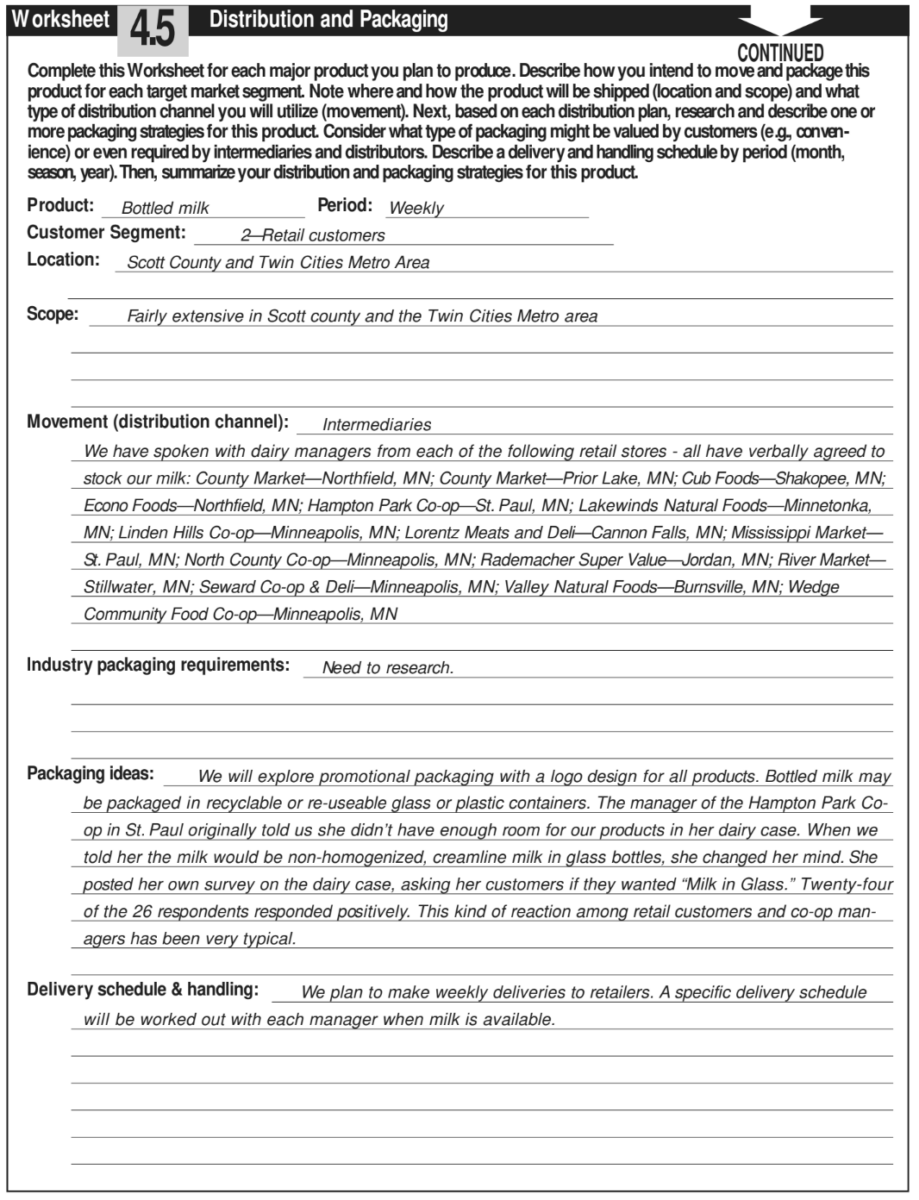
As you think about what type of packaging is best suited to your product, don’t overlook customer needs, such as convenience, and intermediary requirements. Restaurant owners and cooperative grocery managers will likely have minimal packaging requirements that affect how you clean, bundle and grade your product. Lakewinds Natural Foods General Manager Kris Nelson says produce farmers, in particular, must compete with major distributors and therefore deliver a professionally packaged product. “Kale and other greens come to us from farmers already cleaned and bundled,” Nelson says. “They are dropped off at the store in packaging that is similar to what we see from commercial distributors.” 25 If you plan to market to retailers and other intermediaries, research their packaging requirements and think realistically about your ability to meet industry standards.
Your values and goals, as well as target market preferences, will also affect packaging choices. The Minars, for instance, envisioned marketing to customers “who value old-fashioned taste.” As a result, one of their distribution strategies was to package their milk in old-fashioned, returnable, glass bottles. “It is a common perception that milk in glass bottles stays colder, tastes better, is of higher quality, and has a nostalgic appeal to many customers,” they say in their business plan. By packaging in glass bottles, the Minars were also able to satisfy one of their environmental values—namely, to minimize their impact on the land through reuseable packaging.
Delivery scheduling and handling.
Your distribution strategy should also take into account how often you will need to make deliveries, either to satisfy customer demand or to fill intermediary requirements. What type of delivery schedule will be necessary? If you offer a perishable product, delivery schedules will be critical. The Minars spoke with retailers to research delivery conditions, such as the handling of returnable bottles, and a delivery schedule. Moreover, if you are marketing through an intermediary, your ability to meet delivery commitments may determine their continued business. “Retail buyers rely on delivery at the promised time so they know how much may need to be supplemented to meet demand and so they can schedule workers to handle delivery and display.” As you develop a delivery schedule, be aware of peak production periods (if your business is seasonal) as well as industry handling requirements. Organic producers are required, in most cases, to verify that organic grains were handled (cleaned, stored and transported) in accordance with organic standards.
Use Worksheet 4.5: Distribution and Packaging (download worksheets for task 4) to develop and describe your overall distribution strategy or strategies. The decisions you make here will affect your future workload and consequently, your human resources strategy.
Pricing: how will we price our product?
Farmers are all too familiar with the challenges of pricing bulk commodities for profit. As price takers, low market prices are often the number one reason traditional commodity producers find themselves sitting down to develop a business plan. Today’s producers, whether they are adding value or marketing a specialty commodity, have a greater ability to influence price in these highly defined markets. Depending on your goals, vision, target market, and product strategy, you may want to consider one or more pricing strategies for undifferentiated (traditional) commodities and differentiated (value-added, specialty) products.
In general, pricing strategies are based on two factors: prevailing market prices and your costs. In the long run, your price has to cover your full costs—including production, marketing and promotion—as well as a return for your time and investment. You will have the opportunity to crunch these numbers later when you evaluate the strategy you are currently developing.
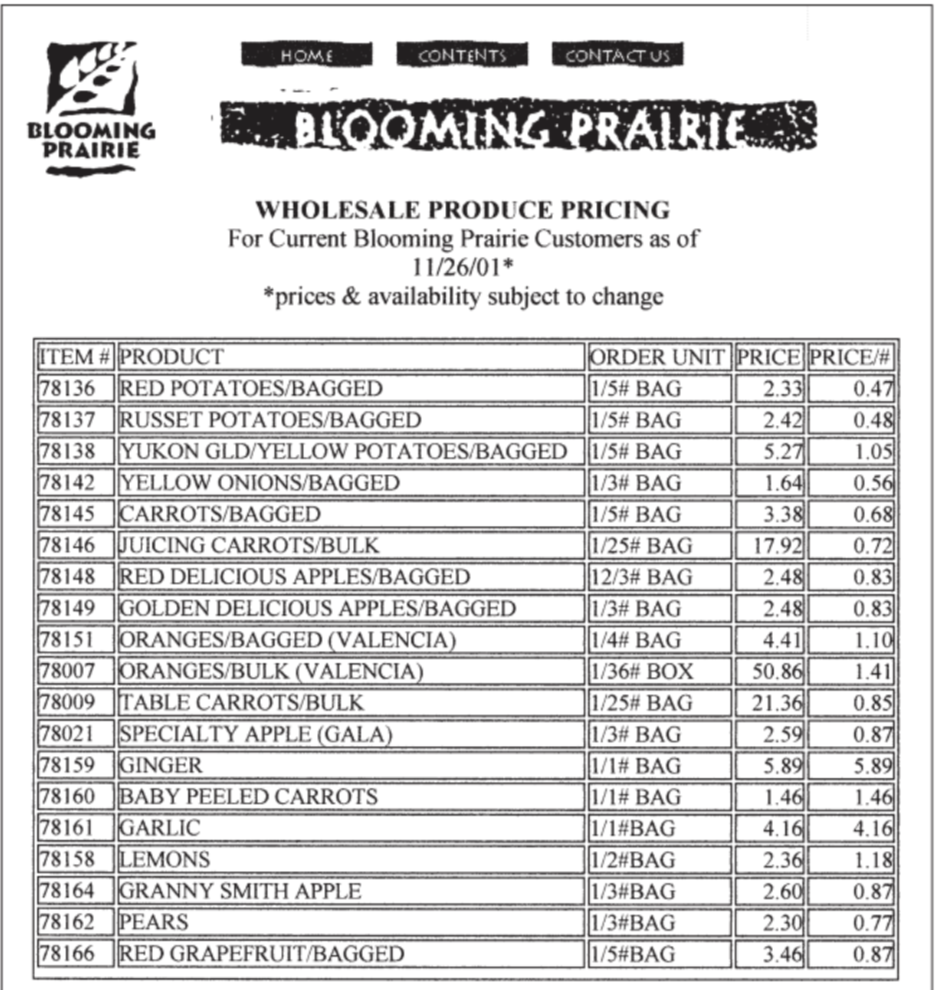
For now, begin developing a pricing strategy around prevailing market prices for similar products if they exist. Learn about what customers are willing to pay and what prices your competitors charge. Begin your research by listing competitor prices for similar products—note any seasonal pricing changes, premiums and discounts offered by intermediaries (brokers, grain companies, processors, retail groceries, etc.). Check with your state Department of Agriculture, or your University Extension Service for a list of current market prices for traditional commodities, such as livestock and forages. Specialty commodity prices may be difficult to locate or only available for a fairly substantial fee. Markets for organics, non-GMOs, and other specialty commodities, such as lentils, are relatively immature and little information is available. Therefore, you will have to do a little digging when searching for historic, current, and projected market prices. In general, a good source for alternative product prices, including organics, is the Internet. Food cooperatives, like Blooming Prairie, list weekly wholesale prices for produce. Retail prices for a range of processed dairy and grain products, fresh produce, flowers, herbs and spices often are available on individual company Web sites. Moreover, the Appropriate Technology Transfer for Rural Areas (ATTRA) has compiled a listing of relatively low-cost organic market price and industry research called Resources for Organic Marketing (see “Resources”). If you have Internet access or are willing to make a few phone calls, your market price research needn’t take long.
Once you are familiar with prevailing market prices and your costs of production, you are ready to begin developing a pricing strategy. There are a variety of strategies to consider depending on your ability to set prices. Common pricing strategies for differentiated (value-added or specialty) commodities including consumer goods and services (with relatively high price setting ability) are discussed in Figure 48.
If you are a small or mid-sized producer selling in a local market, be careful not to place too much emphasis on price competition. You will likely have better results competing based on quality, value added and communications. Still, you need to think about how to price your commodity or product.
One common product pricing approach, skim pricing, is to establish a relatively high market entry price to recover costs before lowering the price to expand the customer base. This practice, however, can attract more competition if your prices remain too high for too long. The alternative is penetration pricing. Similar to promotional pricing, you initially set a product price below your intended long-term price to secure market acceptance of your product. The advantage of penetration pricing is that it will not attract competition. When selecting a pricing strategy for differentiated commodities, products or services, take a peek at the options listed in Figure 48.
Figure 48.
Differentiated Product Pricing Strategies
Competitive pricing. Competitive pricing strategies are common among large manufacturers and are aimed at undermining competition. Predatory pricing, where a company sets its price below cost to force its competitors out of the market, is a typical competitive pricing strategy. Although these strategies may work well for large commercial companies, they are not recommended for small scale, independent businesses. Price wars are not easily won. That said, the food industry is considered a “mature” marketplace and your ability to compete on the basis of price may be very important. There are several well-capitalized players, even in the organic market, offering similar services.
Cost-oriented pricing. The cost-oriented pricing strategy is probably the most straightforward. Based on your production costs, you and your planning team make a subjective decision about whether to price your product at 10 percent, 50 percent, or 100 percent above current costs. Of course, you will need to conduct marketing research to determine whether or not your customers are willing to pay the cost-plus price that you have established.
Flexible or variable pricing. Flexible pricing strategies involve setting a range of prices for your product. Flexible pricing is common when individual bargaining takes place. The prices that you set may vary according to the individual buyer, time of year, or time of day. For instance, farmers who sell perishable fruits, vegetables and herbs at farmers’ markets often establish one price for their products in early morning and by day-end are willing to lower their prices to move any excess product.
Penetration or promotional pricing. A penetration pricing strategy involves initially setting your product price below your intended long-term price to help penetrate the market. The advantage of penetration pricing is that it will not attract competition. Before pursuing a penetration pricing strategy, you should thoroughly research prevailing market prices and crunch some numbers to determine just how long you can sustain a below-cost penetration price. Penetration or promotional pricing usually takes place at the retail level when marketing direct to your product’s final consumers.
Product line pricing. If you plan to market a line of products, you might consider a product line pricing strategy where a limited range of prices is established for all of the products that you will offer. For instance, if you envision marketing to low-income customers, then your price line or price range must be based on “affordability.” In this case, you might establish an upper limit or ceiling for prices so that your price line is bounded by your production costs on one end and an affordable ceiling on the other end.
Relative pricing. Relative pricing strategies involve setting your price above, below or at the prevailing market price. Clearly, this strategy requires that you research the prevailing market price for your product.
Skimming or skim pricing. The price skimming strategy is based on the idea that you can set a high market entry price to recover costs quickly (to “skim the cream off the top”) before lowering your price to what you intend as the long-term price. This pricing strategy is possible only when you have few or no competitors. The primary disadvantage of the skimming strategy is that it attracts competition. Once competitors enter the market, you may be forced to match their lower prices.
Contract pricing for specialty commodities. Contracts for specialty commodities vary dramatically in terms of the price paid, payment conditions, grower responsibilities, storage and shipping arrangements. The advantage of pricing on contract is that you know in advance what price will be paid for the commodity. Be aware, however, that when producing a specialty variety crop or when employing a new production management system, your yield and output risk increases as does your exposure to quality discounts. Use a contract checklist if you are considering this method of pricing for specialty crops or livestock.
Common pricing strategies for undifferentiated (raw) commodities (with low price setting ability) are discussed in Figure 49. Traditional commodity pricing strategies also have their advantages and disadvantages as described in Figure 49. When considering each of the commodity pricing strategies, remember that there are many factors that can affect your overall market price strategy, such as storage capacity, cash flow and taxes. Whatever type of pricing strategy you choose, think through your rationale. Are you trying to undermine the competition by offering a lower price? Set a high price that reflects your quality image or market demand as is the present case with organic products? Are you simply looking to cover costs and reduce volatility?
The Minars identified two pricing strategies for bottled milk (relative and cost-based pricing) to help place their product in retail and wholesale markets. By introducing new customers to Cedar Summit Creamery’s “old fashioned” bottled milk at a price well below that of organic milk, the Minars hoped to encourage quality and health conscious shoppers to try their product. The Minars’ break-even analysis in the evaluation step of this Planning Task helped them determine whether or not a relative or cost-oriented pricing strategy would be financially feasible.
Use Worksheet 4.6: Pricing (download worksheets for task 4) to develop your pricing strategy for each product. Begin by recording research about competitor’s prices.
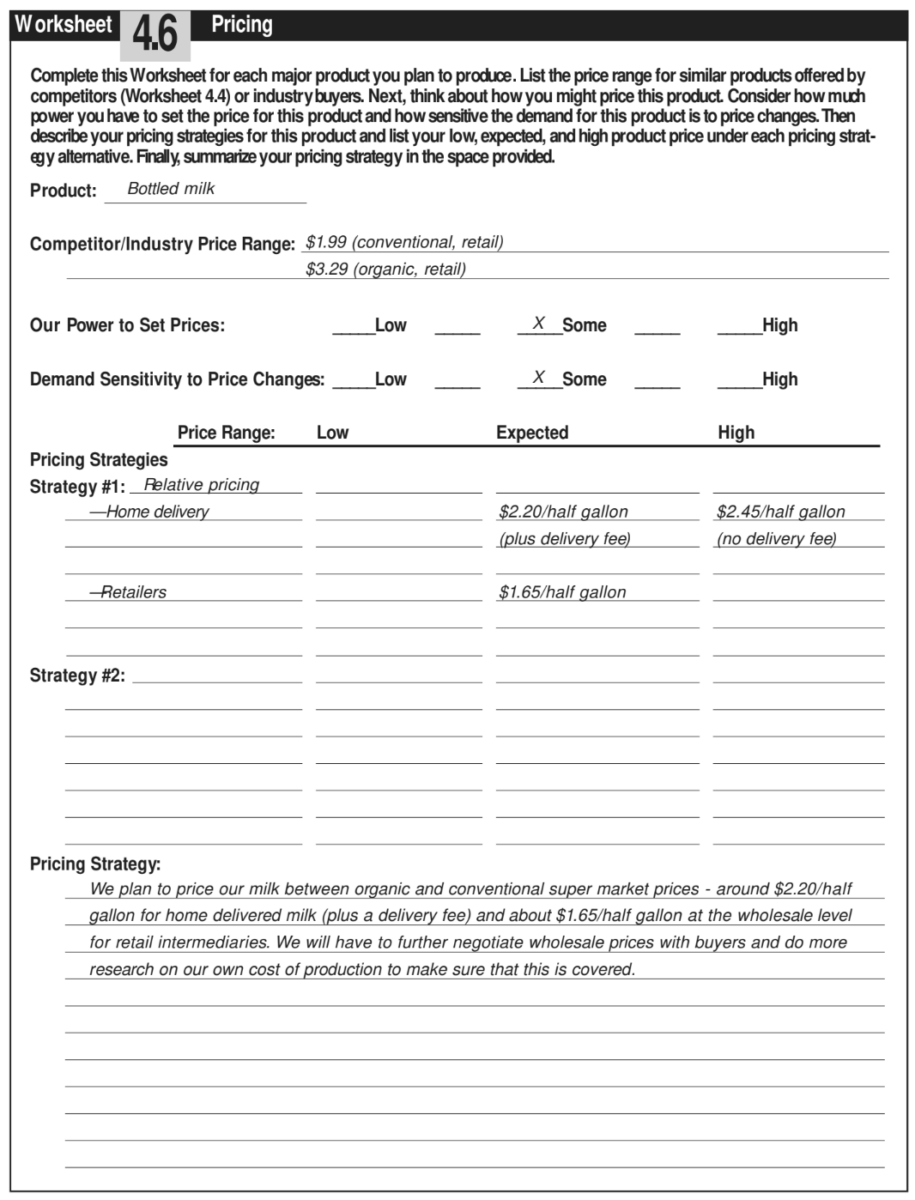
Figure 51.
Common Pricing Mistakes
Marketing author Michael O’Donnell outlines the following common “mistakes” to be aware of when building a market price strategy.
- Pricing too high relative to customers’ existing value perceptions; prices not in line with target market needs, desires or ability to pay.
- Failing to adjust prices from one area to another based upon fluctuating costs and the customer’s willingness and ability to pay from one market to another.
- Attempting to compete on price alone
- Failing to test different price levels on customers, from one area or market to another
promotion: How and what will we communicate to our buyers or customers?
Promotion is a must if you are going to gain product recognition among customers. Promotional strategies often are built around a “message.” The message that you deliver about your product or business is just as important as the product itself. Equally important is how and when you deliver that message through the use of advertising tools and media.
Image or product. Before beginning detailed promotions research, think about an overall strategy approach. Will you concentrate promotions on your business image, the product, or both (total approach)?
Businesses use brand or image advertising to build awareness and interest in their products. A brand is represented by a name, term, sign, symbol, design or some combination. A brand or logo is used to identify the products of your business and to distinguish them from other competitors. Although the establishment of a brand can be expensive, particularly for small businesses, many of today’s alternative farm businesses are concentrating their promotional efforts on image advertising—promoting the concept of “healthy” or “locally produced” or “eco-friendly” products.
The Minars plan to promote Cedar Summit Farm products through the use of a new label and logo design that will appear on all products and in their brochure. They hired a family artist to develop a variety of logos that would communicate their overriding values and new business mission statement.
Product advertising aims to create immediate sales through some type of special product offer, such as seasonal discounts, frequent buyer clubs, and in-store samples. For instance, Northwind Nursery and Orchard owner Frank Foltz developed a three-pronged product strategy to: “(1) Make use of excess products by distributing them as advertising samples—we will give it to customers who can use it. They will repay us many times over in ‘word of mouth’ advertising; (2) Give our customer discounts for bringing in other customers or distributing our literature, etc. . . . Give those who organize group orders a bonus; and (3) Reward loyal customers with extra services that will help them succeed.”
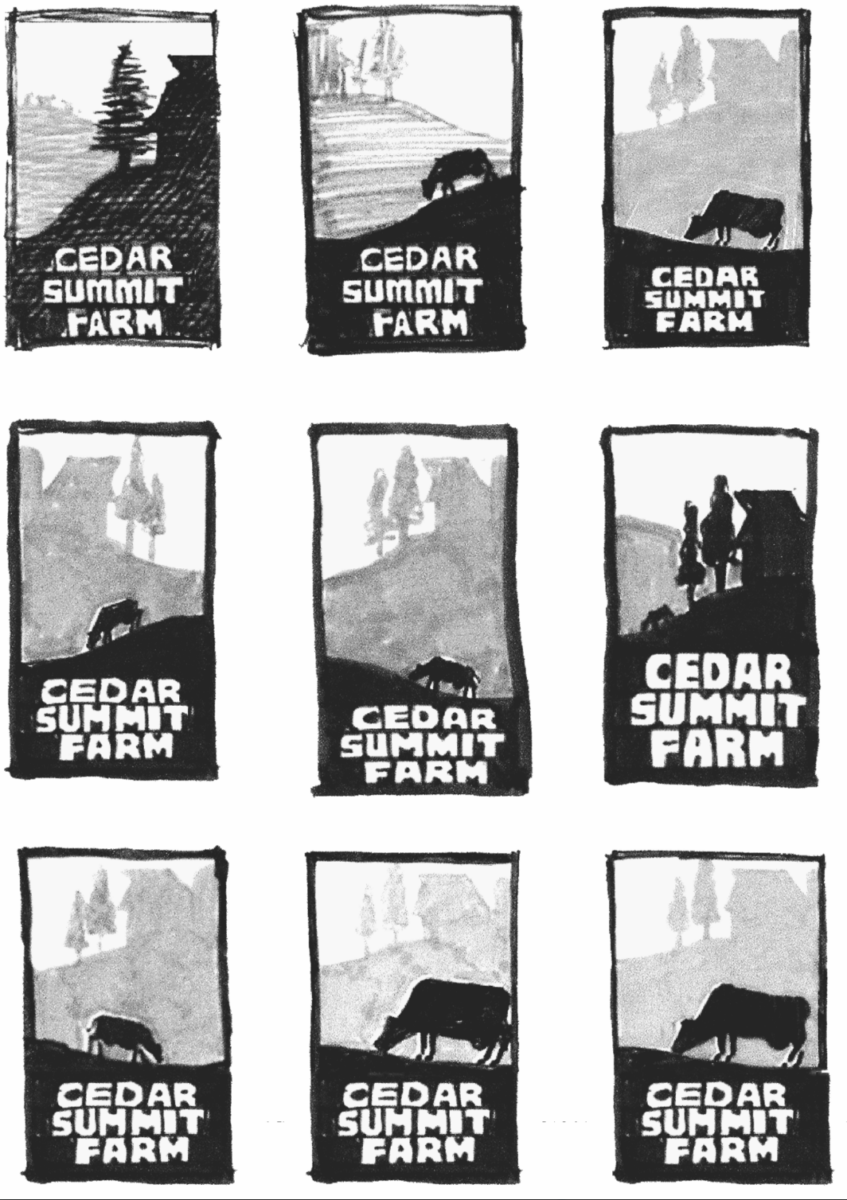
Promotion Strategy
Your promotion strategy should include a promotional method, specific promotional tools, and your ideas for actual promotion or delivery.
Message: What do I want my customers to know about my product?
Tools and Delivery: What will I use to communicate my message?
Timing and Frequency: How often will I contact my customers via advertising and communications?
Costs: How much will my advertising and communication cost?
Product promotion aims to increase sales directly and immediately for an advertised product. Here are several low-cost product promotion alternatives.
- Coupons and rebates
- Tasting and cooking demonstrations
- Frequent buyer clubs
- Publicity
- Samples
- Recipes
While most small businesses opt for product advertising because it offers more immediate returns, marketing consultant Barbara Findlay Schenck recommends combining both image and product promotion strategies. She calls this promotional strategy total approach advertising. Total approach advertising offers direct farm marketers a chance to build a long-term image of their business and its values while encouraging timely product purchases.
Dancing Winds Farm owner Mary Doerr, for example, promotes the image of her business with flyers that read “Dancing Winds Farm is a small farm enterprise using sustainable agriculture practices” as well as her business’ product by offering free cheese samples and recipes at the St. Paul Farmers’ market every other weekend.
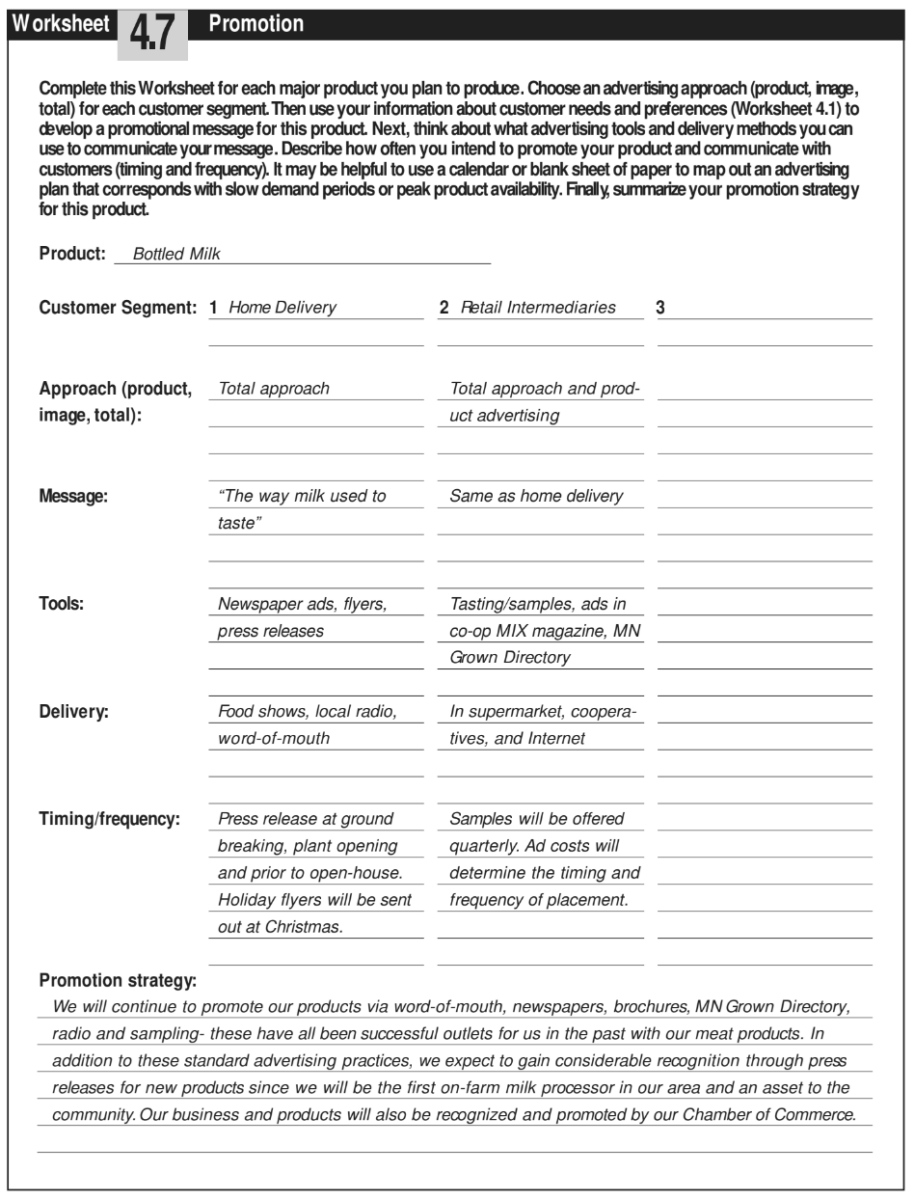
Use Worksheet 4.7: Promotion (download worksheets for task 4) to describe your general promotions strategy. Next, with a broad strategy approach in mind, begin sketching out the particulars of your advertising message, tools, delivery and schedule.
Message. Advertising messages can be fun, serious, or factual. They can describe business values, the product itself, production practices, prices, or the volume available for sale.
If you intend to use a product promotion strategy, your message can describe the unique characteristics of your product or a special offer. On the other hand, if your
strategy is centered on image promotion, your message should paint a clear picture of what you want your business to be known for among customers. Return to your Business Mission Statement (Worksheet 3.2), in which you first answered this
question; it is a good place to start formulating your promotional message. Either way, if you plan to produce a retail product, try to keep your messages short so that it can be incorporated into product packaging.
Take a look at the following image and product-related messages advertised by several well-known Midwest retail food suppliers:
“Our organic products are not only good for the earth, but for you and your family too! Together we can change the world—one organic acre at a time” —Horizon Organic
“Bob’s Red Mill is dedicated to the manufacturing of natural foods in the
natural way . . . We stone grind all common and most uncommon grains into
flours and meals on our one-hundred-year-old mills . . . Our product line of natural
whole grain foods [is]the most complete in the industry” —Bob’s Red Mill
“Applegate Farms is working to improve the meat Americans eat . . . All of our products are gluten-free, contain low or no carbohydrates, are lower in fat than other major brands and free of all taste or texture enhancers” —Applegate Farms

Research other business messages online, in advertisements, or at the grocery store.
Tools and delivery. Frank Foltz, owner of Northwind Nursery and Orchards, promotes his business’ products using a range of promotional tools, including fact sheets that are distributed at farmers’ markets and educational on-farm displays. “Quality products and knowledgeable, personal service along with a series of informative fact sheets on fruit growing culture and problems are an integral part of our catalog sales strategy,” says Frank. “Those, along with on-farm learning opportunities, community activities and cultural events are the back-bone of our local promotions efforts.”
The Foltzes’ experience suggests that educational fact sheets are one of the best ways to reach their target market customer—individuals interested in learning more about backyard orcharding and edible landscaping.
Promotion or advertising tools typically include display ads, billboards, yellow pages, mailings, flyers and catalogues. Your state Department of
Agriculture likely has a program promoting locally grown products. The Minnesota Grown Directory is an excellent advertising resource for farmers in Minnesota and Wisconsin who have seasonal and year-round products to sell. Minnesota Grown program participants, like the Minars, are listed in an annual directory and receive permission to use the trademarked Minnesota Grown logo.
Every advertising tool has its advantages and disadvantages. Think about which tools will help you best reach your target market. Once you’ve developed a list of potential advertising tools, think about where you will deliver or distribute your promotional message. Trade shows, farmers’ markets, county fairs, radio, television, and the Internet are just a few promotional delivery options. Be sure to brainstorm with your planning team. Identify creative, low-cost, effective ways to get the word out. You might consider a word-of-mouth campaign or a strategic alliance with another farmer.
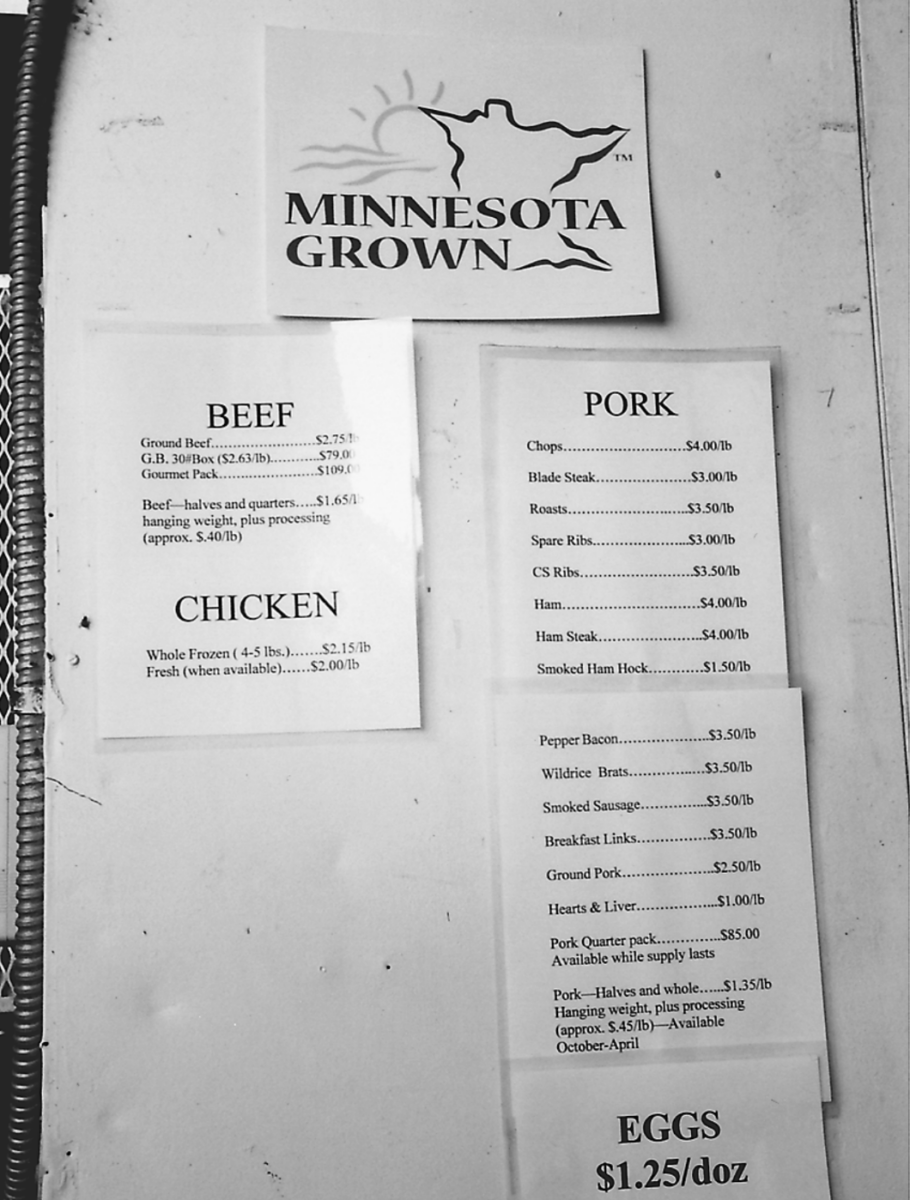
Mary Doerr of Dancing Winds Farm linked up with a nearby Community Supported Agriculture (CSA) business owner to offer “cheese shares” in its CSA brochure. The Minars negotiated a verbal agreement with a meat producer in West Central Minnesota to market Cedar Summit Farm milk products to that producer’s existing direct market customers. That agreement would allow the Minars to promote their milk products beyond South Central Minnesota and gradually increase the size of their target market.
Timing and frequency. Promotional strategies should include a plan for timed delivery or an advertising schedule that describes how often you will communicate with customers to follow- up on a sale, inform them of holiday specials (see Figure 56), or let them know about new products and prices. Regular communication is a way to build and preserve your market.
Frank Foltz of Northwind Nursery and Orchards maintains regular contact with customers by informing them about new orchard research and varieties. How will you advertise and maintain contact with your customers? Through regular personal contact, periodic promotional mailings, or a holiday mailer? It may be helpful to develop a calendar for promotional “events” to help time promotions with seasonal demand or peak production periods. This will also help you plan for advertising expense outlays when developing your cash flow plan as you evaluate your proposed strategy later in this Planning Task.
A series of interviews with Minnesota and Wisconsin retail buyers found that farmers who communicated regularly with buyers regarding deliveries and product availability were more successful at maintaining these customers. When communicating with intermediaries, it is a good idea to appoint a single representative to deal with the buyers so that a personal relationship can be built. This person should be knowledgeable about your business’ products and able to negotiate with buyers.
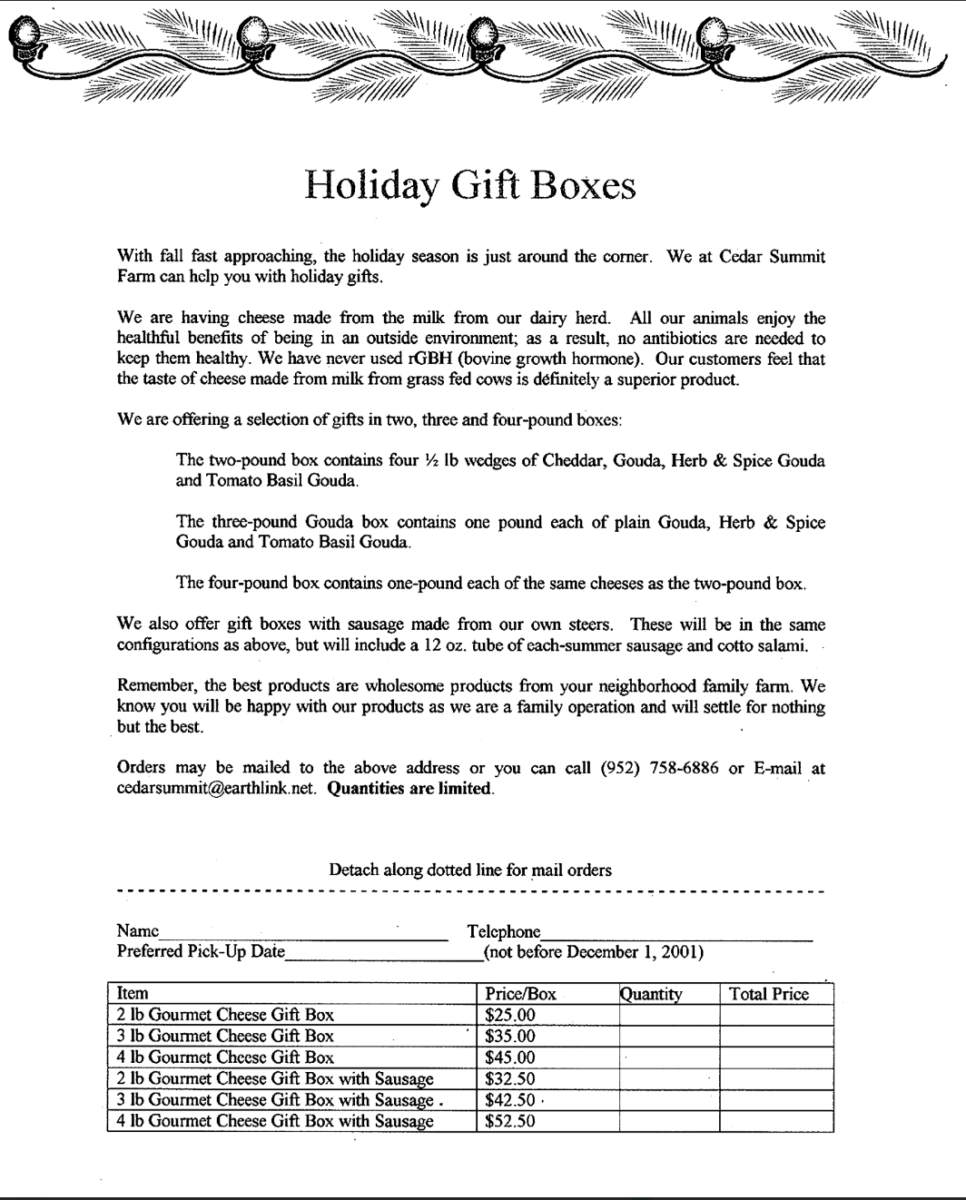
Your communication strategy might also incorporate feedback elements to obtain information from customers. Frank Foltz describes this strategy
approach best in his business plan: “We will treat our customers as an extension of our research and development departments. Their problems and complaints about our products can help us eliminate future production problems and their suggestions may be as helpful as any hired consultant. We will listen attentively to their concerns, dealing with problems immediately and always give the customer the benefit of the doubt.”
Regardless of the promotional strategy you pursue, you and your planning team will need to be creative to catch the attention of your customers and stretch your advertising dollars. Promotion, though seemingly overwhelming, should be fun.
Return to Worksheet 4.7: Promotion (download worksheets for task 4) to sketch a promotional strategy and advertising plan for each of your products. Think about your values and goals as well as your target market, product and potential competition. Like the Minars, be sure to detail your overall promotional strategy, message, advertising tools, delivery ideas and communication plans.
inventory and storage management: How will we store inventory and maintain product quality?
Storage and inventory management are integral and important parts any business strategy, affecting product quality, marketing opportunities, and the business’ legal standing. While this may seem to be more of an operations issue, many marketing strategies may depend on whether or how long you can store your product.
What role will inventory and storage management play in your business? Like traditional grain producers who use storage as a way to mitigate seasonal price declines, Riverbend Farm owner Greg Reynolds devoted a substantial portion of his operations research toward the development of a low-cost storage system for organic vegetables. He sought to preserve his produce and prolong his marketing season.
You might shape your storage strategy around marketing or to satisfy regulatory considerations. Certified organic producers, for example, must maintain detailed storage and harvest records in order to market their crops. Similarly, in accordance with the USDA Pasteurized Milk Ordinance and the Minnesota Department of Agriculture Food Handlers License/Processing Plant Permit, the Minars are required to test all milk transported to Cedar Summit Creamery for traces of antibiotics, bacteria and proper pasteurization once it has undergone this process. According to Worksheet 4.8, Cedar Summit Creamery will house a testing lab and storage cooler on-site to assure the quality of milk and preserve bottled milk, cheese, sour cream, butter and ice-cream products.
Think about your storage and inventory management objectives, then research your options and use Worksheet 4.8: Storage and Inventory (download worksheets for task 4) to describe this piece of your marketing strategy.
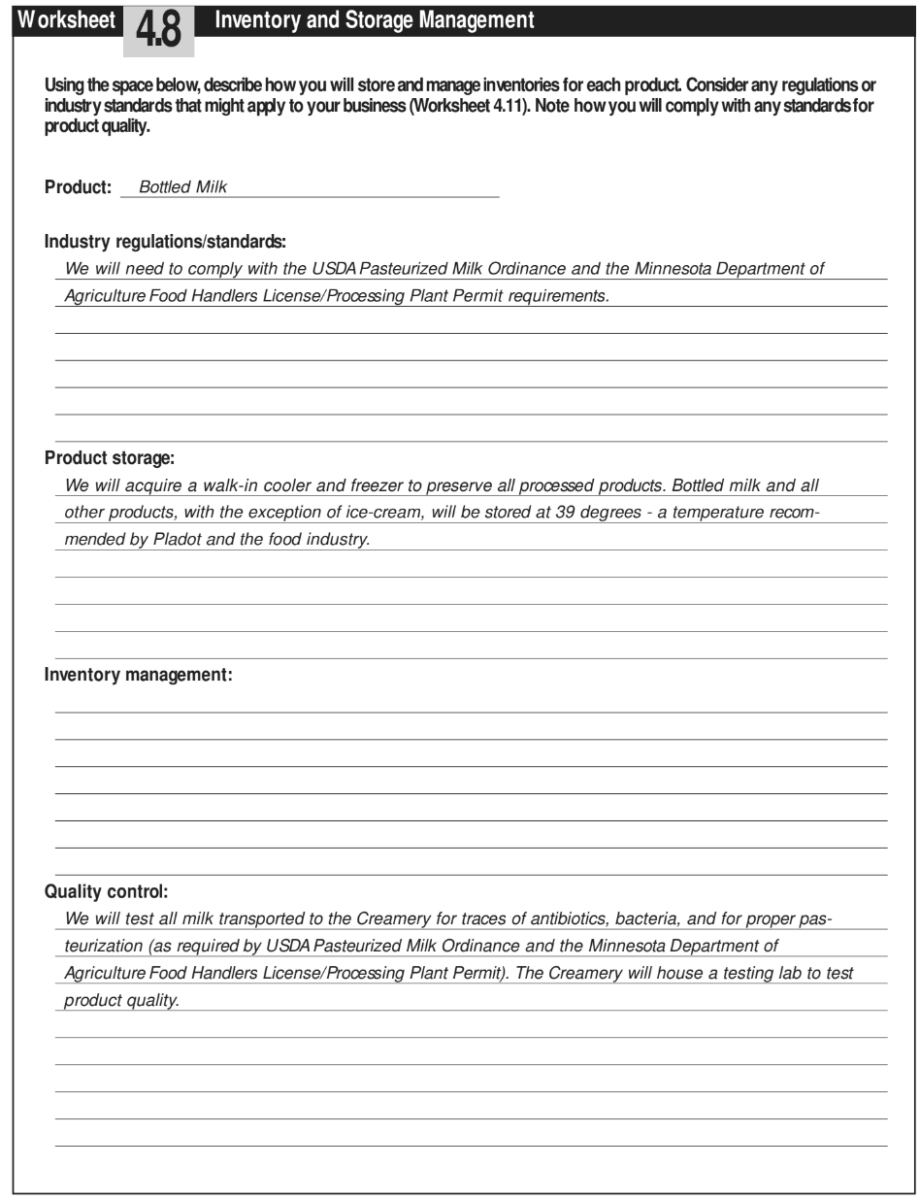
Develop a Strategic Marketing Plan.
Think about how all of your individual product marketing ideas (product, distribution, pricing and promotion) can fit together into one or more general marketing strategies for the whole farm. Use Worksheet 4.9: Marketing Strategy Summary (download worksheets for task 4)to summarize your marketing research and strategies for each product and to note how these strategies and external conditions (such as competition) may change throughout your transition or start-up period. Then think about how individual product strategies fit together into one, whole-farm marketing plan. This is the time to refine your initial product strategies if necessary to incorporate new information.
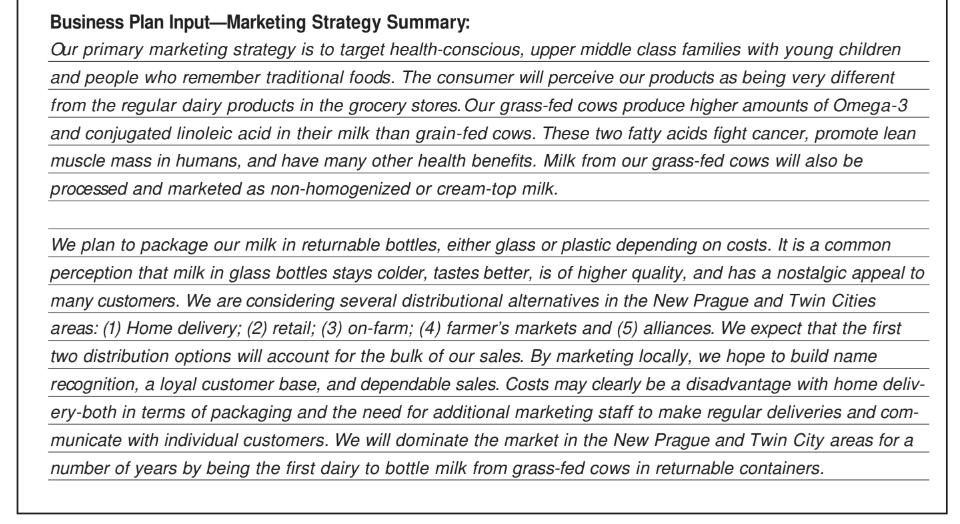
The Minars completed the Marketing Strategy Summary Worksheet 4.9 for each product in their proposed cream-top product line. An excerpt from their Worksheet for bottled milk—in which they identified several pricing, distribution and packaging strategy alternative —is shown above. Note that they still had a lot of details to work out, such as expenses associated with glass versus plastic milk cartons and the economic feasibility of on-farm sales and collaborative marketing efforts. But the beginnings of a very strong marketing plan were in place.
If you haven’t already done so, take time now to complete Worksheets 4.1—4.8 for each product that you plan to market. Refine your target market, if necessary, based on your research. Do this together with your planning team. Next, using Worksheet 4.9: Marketing Strategy Summary, briefly describe your distribution, packaging, pricing, and promotion strategies for each product and begin gathering expense estimates. Then summarize your product strategies into a whole farm strategic plan. Note any strengths, weaknesses, opportunities and threats (SWOT) associated with each general marketing plan, listing supporting evidence from your research.
Operations Strategy
With a clear idea of who will buy your product and why, the next planning question you must answer is: How will we produce it? A detailed operations strategy—one that is clear to all involved in the operation—is necessaryfor sound management and is sometimes an institutional necessity. Organic producers, for example, are required to submit a detailed farm management plan when seeking certification each year. According to certification guidelines, the plan must describe all resource management strategies directed at improving soil fertility; controlling weeds, pests and disease; managing manure; and limiting erosion.
In this section you will have the chance to develop a production management and operations strategy by answering questions about:
- Production Management: What production/management alternatives will we
consider? How will we produce? - Regulation and Policy: What institutional requirements exist?
- Resource Needs: What are our future physical resource needs?
- Gaps: How will we fill physical resource gaps?
- Size and capacity: How much can we produce?
- Storage and Inventory Management: How will we store inventory and maintain product quality?
production and management: How will we produce?
All operations strategies begin with a detailed description of the business’ production (management) system and a production schedule. As a current producer, you may have very clear ideas about how you would like to produce, what management system to use and resource requirements. If so, this portion of the planning process may be a welcome break from the research that was necessary to learn about your customers and competition in the previous section. If you
are a beginning farmer, however, you may find that this component of the planning process is just as research-intensive. Take your time, and, most importantly, talk with other experienced farmers when fleshing out the details of your production system and production schedule.
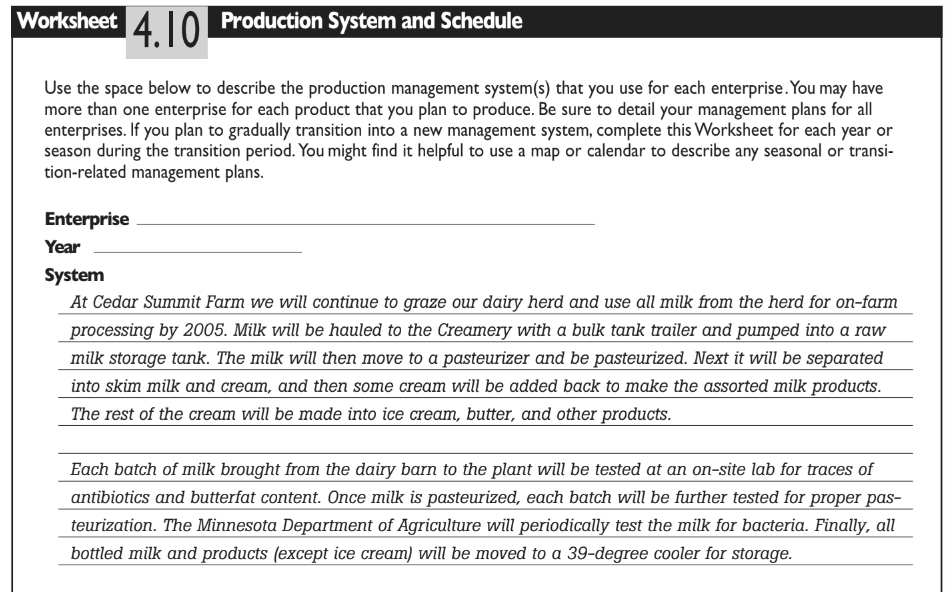
Production system. Before making their decision to process, the Minars traveled thousands of miles to Maryland, Virginia and West Virginia to visit four other farmer-owned milk processing plants. Each of the plants was similar in size to the Minars’ proposed operation. They processed with “Mini- Dairy” equipment from an Israeli-based company called Pladot. By visiting the plants, observing production, and talking first-hand with plant owners, Dave and Florence feel they gained invaluable insights that helped them with decisions about plant construction, equipment purchases and marketing.
Your choice of production system will be heavily influenced by your social, environmental and community values. This might be a good time to revisit your values and goals, and to recall your objectives for the whole farm. Each production system carries with it different resource requirements, production outcomes, labor demands and natural resource implications.
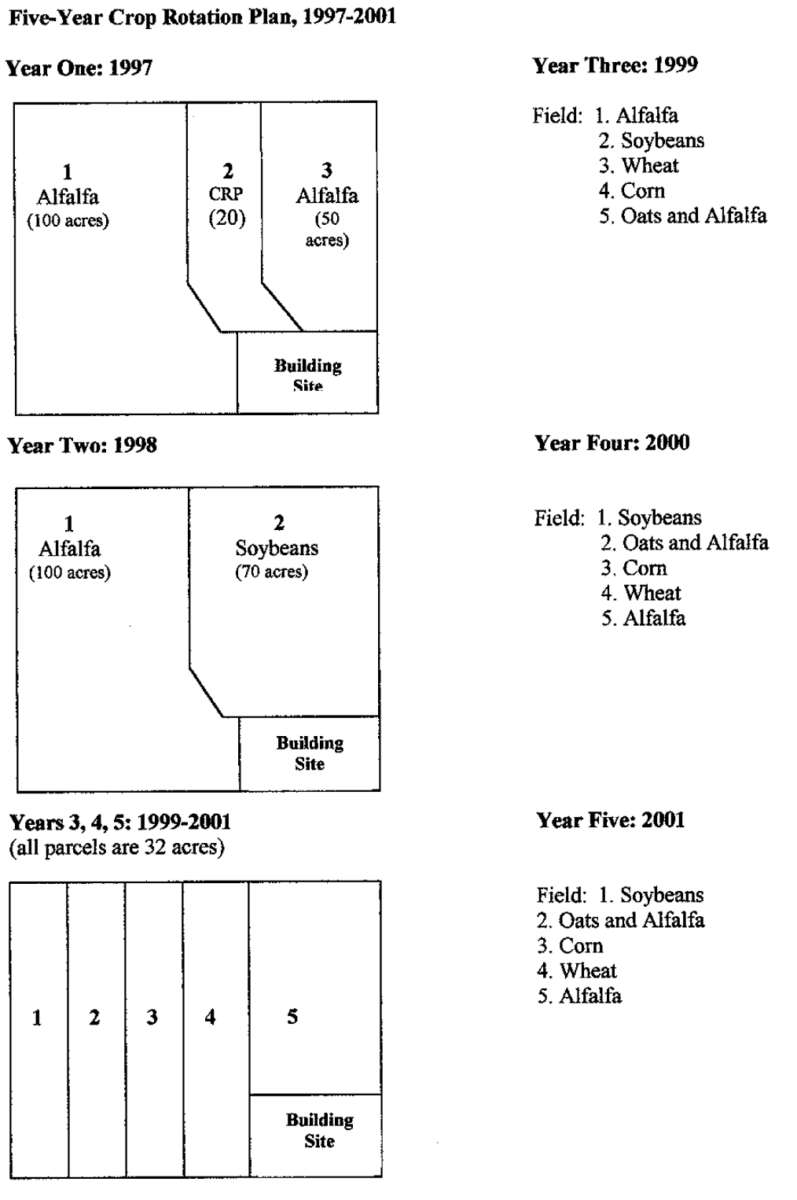
As you define one or more production system strategies, try to be specific
about how the system will work on your farm. If your vision includes a major
change in production, think about the resource requirements and the trade- offs between labor, productivity, conservation and profitability that may be associated with different production management systems. Use the space in Worksheet 4.10: Production System and Schedule (download worksheets for task 4) to describe your production system strategies for each farm enterprise. If you plan to produce crops or livestock, for instance, detail your plans for: weed, pest and disease control, soil fertility, rotation, tillage, irrigation, water quality, seed selection, breed selection, fencing, feed, housing, stocking, and waste and quality control
Similarly, if you plan to process or offer a service, the systems component of your plan might address your business’ strategy for workshops or on-farm consultations. Northwind Nursery and Orchard owner Frank Foltz, for instance, took time to describe his operation management plans for farm tours and pruning demonstrations.
There are many resources that describe traditional and, increasingly, alternative production systems. Most universities have published research studies on reduced input, organic and livestock grazing systems. Two excellent publications are the Grazing Systems Planning Guide and Making the Transition to Sustainable Farming. Most importantly, talk with other farmers—learn from their mistakes and their successes.
Production schedule. Once you have identified one or more production system strategies, think about how management within each system may change over time (e.g., from season to season or from year to year. For instance, how might your livestock management change as you transition from a system of confined farrowing to pasture farrowing for hogs, or from summer grazing to winter feeding for cattle if you plan to seasonally graze? Similarly, think about your annual crop rotation schedule, weekly vegetable harvesting schedule, or daily farm tour schedule. This type of detailed operations planning is critical for any business—it can help you estimate physical and labor resource needs and production potential, as well as cash flow projections. And in many cases, detailed production schedules may be necessary for institutional compliance. Crop producer Mabel Brelje, for example, is required to submit a crop rotation plan annually in order to obtain organic certification. For this reason, she included a rotation map in her final business plan (Figure 60).
Figure 61.
Permits Required by Cedar Summit Farm to Build Plant and Process
- Conditional Use Permit from Scott County Planning and Zoning
- Septic Tank Permit from Scott County Environmental Health
- Health and Safety Plan Approval from the Minnesota Department of Health
- Building Permit and Inspection from the Scott County Building and Inspections Division
- Environmental Operating Permit from the Minnesota Pollution Control Agency
- Food Handlers’ License from the
Minnesota Department of Agriculture - Dairy Plant License from the Minnesota is Department of Agriculture
Similarly, Dave and Florence Minar included a proposed processing schedule in their final business plan to communicate financial needs and performance to their lender:
“We plan to process and sell 30 percent of the milk produced on our farm the first year. Processing will then be increased by five percent each month until May 2004 when all of our milk will be processed.” The Minars also developed a detailed product processing schedule for each batch of bottled milk, yogurt, sour cream, butter and ice cream that was not included in their business plan. It served as an internal guide for operations.
Use Worksheet 4.10: Production System and Schedule (download worksheets for task 4) to describe your operations schedule. If you plan to make a gradual transition over time, either from one system to another or through the addition of new enterprises, use Worksheet 4.10 to map out a short-term production plan and descriptions for each phase of the transition. Use a map, a calendar or the space provided. Discuss your schedule with experienced farmers, planning team members, and consultants to determine if your production system and overall schedule are realistic.
regulations and policy: What institutional requirements exist
Like it or not, if you are going to operate a retail business, process on your farm, or greatly expand livestock production, you will run into local zoning, permitting, licensing and regulatory issues. Regulations can have a major impact on your production and operations plans as well as on start-up costs. Dave and Florence Minar, for example, had to obtain seven permits to build a plant and process their own milk (Figure 61). The type of permits or licenses required for your business will depend on where you are in the business life-cycle (whether you are just starting up or growing your business), where you live, what type of product you offer, and the overall size of your operation. Therefore, before going too far with your operations research, it’s a good idea to check with your state’s Small Business Association as well as your local or county regulators to learn about environmental, construction, finance, bonding and product safety regulations. In Minnesota, A Guide to Starting a Business in Minnesota 38 lists all necessary state permits and licenses as well as informational contacts. Some examples of the agriculture-related licenses and permits required by the State of Minnesota are listed in Figure 62.
Figure 62.
Some Agricultural Licenses and Permits Required by the State of Minnesota
- Aquaculture License
- Apiary Certificate of
Inspection - Farmstead Cheese Permit
- Dairy Plant License
- Grade A Milk Production
Permit - Feedlot Permit
- Retail and Wholesale Food
Handler License - Livestock Meat Processing
and Packing License
Moreover, if you plan to produce, process or market organic crops, you will
need to conduct thorough research about national and international certification
requirements. You should contact your state Department of Agriculture for
information about the new federal organic certification program.
Use Worksheet 4.11: Regulations and Policies (download worksheets for task 4) to begin your research, listing required permits and licenses, filing requirements, and fees. Next, determine whether or not you will be able to meet legal requirements. Discuss your ideas with planning team members and outside consultants, such as an attorney, when appropriate.
resource Needs: what are our physical resource needs?
Traditional resource management plans address land, labor and capital. Here you will identify needs in all of these areas, but limit your strategy development to land, buildings, breeding livestock, equipment and variable inputs or supplies. Labor-related strategies are discussed separately in the Human Resources Strategy section.
Take stock of your operation’s future resource needs for each enterprise and ultimately, the whole farm. Think about how much land you will need, what type of equipment you will use, and any other physical inputs necessary to produce your product. The choices that you make regarding resource use, acquisition and ownership can have a big impact on the overall profitability of your business. The costs of owning and operating farm machinery in Minnesota, for example, account for 20 to 30 percent of the annual per acre production costs for corn and soybeans.
If you are new to the business or industry and uncertain about resource requirements, try talking with experienced producers or your local Extension educator to begin brainstorming a realistic list of land, livestock, machinery, equipment, labor and other input needs. If you plan to produce a specialty commodity or use an alternative management system, accurate production input records may not be readily available. In this case, your research may take you to the Internet or some of the alternative experiment stations located at universities across the country. Your regional SARE office (see “Resources”) may be able to help you locate information sources in your area.
If you are new to the business or industry and uncertain about resource requirements, try talking with experienced producers or your local Extension educator to begin brainstorming a realistic list of land, livestock, machinery, equipment, labor and other input needs. If you plan to produce a specialty commodity or use an alternative management system, accurate production input records may not be readily available. In this case, your research may take you to the Internet or some of he alternative experiment stations located at universities across the country. Your regional SARE office (see “Resources”) may be able to help you locate information sources in your area.
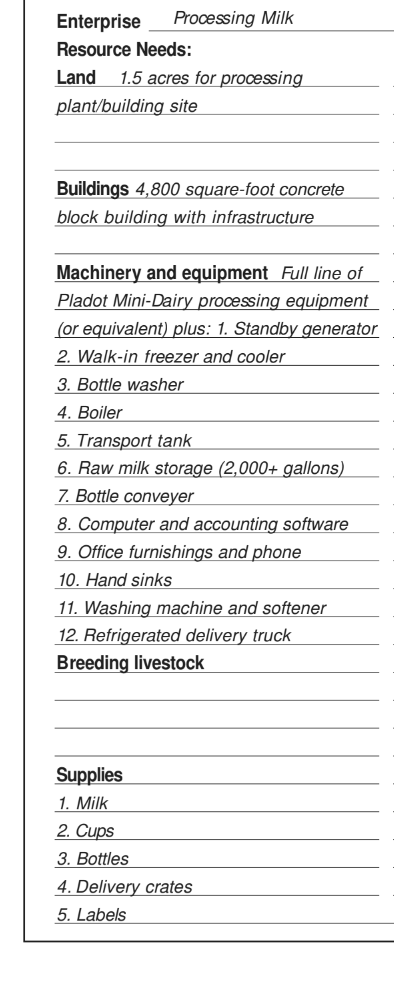
Dave and Florence Minar developed a list of processing resource needs by visiting other on-farm dairy processing plants and from business plans shared by these same business operators. Using this information, the Minars were able to generate a fairly detailed list of needed machinery, equipment and start-up inputs (Figure 63).
Referring to your completed Worksheets 2.5 and 2.6, use Worksheet 4.12: Describing Potential Crop Production Systems and Worksheet 4.13: Describing Potential Livestock Production Systems to record future resource needs for crop and livestock enterprises, respectively. Think about how your operating schedule and corresponding resource needs will change as you transition into a new management system over a period of seasons or years.
resource gaps: how will we fill physical resource gaps?
Another critical component of your operations strategy involves your plan for filling resource gaps. Return to your crop and livestock production schedules (Worksheets 2.5 and 2.6) from Planning Task Two in which you described current crop and livestock input needs and equipment use. Compare these lists to those that you completed for future operations (Worksheets 4.12 and 4.13). Are there any gaps? Or perhaps you now have underutilized resources?
Consider some of your strategy alternatives for filling or eliminating gaps between current land, building, machinery and equipment availability and future physical resource needs. Will you:
- Make better use of existing machinery and equipment?
- Acquire additional (new or used) resources?
- Gain access to additional resources through business arrangements
(formal and informal)?
Making changes in your current resource use may mean making “better” use of underutilized resources. Based on your evaluation of current resource availability and future needs, are there any resources that are underutilized or that will become underutilized as you move toward your future vision? If so, one of your resource management strategies might be to “make better use of underutilized resources.” How you define “better” will depend on your values and goals. For example, it may mean sharing or renting out equipment with another family member or neighbor.
If the gap between current resource availability and future resource needs is significant, you may need to look at acquiring additional physical resources. This can be a financially risky alternative. You will need to carefully evaluate cash flow in the next section before implementing your plans. For now, however, consider the following acquisition options if you think additional capital will be needed to meet future operating needs.
Land and buildings. Land and buildings can be purchased, rented or leased (Figure 64). Each of these acquisition options has financial advantages and disadvantages, which will be discussed further later, when you address finance strategies. For now, though, you should realize that land acquisition options should be weighed carefully. Land purchase decisions can make or break your business. They often require a large amount of capital and a long-term commitment. In a video presentation, Gayle Willett says “Purchasing real estate is one of the most important decisions a business may make . . . It is important not to let emotion overrule sound business judgment . . . .Consider both what the land is worth to the business and what you can pay for the land and still have cash flow.”40 If purchasing land is a part of your operations strategy, you’ll evaluate the feasibility of that strategy carefully in the finance sections. You’ll need to discuss cash flow, tax and equity implications with an accountant.
Machinery and equipment. If additional machinery and equipment will be needed—either to replace old equipment or to meet new resource requirements—you have several acquisition options, such as purchasing, renting, leasing, custom hiring, or exchanging labor for access to equipment (Figure 64).
If you plan to purchase additional equipment, you should also consider the advantages of buying new versus used equipment. The financial, labor, and production-related advantages and disadvantages of new versus used equipment are outlined in Figure 65. Think about these issues as well as your ability or willingness to perform equipment repairs and to finance large capital purchases.
As you brainstorm machinery and equipment acquisition options, it’s a good idea to talk with other farmers, equipment dealers and competitors about their experiences. The Minars conducted research about equipment alternatives by visiting with other farmers in person and on the phone. They traveled around the state of Minnesota and as far as West Virginia to visit other on-farm dairy processing operations.
Based on their conversations with other on-farm processors, the Minars decided to pursue the use of new equipment from Pladot, an equipment manufacturer located in Israel. The Pladot Mini-Dairy system can be sized according to the Minar’s milk production capacity. Moreover, Pladot provides training, technical support and product recipes as part of the Mini-Dairy equipment package. They felt that by purchasing the turn-key processing system from Pladot, they would be able to produce a range of quality products from their first batch of processed milk. They were concerned that their other alternative, purchasing used equipment, would risk difficulties in locating and fitting equipment, in getting the system up and running efficiently, and in developing their own recipes.
Figure 64.
Machinery Acquisition Options
Full ownership. Ownership is the most common method of acquiring long-term control of farm machinery. Ownership advantages include control over the machine’s use and scheduling. The disadvantages of full ownership include responsibility for machine operation, repairs, maintenance, liquidation and obsolescence, and capital investments.
Joint ownership. Joint ownership is becoming more and more common as a way to distribute responsibility for investment costs, repairs, and labor among two or more businesses. However, cooperation is essential. Equipment use must be coordinated and capital payments made in a timely manner. Problems can arise when the parties involved do not share a similar work and finance ethic. Written agreements are highly recommended.
Exchange work. Machinery exchange among neighbors is one of the oldest forms of farm machinery acquisition on a short-term basis. Two or more farmers working together to share labor and equipment can reduce their individual investments in machinery while giving each access to a complete system. Exchange work is still a common method of machinery acquisition among young or beginning farmers who need machinery and an older neighbor who requires labor. As with joint ownership, a working agreement is very important to determine whose farm is serviced first and who pays for repair costs.
Custom hire. Under traditional custom hire arrangements, the farm operator or landowner hires a custom operator to do one or more field operations. The custom operator provides the machinery, labor and fuel and agrees to perform specified duties at predetermined costs. Today, however, custom farming (the landowner hires a custom operator to perform most or all field operations) is gaining more interest. Under this arrangement, the landowner usually pays all cash costs, including seed and fertilizer. If you are considering a custom farming arrangement, you will need to specify the following in a written agreement: location and acreage involved, custom services required, landowner obligations, provisions for default, and a schedule of custom rates and a payment plan.
Rental. Rental usually takes place for a short, specified period. In this case, the farm owner rents a particular piece of machinery and performs all required work. The renter is responsible for daily maintenance of the machinery. Generally, there are two rental options—pure rental and rental purchase. If you are considering a rental arrangement, be sure to review the terms of each option.
Leasing. Unlike rental, leasing allows the farm business owner to gain access to machinery over a long period of time, such as 5-7 years. The advantage of the lease arrangement, from a cash flow perspective, is that payments are typically less than payments on borrowed money to own the machine. Leasing also carries its disadvantages. Often the lease payment schedule extends beyond a debt payment schedule and therefore the total amount paid for the machine usually exceeds the full ownership cost. Moreover, by leasing, it is often more difficult to enforce warranty claims against the lessor or dealer.
Figure 65.
New Versus Used Machinery and Equipment
Used machinery and equipment. Purchasing used equipment requires relatively low up-front investment costs. However, used equipment is generally less dependable than new equipment, hence labor, repair, lubrication and fuel costs are usually higher than for new machinery and equipment. Ultimately, this means that buying used equipment results in higher variable costs for the business.
New machinery and equipment. New equipment is typically more efficient and convenient and may include training or technical assistance. As a trade-off, however, new equipment can be more expensive up front, requiring larger capital investments, insurance, interest costs and depreciation.
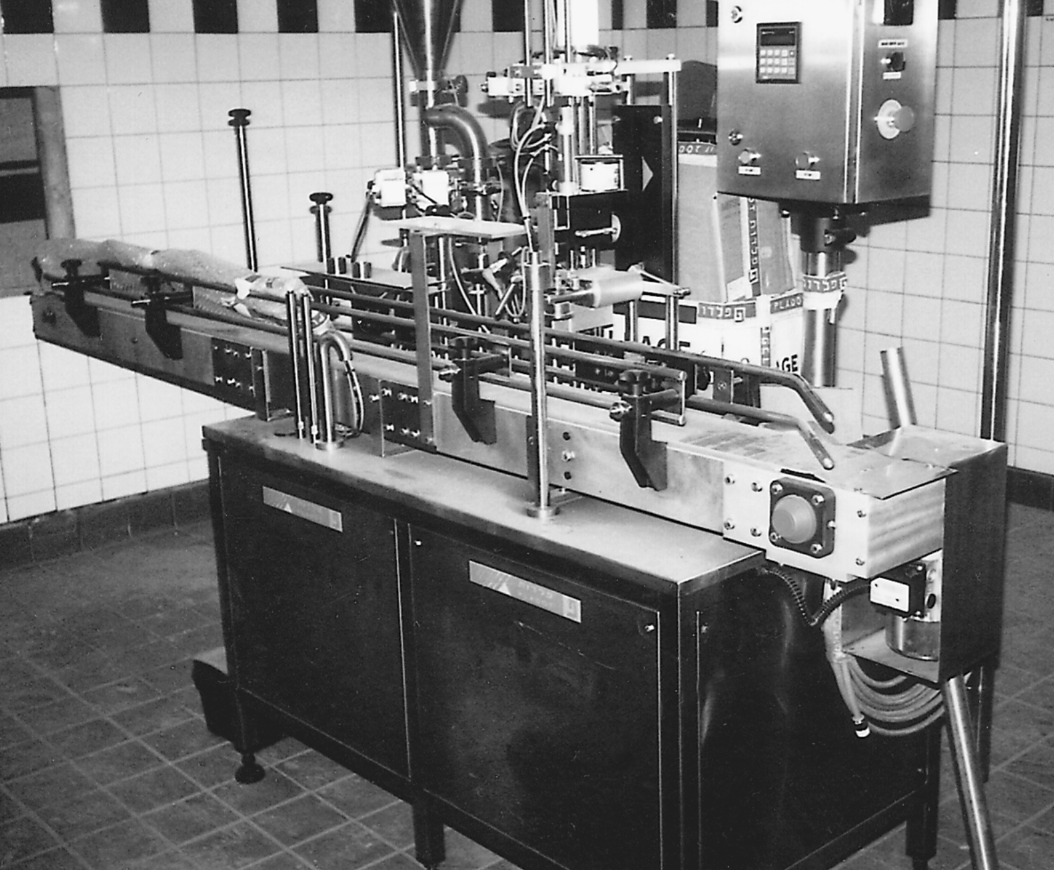
“Without recipes we would have to experiment one product at a time in order to develop quality milk, cheese, sour cream and yogurt,” explains Florence Minar. “With the Pladot recipes, we wouldn’t waste any time or money developing our product line, which means that we could begin marketing a wide range of products almost immediately.”
Return to Worksheets 2.5 and 2.6 where you described current crop and livestock resource use. Combine this information with the list of current tangible working assets (Worksheet 2.3) to identify any gaps between current and future resource needs. Look at the status of current buildings and equipment to realistically determine what can be used. Ask yourself whether there will be any overlapping demand for building space, equipment and machinery or whether replacements may be needed.
Size and Capacity: HOw much can we produce?
Your goals for growing or contracting the business as well as upper and lower limits on size will affect your choice of business organization (discussed next in the Finance Operation Strategy section) and your operations schedule. Farm size refers to the amount of land in production (number of acres), the number of animals you raise, and the value of gross income from the business. Someone who is planning to convert from a traditional cattle finishing operation to management-intensive grazing, for instance, may be limited in size during the transition period while pastures are developed and management techniques fine-tuned.
How will you size the business and plan for any growth? Begin your research with a little number crunching to determine realistic production estimates for each future enterprise and production schedule. Use information about the future carrying capacity of your land, the processing capacity of your equipment, boarding capacity of your Bed and Breakfast, or harvesting capacity of your family and staff to develop output projections. Use Worksheet 4.15: Institutional Considerations to help you think through any legal or regulatory agreements or policies that will affect the use and management of physical resources under your new operations strategies.
Figure 67. Excerpt from Mabel Brelje's Business Plan - Crop Yield Prediction
| Crop | Yield/Acre | |
| High | Low | |
| Alfalfa | Six Tons | Three Tons |
| Soybeans | 55 bushels | 30 bushels |
| Wheat | 50 bushels | 30 bushels |
| Corn | 150 bushels | 100 bushels |
Historical information about yield performance and productivity are available for traditional enterprises from a number of resources. Check with your local Extension office or your state Department of Agriculture. In the Upper Midwest, check out FINBIN43 and Farm Business Management’s Annual Report.44 Again, alternative production system information might be a little harder to find, but your local Extension office or state Department of Agriculture should be able to give you some ideas of who to contact in your area if they don’t have that information. Check also with sustainable agriculture organizations in your area or your regional SARE office. One of your most useful resources may be other farmers—those who are on the cutting edge—using a new production system or technology.
As you develop output/production estimates, particularly for alternative enterprises with little recorded performance history, you may want to estimate “best” and “worst” case production scenarios, or high and low output projections. Organic crop producer, Mabel Brelje chose to develop high and low yield projections for her oilseed and grain crops as shown in Figure 67. She used these projections in her financial analysis to evaluate profitability and risk.
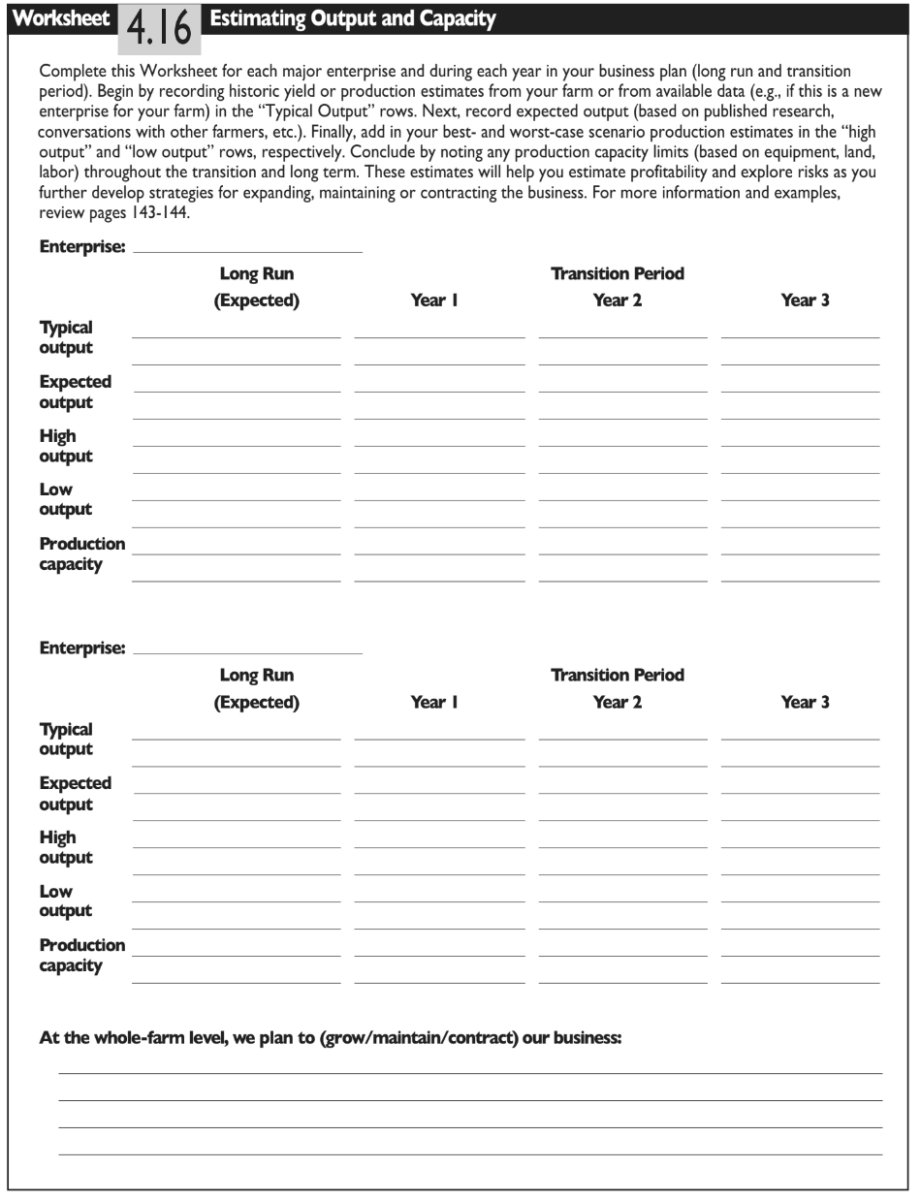
Dave and Florence Minar developed an upper limit for bottled milk production based on pasture acreage, herd productivity, and equipment capacity. At current productivity levels and herd size, the Minars’ cows produce 166,913 pounds of milk per month. The Pladot Mini-Dairy equipment can process between 148,333—207,667 pounds of milk per month. Should market demand increase for their products, the Minars could increase their herd (and output) to 187 cows and process at the plant’s full capacity. They have the acreage to support more cows. However, this would necessitate converting some of their hay fields to pasture or acquiring access to additional land resources. These are issues that the Minars will need to evaluate in their contingency plan should future opportunities arise.
Use Worksheet 4.16: Estimating Output and Capacity to estimate production/output potential and begin shaping a size-related strategy for the business. If appropriate, describe your growth or contraction strategy for the whole farm and for each future enterprise.
Develop a Strategic Operations Plan
You’re ready to develop a whole farm operations plan! Use Worksheet 4.17: Operations Strategy Summary to briefly describe the management system you intend to implement for each enterprise. Detail crop rotations, pasture layout and rotation, milking schedules, etc. Think about how these might change throughout your start-up or transition period. Next, list new resource needs and your strategy for acquiring them. Then record all operating expenses associated with each enterprise or the whole farm (if appropriate). Finally, you’re ready to pull your enterprise-specific operations strategies together into one, whole-farm production and operations strategy.
The Minars summarized their operations strategy on Worksheet 4.17, as shown in Figure 69. As you draft a whole-farm operations summary, be sure to include supporting research and note the strengths, weaknesses, opportunities and threats (SWOT) associated with each strategy alternative. You will use this information in the next section to evaluate the feasibility of each strategy alternative and to settle on a final course of action for the business. It’s also a good idea to have each planning team member summarize a whole farm operations strategy and work through a SWOT analysis on their own. Then you can compare notes and brainstorm about internal and external threats, and make sure everyone agrees on which overall operations plan you will pursue.
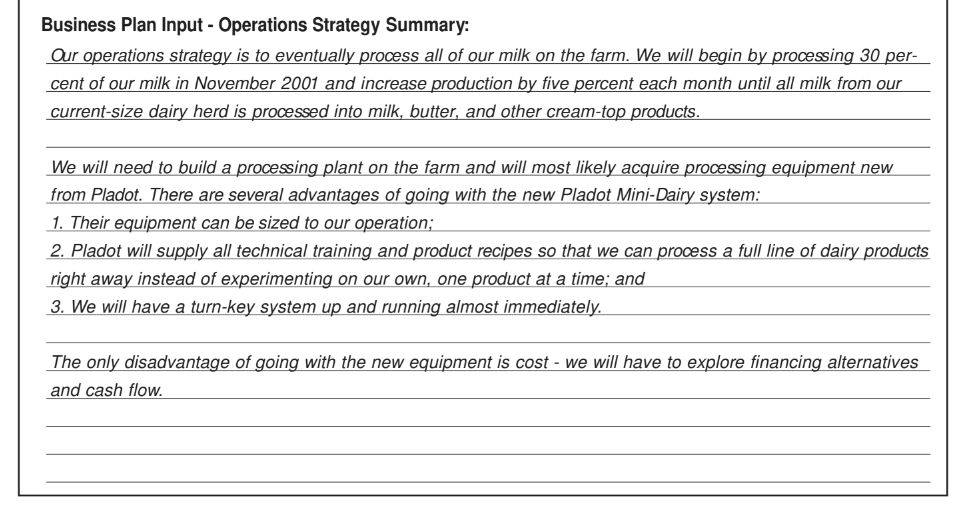
Human Resources Strategy
As you draft a whole-farm operations summary, be sure to include supporting
research and note the strengths, weaknesses, opportunities and threats
(SWOT) associated with each strategy alternative. You will use this information in the next section to evaluate the feasibility of each strategy alternative and to settle on a final course of action for the business. It’s also a good idea to have each planning team member summarize a whole farm operations strategy and work through a SWOT analysis on their own. Then you can compare notes and brainstorm about internal and external threats, and make sure everyone agrees on which overall operations plan you will pursue.
In this section, you and your planning team will begin to build a human resources strategy to address your changing management and work force needs. This strategy should embrace your family goals while meeting new business needs.
You will begin your strategic planning by answering questions about:
- Labor needs: What are our future workforce needs?
- Skills: What skills will be required to fill workforce needs?
- Gaps: How will we fill workforce gaps?
- Compensation: How will we pay family and members of our workforce?
- Management and communication: Who will manage the business and how?
You’ll work through this Human Resources section of Developing a Business Strategy by working through the following aspects of Human Resources in the order shown below.
You will begin your research by determining projected labor needs for each enterprise (product). Next, you will compare your projected labor needs against current labor resources to identify any gaps, as you did in the operations section for physical resources. You and your planning team will then need to consider how to fill those gaps and to identify one or more strategies for doing so. Finally, you will develop a strategy for managing labor and the business. This is perhaps one of the most critical components of your business strategy. Without an effective management plan or business manager, even the best of business plans can fall apart. Take your time developing a human resources management strategy—it will be one of your keys to success.
Labor needs: What are our future workforce needs?
Begin building your human resources strategy with some critical thinking about the type of work and accompanying workloads that will be necessary to reach your future vision and to carry out the marketing-, operations- and finance-related work within the business.
Tasks. What new marketing-, operations- and finance-related tasks will be required to produce and market a new product or to implement and manage a new production system? Be realistic about your labor needs and consider the not-so-obvious elements of business ownership and management, such as ttime required to communicate with staff, make equipment repairs, and handle administrative needs. For example, if you are considering organic production, be sure to plan ample time for record keeping. The paperwork necessary to track inputs, harvest and storage in an organic system can be tedious and time consuming.
“Many organic producers consider the organic premium to be primarily a payment for the extra administrative efforts required by credible certification agencies,” notes certification specialist Lisa Gulbranson. “The audit trail for a certified organic product must be maintained with great detail.”
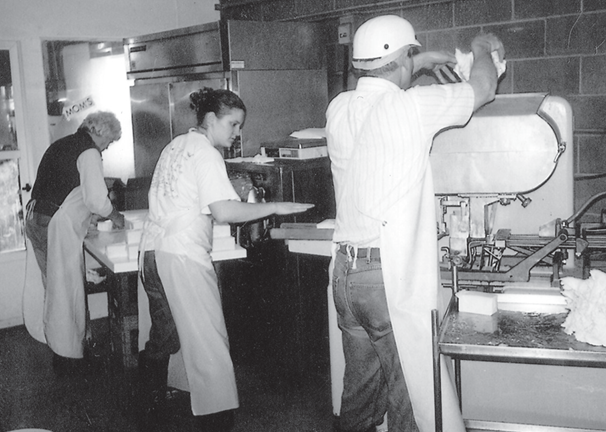
Workload. Once you and your planning team have brainstormed a list of new tasks, try to estimate how much time each task will require and note any seasonal bottlenecks. This will help you to visualize the peaks and valleys of work demands, which in turn will help determine how to fill workforce needs or reduce workloads.
Be sure to include work involved in producing and marketing products, maintaining equipment and facilities, and in managing the business when calculating your labor needs. If you are uncertain about how much time will be needed for each task, talk with other farmers, like the Minars did, or consult Appendix D for a list of traditional enterprise-related labor requirements. If you haven’t already done so, return to Worksheets 2.8 and 2.9, in which you described the labor requirements for current tasks. You could also begin this research by tracking your own current hours (if you are already in business) to get a sense of just how much time is involved in seemingly routine tasks. You may be surprised by the results. Then use these actual recorded hours as a basis for developing realistic projections for your future labor and staff needs.
In Worksheet 4.18, shown in Figure 70, the Minars summarized their labor needs for processed products. Dave and Florence anticipated some seasonal bursts of marketing activity during winter and spring holidays. Preceding each holiday season, the Minars budgeted extra staff time to handle on-farm customer sales. Similarly, their financial staff needs are expected to increase at yearend and prior to tax reporting. Product promotion and delivery workloads are expected to remain fairly constant throughout the year, as will time needed to process products. Staff needs may increase as the Minars reach full processing capacity in 2004. Labor estimates for plant staff are based on conversations with other on-farm processors and a Pladot equipment representative. Look at the Minars’ completed Worksheet 4.18: Tasks and Workload for Cedar Summit Creamery’s processing enterprise and begin to develop your own labor and staff estimates.
skills: What skills will be required to fill workforce needs?
Before you begin to develop a strategy for filling workforce needs, you should get a good feel for the type of skills required for each new task or position. This information, combined with workload estimates, should help you better decide how to fill your human resources needs.
Begin your research by learning more about any new work that you and others will be required to do. Ohio State University economist Chris Zoller recommends developing “well thought-out job descriptions” that are compatible with the business’ mission and goals for each new position that will be created. Job descriptions—even for those positions that will be filled internally with family labor—can help make your human resources strategy a positive one by clearly identifying desired skills, expectations, responsibilities and compensation. A sample job description form is included in Appendix C to help you with this task.
As part of their “skills” research, Dave and Florence Minar pitched in at Minnesota Organic Milk (MOM’s)—an on-farm processing plant located in Gibbon, Minnesota (Figure 71). They worked on the MOM’s processing line one afternoon to help with butter production and packaging. Based on this experience and their visits to other on-farm dairy processing plants around the country, the Minars developed a good feel for future workloads and tasks. Conse quently, they felt confident developing a realistic strategy for meeting some of their future labor needs. Explore similar opportunities as you begin identifying tasks. Try to get a feel for skills that may be required for each task.
Use Worksheet 4.19: Filling Workforce Needs to begin describing the skills that are required for each new task or position.
gaps: how will we fill workforce gaps?
Next, think about how you will fill current and future workforce gaps. In other words, begin building your human resources strategy. You could:
• Redefine tasks for the current workforce.
• Add new labor to the workforce.
• Access additional labor through work-trade, contracting, or new business arrangements.
• Substitute capital for labor.
Will you shift responsibilities or reassign tasks among your current workforce? Will you hire family or community members to fill new jobs? Will you reorganize the business to reduce your own workload? Any one of these strategies may be appropriate for your business depending on the values and goals identified by your planning team, your financial picture, and the skills of your current workforce.
The labor strategy that you choose will depend on how much of a gap exists between your current workforce and your projected workforce needs. For instance, if most of your projected labor needs can be met through your current workforce, you may decide to hire part-time workers or custom operators to meet seasonal bottlenecks or remaining needs. On the other hand, if you anticipate major gaps between current and future labor needs, you may want to consider hiring additional permanent or temporary staff, substituting capital for labor, or reorganizing the business into a partnership so that labor (and equipment) can be shared.
If you’ve decided to reassign current tasks or jobs, refer to the skills assessment that you developed in Planning Task Two (Worksheet 2.7), along with each team member’s personal workload goals (Worksheet 3.3) to determine who will fill projected work force needs. Be realistic! On the other hand, if you plan to add labor, consider the range of acquisition options such as contract labor, custom operators, employees, family labor, interns and volunteers. The advantages and disadvantages of some of these alternatives are described in Figure 72. Some of these strategy alternatives may have significant tax, equity and cash flow implications. You will have an opportunity to evaluate workforce plans from a financial perspective later, before finalizing the labor component of your whole farm business strategy.
Figure 72.
Filling Workforce Needs
Contract service providers. Contract workers may be self employed or an employee of the contract provider. Crop harvesting is one of the most common contract services provided. If you plan to contract for services, be sure to consult your tax accountant regarding tax withholding and employer liabilities.
Custom operators. Custom operators are usually the cheapest source of temporary labor. Custom operators often are well trained and supply their own equipment. They require no tax withholding or benefit packages. The primary advantage of custom operators is that they free up family labor and employees for other specialized tasks.
Employees. Hiring full and part-time employees requires time (searching, hiring, training, managing) and raises new issues to deal with, including compensation, benefits packages, discipline and sometimes firing. They can make a business more profitable only if they are truly needed and are a good match.
Family labor. Farm operators and other “unpaid” family members account for twothirds of the production workforce in agriculture. They offer the advantage of knowing your business well, but can also carry family conflict into the business.
Seasonal hired labor. Hired labor is typically used to fill seasonal workforce shortages when operators and family members are unable to supply the necessary labor. Hired labor is usually paid less than other workers or employees. There are many laws and regulations that govern seasonal or migrant labor.
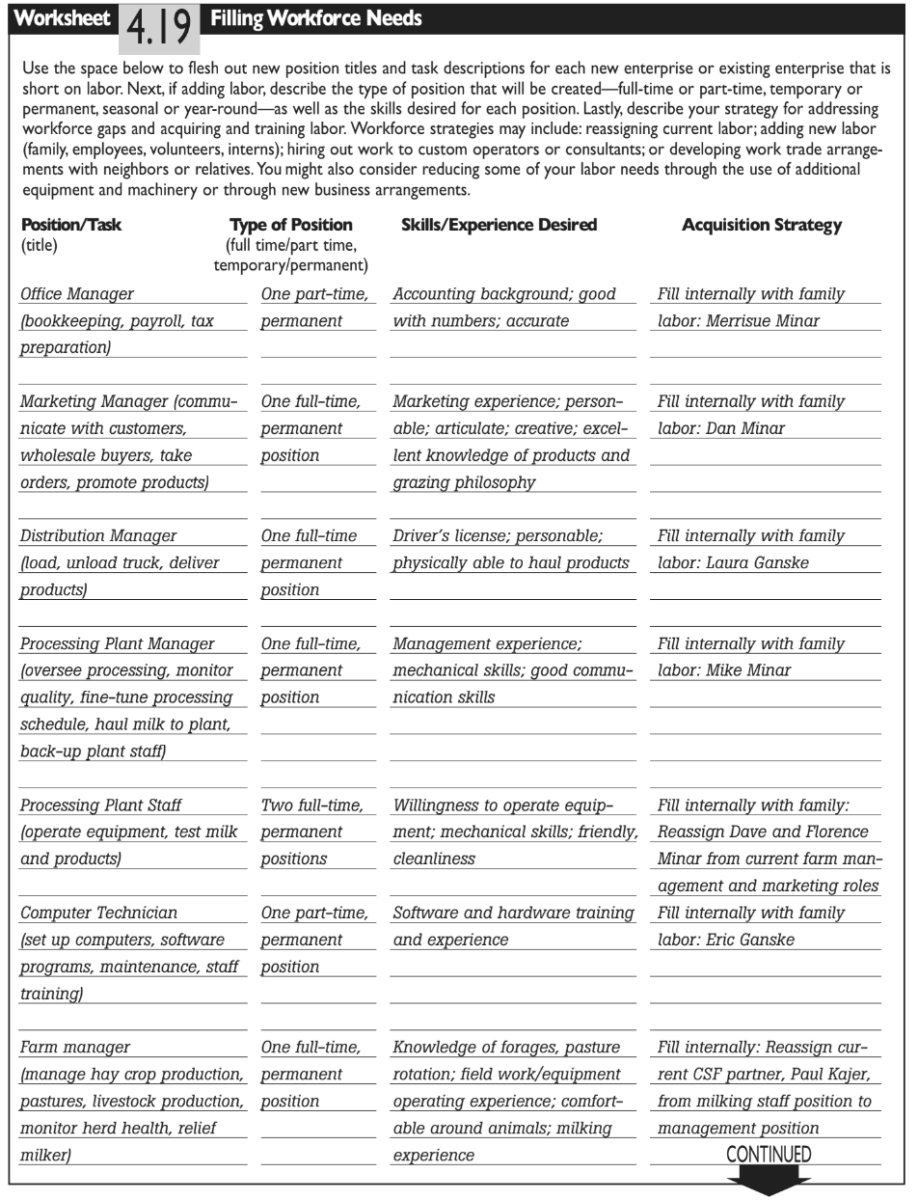
According to their workforce strategy in Worksheet 4.17, the Minars could fill nearly all of their workforce needs through the creation of permanent jobs for several family members. Their daughter, Laura Ganske, would become the business’ new distribution manager. She would coordinate and staff home deliveries and on-farm sales. Mike Minar and his wife, Merrisue, would also both join the business as permanent employees. Mike would become the processing plant manager. He would oversee production, testing, and packaging. Merrisue would work part-time as the business’ office manager. She would handle bookkeeping and payroll. The Minars’ youngest child, Dan Minar, also will join the business full-time as a marketing manager once he has completed his university degree. Dave, Florence, and their current partner, Paul Kajer, would be reassigned to new tasks. Dave and Florence would work full-time in the plant while Paul would take over Dave’s current work as livestock manager, performing all pasture and dairy production-related management tasks. This shift would create a new gap—the need for a full-time milker—that the Minars planed to fill with external hired labor.
Ultimately, your labor strategy—your decision to hire workers, purchase equipment or reorganize the business—will depend on your financial goals and personal values. For instance, there is clearly more than one way for the Minars to staff their processing plant and to fill distribution and production positions. In addition to family labor, they could have considered hired labor and employees for processing and crop production. However, because their values and planning purpose are rooted in the idea of creating jobs and income for family members, they limited their strategy options to hiring family members and redefining family member roles as a way to fill most new jobs/tasks. As you develop a workforce strategy, revisit your values and goals for human resources. Think about your willingness to perform fieldwork, communicate with customers, work with livestock, or maintain financial records, among other things.
Use Worksheet 4.19: Filling Workforce Needs (download worksheets for task 4) to describe your strategy for addressing workforce gaps or acquiring and training labor.
Compensation: how will we pay family and members of our workforce?
Wages and other benefits that you offer family, employees, hired labor, interns and contracted labor will vary with industry rates and standards as well as the type of work involved and, of course, your values. You and your planning team will need to consider all of these factors when developing a labor compensation package as part of your overall human resources strategy.
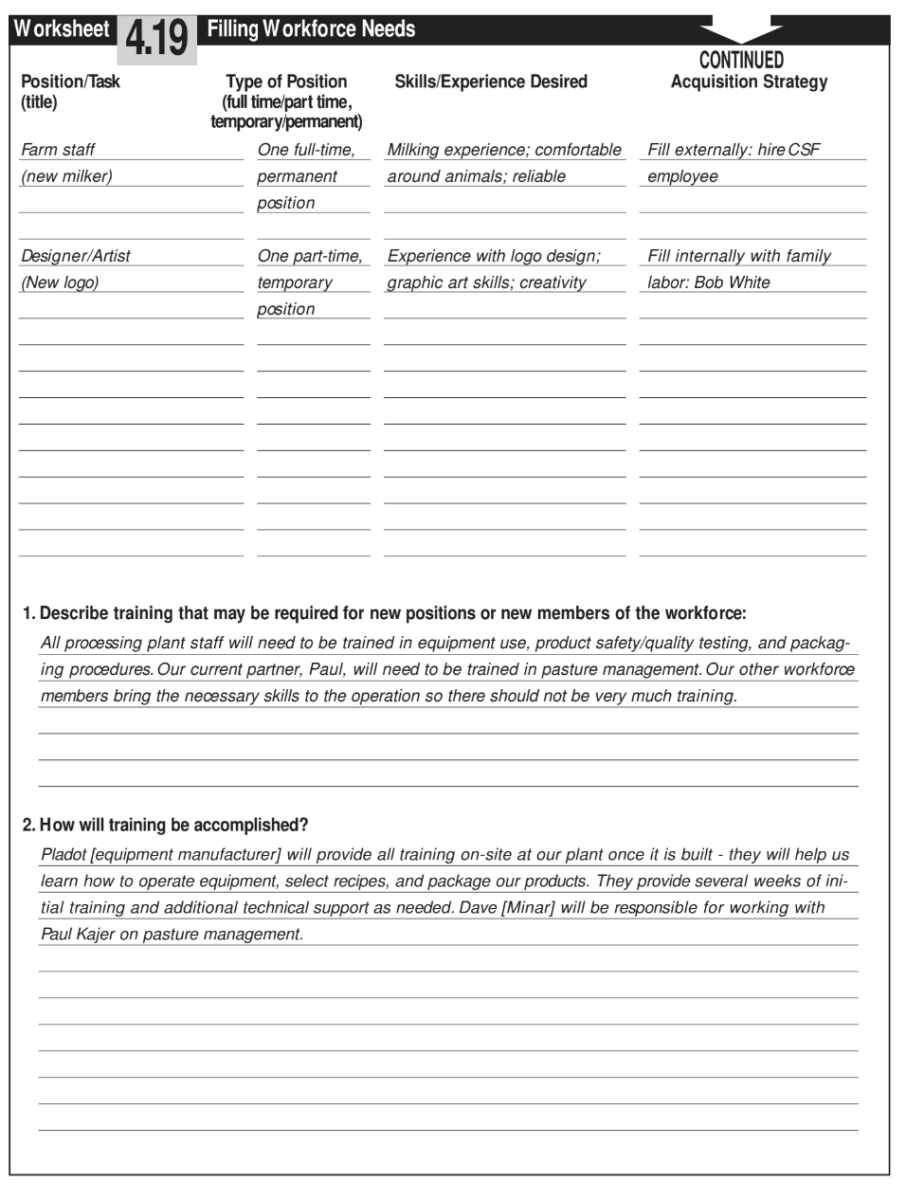
A good place to begin developing your benefits strategy is by looking at industry standards. Find out what salary and other benefits are typical for your business (check with your state Department of Agriculture or talk to other farmers) and adjust them according to your own values and goals. The Minars, for instance, decided to pay their son a salary that was comparable to what he earned as a production supervisor at a high-tech medical supply manufacturer. Although this salary may be well above dairy industry standards, Dave and Florence agreed to offer their son a comparable salary because of his commitment to the business, family needs, and their own vision of a “fair” wage. Of course, the Minars’ plan to pay an above-average salary must be balanced against their financial objectives for cash flow, profitability, and net equity growth—something they had to consider when evaluating their strategic plan.
In addition to a cash wage or salary, common forms of labor compensation include housing (room and board), products (milk, meat, nursery stock, cheese), automobile, insurance (health, accident), stocks or shares of the business, and retirement investments, such as a Simplified Employeed Pension (SEP) Plan or 401K.49 You may want to review business organization alternative strategies (addressed as you develop a Finance Strategy in the next section) to explore tax and other institutional requirements before settling on a labor compensation strategy. An accountant or attorney will be able to help you work out the details of human resources compensation.
Use Worksheet 4.20: Compensation (download worksheets for task 4) to research and draft a compensation plan for each new position or worker. Then use this information to develop monthly and hourly labor input expense estimates for each position in Worksheet 4.21: Human Resources Expense Estimates (download worksheets for task 4). These will be used as you evaluate the profitability and cash flow of your alternative strategies.
management and communication: who will manage the business and how?
Good management and communication are pivotal and often intangible qualities of a successful business. No matter how well a business strategy has been researched and evaluated, it will not help accomplish your goals unless there is an effective manager behind it— one who knows how to communicate. Therefore, spend a little time fleshing out a management and communication plan for the business.
Management. Farm business managers, like most independent small business owners, are responsible for a range of tasks that include planning, organization, decision-making and control of resources.50 They are responsible for the long-term development and success of the business—implementing the business plan, monitoring performance, and facilitating change.
Based on your skills assessment in Planning Task Two (Worksheet 2.9), think about your ability and desire to manage the farm business—to plan, organize, make decisions and communicate with your workforce. Taking on management responsibilities yourself is only one of several strategic options. You might consider other strategic alternatives such as:
- Hiring out management.
- Partnering with someone else to share management duties.
- Transferring the management duties to someone else within the business.
Dave and Florence Minar planned to retain overall management responsibility for Cedar Summit Farm and their new business Cedar Summit Creamery. However, they planned to share specific marketing, operations, and finance-related management duties with their children and current business partner, Paul Kajer. This management strategy required constant communication and a clear understanding of the business’ objectives by all members of the Minar’s management team. Dave and Florence explained that they feel well prepared to manage as a team. They have been planning and visioning together with their children on a regular basis for more than ten years.
Communication. Regardless of whether you plan to manage as a team, with a partner, or on your own, effective communication will be important. As Ohio State University specialist Bernard Erven notes, “Although communication does not guarantee success of a farm business, its absence usually assures problems. A communication problem may soon become a crisis or it may linger on for years.” See Figure 74 for tips on how to become an effective communicator— particularly if you plan to play any role in managing the business. Making It Work, a one-hour video on family communication and conflict resolution for business planning is an excellent communication resource.
Figure 74.
Barriers to Effective Communication
- Muddled Messages—be clear when communicating ideas or details.
- Stereotyping—don’t assume that you know how the other person feels.
- Wrong channel—use appropriate forms of communication (written communication for transactions, work agreements, etc. versus verbal agreements).
- Language—make sure that you speak the same “language,” that terminology is clear to those involved.
- Lack of feedback—prompt detailed feedback by checking in regularly.
- Poor listening skills—always be prepared to listen; tune out other thoughts. Search for the meaning in what is being said.
- Interruptions—try to anticipate and limit interruptions or other distractions.
- Physical distractions—make sure there are no physical distractions (noise, extreme temperatures) when communicating.
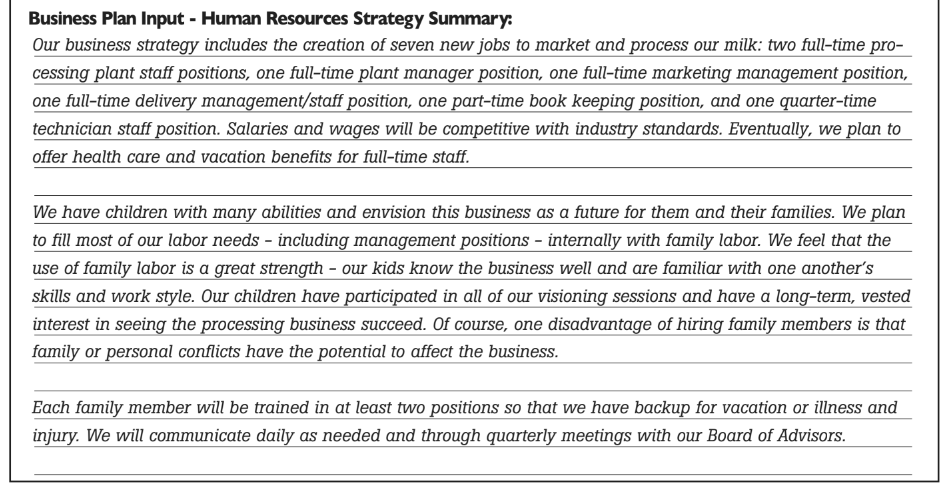
Use Worksheet 4.22: Management Strategy (download worksheets for task 4) to identify your management strategy for the business. Think hard about your willingness to perform the duties of an effective communicator. Your management strategy should include a short- and long-term back-up plan to arrange for management in the case of an emergency due to illness or shift in goals on the part of management team members. A written management plan can be particularly useful, and may become a final part of your business plan if you decide to manage as a team. Management teams and boards often use written management plans to clearly specify management responsibilities, check-in meeting dates, and a description of grievance procedure.
Develop a Strategic Human Resources Plan
Briefly summarize your human resources strategy for each enterprise or the whole farm (if appropriate) using the space in Worksheet 4.23: Human Resources Strategy Summary (download worksheets for task 4). Carefully review your research, and describe workforce needs and plans for filling them. Note the strengths, weaknesses, opportunities and threats (SWOT) associated with each strategy. This also is a good time to list human resources expense estimates for each enterprise. You will use this information when you evaluate the feasibility of each strategy alternative.
Financial Strategy
Financially successful businesses are usually built around strategies that incorporate risk management, tax-efficient organization, and careful use of financing. In this section you will build a financial strategy by looking at:
- Risk: What does our future business environment look like and how will we manage for risk?
- Organization: How will we legally organize and structure the business?
- Financing: How will we finance capital requirements?
When you evaluate your strategic plan, you will have the opportunity to evaluate enterprise and whole farm strategies from a financial perspective by looking at projected profitability, liquidity and solvency. For now, however, concentrate on the development of risk management, organization and finance strategies.
As you do so, recall your financial values and goals. What is important to you? Paying down debt? Putting money away for the future? Being able to save for “down times”? Reducing overall financial risk? Generating most or all of your income from the farm business? Use your values and goals along with your SWOT assessment to guide the development of one or more whole farm financial strategies.
risk management: how will we manage risk?
In today’s farm economy, risk management has become an important topic, particularly for those producers who have traditionally relied on government intervention to mitigate price and production-related uncertainties. Regardless of whether you produce corn, soybeans, grass-based milk, organic vegetables or specialty fruit trees, risk management will be an important component of your business plan. Without it, uncontrolled risk and uncertainty reduce the reliability of financial projections and make investment analysis difficult. Unmanaged risk and uncertainty also carry with them a high degree of stress for farm managers and their families. In this section, you and your planning team will first research the potential business risks that stem from new marketing, operations and human resources strategies. Then you will be ready to develop a whole farm risk management strategy (or combination of strategies) to minimize and protect against future uncertainty.
As described in Planning Task Two, farm businesses, particularly family farm businesses, often are exposed to many forms of risk: personal risk, production risk, market risk, institutional risk and financial risk.Production- and market-related risk management alternatives include enterprise diversification, cultural production practices (irrigation, short season crop varieties), hedging with futures and options, and storage. What type of risk will your business be exposed to in the future as you look at new products, farm management systems, and labor strategies? How will you manage this new risk? Common risk management strategies are to: minimize production- and market-related risk; transfer risk outside of the business; and build internal capacity to bear risk financially.
Production- and market-related risk management alternatives include enterprise diversification, cultural production practices (irrigation, short season crop varieties), hedging with futures and options, and storage.
Risk transfer outside the business can be done by purchasing insurance (crop, property, health, home, liability), signing production or sales contracts, and participating in government programs.
Figure 76.
Risk Management Alternatives.
Cash and credit reserves. Holding your own cash reserves or building credit reserves with your lender are common risk management strategies for improving liquidity. Credit reserves take the form of carryover debt, refinancing and emergency credit. Use of credit reserves typically requires that you have a good, established relationship with a lender as well as a strategy for managing production and marketrelated risk.
Insurance. Insurance is often used by crop producers to reduce yield related income risk. The Federal Crop Insurance Corporation (FCIC) and private crop insurance vendors offer insurance programs to help producers control crop production risk at a reasonable cost. Insurance provides a financial safety net in case of severe production losses or low crop prices. It provides two important benefits: a reliable level of cash flow and more flexibility in marketing plans. Other forms of insurance include property, health, liability and export insurance.
Enterprise diversification. Farms that produce one product are vulnerable to changes in market trends. Enterprise diversification provides some financial protection in fluctuating markets and against production catastrophe should one product fail. Enterprise diversification also allows the business owner to average profit and loss over different products and to combine two products (such as cheese and herbs) for value-added profit. One of the disadvantages of enterprise diversification can be the loss of production and management efficiency that is present with specialized operations.
Government programs. Historically, government programs have helped farmers mitigate short-term, price-related market risks. Under the Farm Security and Rural Investment Act 2002 direct payments, countercyclical market price supports and marketing loans were instituted for program crops and qualifying acreage. Moreover, provisions were made in the 2002 bill to defer some of the costs associated with organic conversion and compliance, among other things. For a full description of current farm bill provisions, contact the USDA or visit their website: www.usda.gov/farmbill/.
Hedging with futures. Hedging involves the sale of a futures contract at harvest time with the expectation of market price increases. You earn the difference between the price at which you initially sold the futures contract and the price at which you buy it back weeks or months later. Of course, if the price falls between the time that you hedged your crop or livestock and repurchased the futures contract, you will incur a loss. Futures are not available for all crops and livestock. When using futures, you must determine whether or not you can realistically meet product quantity and delivery dates.
Income diversification. Supplementing farm income with cash from other sources, such as off farm employment, can help balance negative fluctuations in cash farm income and, in some cases, provide a reliable or steady stream of income for your household. According to a 1996 nationwide survey by USDA, 82 percent of all farm households generated off farm income that exceeded their farm income.
Investment diversification. Diversifying investments among farm and non-farm assets is a relatively new risk management strategy among farmers. Research has shown that farm and non-farm asset values fluctuate inversely. In other words, when farm asset values are declining, the value of stocks, treasury bills, certificates of deposit and bonds are typically on the rise.
Leasing. Leasing land, machinery, equipment or livestock is one way to minimize financial risk and create flexibility. Leasing allows you, the producer, to gain access to equipment and land without making longterm payment commitments. This frees up cash and investment funds for other uses. The primary disadvantage to leasing is that you do not have the opportunity to build equity or loan collateral.
Production and marketing contracts. Production contracts typically give the contractor considerable control over the production process. Under the contract, the contractor specifies varieties, breeds and production timing to ensure finalproduct quality. Inputs are usually supplied by the contractor. In exchange for their loss of management control, producers are usually compensated with financial incentives. Production contracts have become common in the livestock sector and are increasingly available in the specialty commodity sector. Brokers, handlers, seed companies, grain processors and other intermediaries regularly contract for specialty commodities such as food grade corn, tofugrade soybeans and organic feed grains. Marketing contracts are either verbal or written agreements between the buyer (contractor) and producer (contractee). Typically, responsibility for breed or variety selection is retained by the producer. A price is usually determined in advance of harvest and delivery terms are specified. Premiums and discounts may be established for grain that does not match quality specifications under both production and marketing contracts. Flat price contracts, where the buyer agrees to pay a fixed price per unit, are the most common form of marketing contracts.
Storage. On-farm storage such as grain bins, containers and freezers allow grain producers to spread out sales over a 12month period, much like livestock producers, and extend the marketing season (in the case of fresh vegetables, grain and meat cuts). One disadvantage of storage as a risk management tool is expense, although the use of containers for small lots of identity preserved grain is a fairly low cost option.
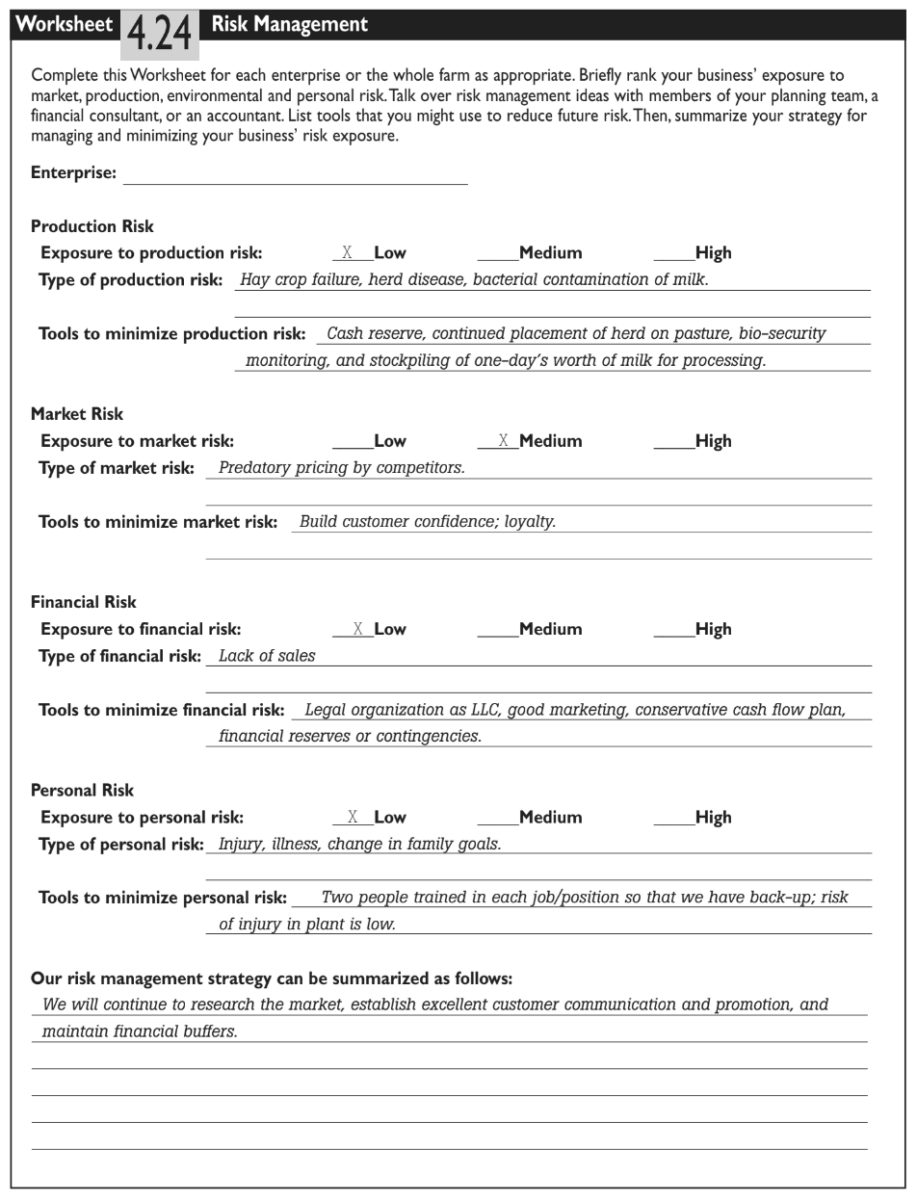
Building internal capacity to bear financial risk can be accomplished by adjusting household consumption, diversifying income sources within and outside the business and investments (farm and nonfarm), increasing liquidity (holding cash, establishing credit reserves), leasing short- and long-term assets, and spreading out asset sales and purchases.
You may already be familiar with many of these risk management alternatives. Each alternative has its own advantages, disadvantages and resource requirements. Some of these risk management alternatives are described in Figure 76. The appropriate alternatives and overall risk management strategy for your business will depend, in large part, on your willingness to adjust production practices, spend time on the phone or in front of the computer, and to take on more management responsibilities.
Use Worksheet 4.24: Risk Management (download worksheets for task 4) to develop a risk management strategy for your business and identify future sources of risk. Begin by returning to Worksheet 2.17 (Risk Management) where you identified current sources of risk. Ask yourself how these will change in the future as you pursue new marketing, operations and human resources strategies. Then identify a plan for coping with and managing this future risk. Your lender and financial planner are excellent resources for analyzing risk potential.
Organizational structure: How will we legally organize and structure our business?
The legal organization that you choose for your business will have risk, finance, tax and estate planning ramifications. Legal organization is typically one of the first decisions made when structuring a new business.
As a current business owner you might consider re-evaluating your organization strategy here to determine if one of the alternatives provide legal or financial benefits. As a new or potential business owner who is at the beginning of the business life-cycle, however, you have a range of organizational strategy alternatives to consider.
Traditionally, most farm businesses have legally organized as sole proprietorships or partnerships. This is still a common legal structure, but a growing number of today’s farms are incorporating as Limited Liability Corporations (LLCs) or Cooperatives. These structures offer some financial protection, tax advantages, and other benefits. The Minars, for instance, considered three organizational alternatives: LLC, S-Corporation (a corporation in which the owner holds 100% of the shares), and Partnership. After researching each alternative and weighing the advantages and disadvantages of each, they decided to organize the processing business as an LLC. This structure enables them to gradually pass shares and ownership of the business on to their children in advance of retirement. “We also hope that by making our children shareholders, they will have more of a long-term, vested interest in the business,” explains Florence Minar.
Figure 78.
Legal Organization Options
Sole proprietorship. In a sole proprietorship, the business is owned and controlled by one person. This means that if a husband and wife or father and son plan to operate the business together, only one of them can hold legal title to the business. The primary advantage of sole proprietorship organization is that you are independent and free to make all business decisions without an obligation to partners or shareholders. The disadvan tage of a sole proprietorship is that you are personally liable for any debt, taxes, or other financial and regulatory charges.
Partnership. Partnerships may be formed between two or more family members or third parties. Each partner is liable for all partnership obligations. One of the primary advantages of a part ne rship may be the infusion of business capital and other assets by one or more partners. Each partner pays taxes indi vidually based on his or her share of income, capital gains and losses. There are two types of partnership: general partnerships and limited partnerships. In a general partnership, one or more partners are jointly responsible or liable for the debts of the partnership.
Corporation. Corporations are owned by one or more shareholders and are managed by elected directors. A corporation must be established in compliance with statutory requirements of the state of incorporation. In Minnesota, articles of incorporation and bylaws are legally required. The corpor ation, not its share holders, are responsible for corporate debts and other obligations. One disadvantage of corporate organization is that its owners and family members are considered employees of the business and are therefore subject to labor laws and taxes.
Limited Liability Company (LLC). This organizational form offers owners limited liability like a corporation—investors are liable only for their investment in the business—but it may be classified as a partnership for tax purposes. Two or more business partners may form an LLC.
Land trust. A land trust is a legal entity that allows a land owner to transfer property to a trustee. While the trustee is the legal owner of the property, the beneficiaries are given posses sion and management of the land. This type of legal organization can be beneficial for estate planning purposes as it allows the beneficiaries to avoid probate upon death of the owner.
Cooperative. A cooperative is a legally incorporated business entity capitalized by its member patrons or owners. Dividends are paid out to its patrons. A cooperative is taxed on income at corporate rates, but patronage refunds are often taxdeductible to the cooperative. Many farmers are now using cooperative organi zation to acquire and provide machinery, livestock breeding and equipment maintenance, as well as marketing and advisory services.
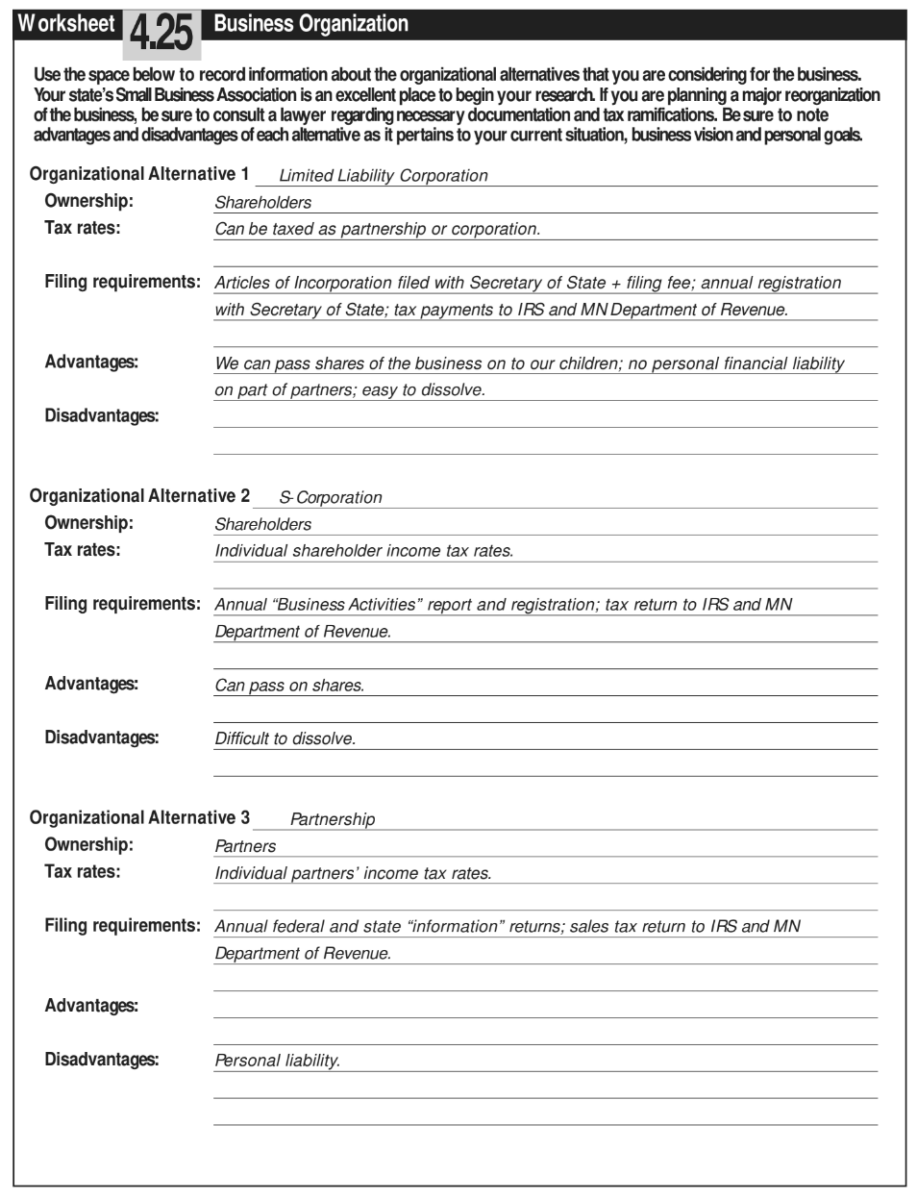
The advantages and disadvantages of sole proprietorship, partnerships, LLCs and other legal business arrangements are described in Figure 78.
Use Worksheet 4.25: Business Organization (download worksheets for task 4) to list the organizational alternatives that you would like to consider for your business. Next, use the space provided to research ownership authority, tax rates and filing requirements for each alternative as well as the advantages and disadvantages of each for your business. When doing so, remember that the legal and business arrangement that you choose must be compatible with your overall financial values and goals.
Figure 80.
Finance Alternatives
Capital leases. A capital lease can be categorized as a property “rental agreement” when ownership rights are not transferred and as a “purchase” when the lease gains you ownership of an asset at a reduced purchase price at the end of the agreement. Capital lease purchase agreements can provide effective control and may reduce costs while building equity. Whether it reduces cost or risk in the long term will depend on the fine print of the agreement. It is always advisable to have a lawyer look over the details of any agreement that will have such a major impact on your financial future. For more information about how to calculate lease values and returns, see Capital Leases by Haefner and Doye in “Resources”.
Contributed capital. Most business owners have to invest some of their own equity in the business to get it up and running. This may be a basic requirement to getting your business started. Initial capital contributions may not be the end of your use of contributed capital to finance the business. Many farmers continue to inject money into the operation from off farm income. This “subsidization” of the farm from off farm sources is often looked at as a negative, and it can be if it is eaten up by farm losses. However, it can also be looked at as an alternative place to invest off farm earnings. If your farm is profitable and your alternatives for financing replacement/ improvements are between debt capital and contributions from nonfarm sources, you may decide that capital contributions are a sound investment.
Debt. Debt financing (for land acquisition, intermediate, and operating loans) is the traditional source of external financing for most farm operations. As long as you are earning a higher return with borrowed funds than the interest rate, it is profitable to grow your business using someone else’s money. Commercial banks, insurance companies, Farm Credit Services, and the Farm Service Agency offer debt financing. Your longrange vision and goals probably say something about how much debt capital you are comfortable with. The major plus to using debt financing is control. When structured correctly, debt can be an effective way to eventually build equity as the debt is reduced. However, just because you are paying down debt, particularly intermediate term debt, you may not be increasing equity as assets may need to be replaced as fast as the debt is being paid off. Depreciation is a real cost. The more debt capital you use, the more your financial alternatives will be reduced.
Operating leases. Operating leases, such as traditional land rental arrangements, give you less control, and usually (but not always) come at a lower cost than ownership. They can be flexible and reduce risk. Don’t be afraid to try to negotiate some flexibility into an operating lease arrangement. Sometimes, the owner may hold all the cards and will not see the need to take on any of the risk faced by the operator. In other situations, you may be able to pass on some of the risk in return for higher lease payments during high income times. Also, don’t forget to cultivate personal relationships with your landlords. Remember them at holiday times and provide them with information that shows you are doing a good job. Most successful operating leases rely on the fact that the owner is more comfortable with you managing his property than alternative renters, and therefore, is willing to give you a break in rental rates or terms.
Outside equity. Most agricultural corporations are still family farms today. Using external equity capital has traditionally been a very unusual method of financing agricultural activities. More recently, however, there have been a number of creative approaches to attracting external capital. Often these business structures have been similar to networking, with a group of producers creating a business structure, such as a cooperative, to give them some sort of competitive advantage. Equity contributions from outside of agriculture are usually somewhat limited by corporate farming laws. Some states now allow the formation of agricultural Limited Liability Companies (LLCs) that offer some of the benefits of outside equity contributions while limiting the liability of the investor for the legal obligations of the business. If you are interested in these options, do some further research.
Retained earnings. Another way to finance your business that you are probably already using is retained earnings. You may not be consciously thinking about it, but most small businesses continually inject their earnings back into the operation. Of course this requires that there be earnings remaining after all costs and owner withdrawals. Using equity capital, either from farm or nonfarm earnings, to finance your business will gain you ownership with a great degree of control. The cost of equity capital is the return it could have earned in an alternative investment. The risk of using equity capital is that you could lose your equity if the business fails. So you might want to consider a balanced strategy that invests at least some of your earnings outside of the farm business.
Shared ownership. Experts will usually tell you that there is too much capital invested in production agriculture. One way to reduce your ownership cost may be to share ownership of expensive equipment that is only used for short portions of a year with a neighbor or someone else. Shared ownership gives you reduced control, but at half or less of the cost. Timing concerns usually limit the use of this option. One of the more creative solutions that is being used to some degree today is to share ownership with someone who farms in another part of the country where the cropping season is different. Again, you may be able to think outside the box and come up with a creative shared ownership strategy. Whenever shared ownership is used, you should put the agreement in writing to avoid future disputes.
Strategic alliances/networking. This may be a way of gaining control of some needs of your operation without having to own them. You may be able to gain access to a specific input into your production process by either investing in someone else’s operation or by contracting with that operator. While the most visible use of networking in agriculture has been in large pork production operations, you may be able to think of ways to network with other operators or suppliers that are not as grand. Businesses have long relied on alliances and joint ventures to reduce individual costs or to guarantee access to inputs or markets. Such reliance on relationships may be vital to the sustainability of both parties.
Finance: how will we finance capital requirements?
The financial strategy you develop will depend on your choice of business organization and your values as they relate to risk, control, costs and maturity.
Historically, farm businesses have financed themselves internally through family equity—relying on debt only when internal equity was not adequate to finance growth of the business. Today, however, external financing through debt, leasing, and outside equity is common.
Figure 81.
Financial Assistance Options for Beginning Farmers
Parental or family financing. Parents or other family members directly assist with financing through the gifting of assets or by providing downpayment money for land purchases.
Local banks. Local banks, with whom your family has a good working relationship, can be an excellent source of financing.
State government financing. In Minnesota, the Minnesota Rural Finance Authority (RFA) has established several programs to assist beginning farmers, including a low interest and institution backed land, machinery and breeding livestock purchase program.
Federal government financing. The Farm Service Agency (FSA) of the USDA offers direct and guaranteed farm ownership and operating loans. FSA often works with beginning farmers who don’t qualify for conventional loans due to insufficient resources.
If you anticipate the need for financing to pay for start-up, annual operating, or long-term capital expenses, you have several options to consider. Some common internal and external financing alternatives are described in Figure 80. Additional information is available in Financing the Farm Operation by Kunkel and Larison. Pay particular attention to real estate financing. Land and building investments typically account for the largest farm expense and have the potential to make or break your business. If your business’ operations strategy necessitates land and building acquisition, be sure to thoroughly review your financing options with a lender, accountant, or attorney. If you decide to invest in land, you need to consider market price, the value of the land to you, financial feasibility, and the risk to cash flow. Complete Worksheet 4.26: Farmland Affordability (download worksheets for task 4) to determine the maximum financially feasible price you should pay for land. You can view Analyzing Land Investments by Gayle S. Willett for additional suggestions and information.
As a beginning or young farmer, choosing a financial strategy and financing alternatives may seem intimidating, especially if you haven’t had the chance to build a credit history or an asset base. Several well-known funding sources for beginning farmers are listed in Figure 81. As you review these finance sources, don’t ignore the opportunity to gradually build your business assets through partnership with a retiring farmer in your community. Retiring producers sometimes are willing to transfer their assets in exchange for sweat equity. Minnesota’s Passing on the Farm Center offers a service to link retiring farmers with beginning farmers . Check with your local Extension service to see if your state has a similar program.
Figure 82.
Financial Strategy Issues
Control. How much control and independence do you want to have in the decision making process? Many small businesses use internal equity as their major source of finances to maintain control and autonomy. This desire for control may hinder their ability to branch out into more unconventional methods of agricultural financing.
Cost. Which method of resource control will come at a lower cost? The standard comparison here is between lease and purchase options. But there are several other options including such methods as shared ownership and outside equity financing. Look beyond traditional ownership costs to include administrative and legal costs, taxes and licensing fees when evaluating financing opportunities.
Risk. Each financing method comes with its own level of financial risk. Some will expose you to claims on income from partners and investors. Others will place claims on the assets of your business, which may change the size and speed of your equity growth. Still others could open you to certain legal liabilities such as liability for the debts of business partners. And there is the final risk of failure, which can be influenced by the financial structure and method of financing that you choose.
Maturity. Some financing and business structures are short-term in nature and relatively easy to change or dissolve. Others, such as a corporate structure, are more permanent and can be very costly to dissolve. When selecting a finance strategy, consider the importance of business liquidity versus permanence.
As you consider financial alternatives, be creative. Regardless of whether you are a beginning or experienced business owner, you may be able to identify and employ several alternatives to meet your goals, limit risk, and increase financial flexibility. The Minars identified two finance strategies for needed equipment—lease agreements with Ag Star and debt financing from their local bank.
Use Worksheet 4.27: Finance to identify one or more financing strategies for your business. You may not be able to answer all the finance questions until after you’ve completed your business plan— particularly if your purpose for planning is to secure outside financing. Still, you should begin this research and identify the most plausible strategy alternatives for your business.
Develop a Strategic Financial Plan
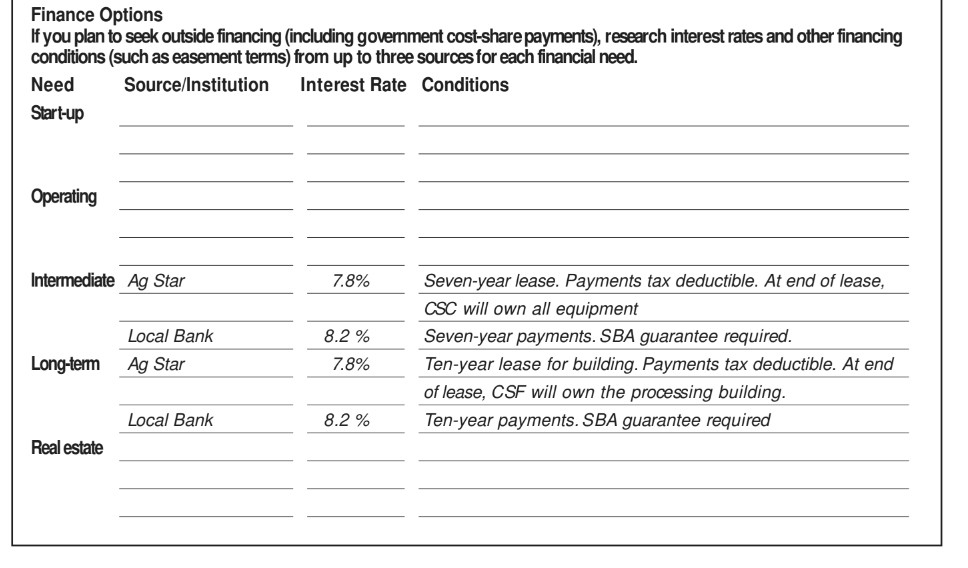
You’ve done a lot of research and brainstorming in this section about risk management, business organization, and capital financing strategies. Use Worksheet 4.28: Financial Strategy Summary (download worksheets for task 4) to summarize your financial strategies for each enterprise into one strategic financial plan for the whole farm. If you are considering more than one whole-farm financial strategy at this point, describe both in the space provided. You may not be able to narrow down your alternatives until after completing a whole-farm evaluation.
Dave and Florence Minar initially recorded two external capital financing options—leasing and debt financing. In Worksheet 4.27, they described the advantages and disadvantages of each alternative. However, it wasn’t until they had consulted with a financial advisor that they made their final decision to finance the business through a lease agreement with Ag Star.
The Minars then went back and summarized their financial strategy, highlighting their legal organization and borrowing components.
Whole Farm Strategy
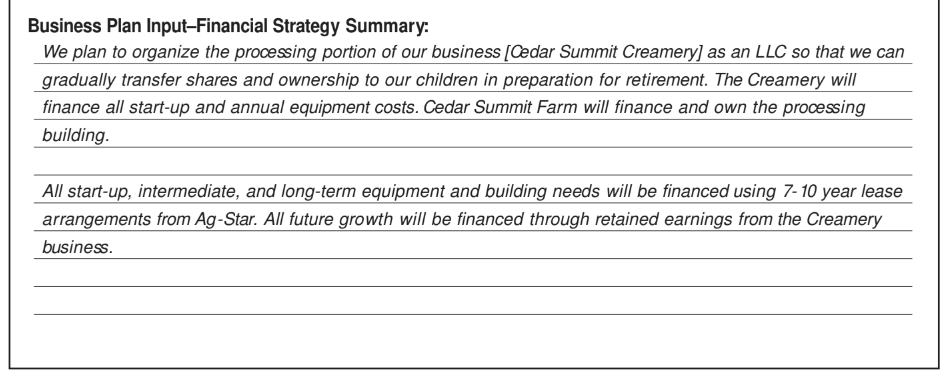
Throughout this Guide, we’ve asked you to break out your business into marketing, operations, human resources and finance components. Now, it’s time to pull all of these components together—to make sure that the strategies you’ve chosen for each functional area are compatible as an integrated system.
If you’ve identified more than one strategy for each functional area, then think about how each strategic alternative might impact the business and other strategies. Dave and Florence Minar considered two operations strategies— the use of new versus used processing equipment. By evaluating how each of these equipment alternatives would affect the marketing, human resources, and finance components of their business, they temporarily ruled out used equipment as an operations strategy and pursued on-farm processing with the use of a new Mini-Dairy equipment package. They reasoned that although the new equipment package was more expensive, it was also more compatible with their overall vision. The new equipment package (which included training and product recipes) would enable them to begin processing and marketing a full line of products from the start, while creating immediate jobs for all of their children who wanted to return to the farm. In contrast, the used equipment alternative would cost the Minars time, sales, and potentially more money in the long-run as they searched for and fit the equipment to their operation, learned how to use the equipment, and experimented with inputs to develop their own products and recipes.
Think about these types of system-wide connections before you move on to the evaluation section. Then use Worksheet 4.29: Summarize a Whole Farm Strategic Plan of Action (download worksheets for task 4) to shape one or more whole farm strategies for your business. If you’ve completed the Summary Worksheets throughout the Planning Tasks (Worksheets 4.9, 4.17, 4.23 and 4.28) this final task should be relatively easy. With a whole farm strategy you will be ready to analyze your business for long-term profitability and cash flow.
If you haven’t already researched product and enterprise expenses for each of the individual strategies you’ve developed (marketing, operations, human resources, finance), do so now. Secure “certified bids” for all equipment and machinery from manufacturers, dealers or representatives. Certified bids come directly from the equipment representative and are often required by lenders when applying for a loan. When certified bids are unavailable, look for published cost estimates (available for the Upper Midwest through the Center for Farm Financial Management) or talk with other producers who purchased similar inputs or who have initiated a similar business strategy.
Dave and Florence Minar obtained certified bids for new processing equipment directly from the Israeli manufacturer, Pladot. Start-up and annual operating expense estimates for items like bottles, crates, flavorings, labor and labels came from business plans shared by other on-farm processors and regional suppliers. The Minars also spoke with local processor Mike Hartman, owner of Minnesota’s Organic Milk (MOM’s) about the cost and availability of local processing supplies.

Once you’ve secured realistic cost estimates, you can properly allocate direct (variable) and overhead (fixed) expenses for the whole farm. Knowing your costs and your cost structure will improve your overall knowledge of the operation and will prove invaluable as you make decisions over time. The difference between direct and overhead expenses as well as a method for allocating overhead expenses among enterprises is explained in Figure 86.
Try to break down your costs between annual direct or variable expenses (those costs that vary with production volume) and annual overhead or fixed expenses (those costs that will be incurred no matter how much you produce). One time start-up costs may be prorated as fixed expenses when developing long-term income projections and as intermediate expenses in your first-year cash flow.
Use Worksheet 4.30: Annual Operating Expenses for the Whole Farm to record and total your annual variable costs and fixed expenses for each whole-farm strategy alternative.
Figure 86.
Allocating Whole Farm Expenses
Direct expenses. Direct or variable expenses typically include annual crop inputs (such as seed, soil amendments and crop insurance) and livestock inputs (feed, pasture maintenance, veterinary expenses) as well as any hired labor, utilities, fuel, interest on operating (12month) loans, and equipment repairs. In addition, your estimate of variable costs should include product-specific marketing expenses.
Direct input expense estimates are available for a wide range of traditional Upper Midwest crop and livestock enterprises from the Center for Farm Financial Management’s website, or for other crops from the USDA National Agricultural Statistics Service’s Agricultural Prices publication (see “Resources”). However, if you plan to produce a specialty crop, use an alternative livestock management systems or offer a highly specialized service, you may have to do a little more digging to develop realistic cost estimates. Talk with other farmers, Extension educators and farm business management consultants, as well as equipment and input dealers to begin putting together cost estimates for organic seed, livestock fencing and watering systems, and other inputs for which price histories do not exist.
Overhead expenses. Overhead or fixed expenses include permanent hired labor (including your own labor and that of other family members), machinery and building leases, farm insurance, dues and professional fees, utilities, and advertising.
When estimating the value of machinery and equipment, be sure to include capital ownership costs such as depreciation, interest, repairs, taxes and insurance estimates rather than the cost of capital itself. Your interest, repairs, taxes, and insurance rates will vary considerably. However, depreciation is fairly standard and can be easily calculated.
Calculating Depreciation. Straight line depreciation, in which an asset is depreciated annually in equal amounts over the asset’s projected life, is commonly used for farm machinery and equipment. The straight line depreciation formula, listed below, can be used when estimating the depreciation value of machinery and equipment for your overhead cost analysis. In the example below, taken from Barry, et al., a new tractor worth $30,000 is depreciated equally over ten years.65 The tractor’s salvage value at the end of the tenyear period is $2,000. Using the straight line calculation, a depreciation charge of $2,800 should be added to the interest, repair, tax, and insurance costs of the tractor for annual enterprise accounting purposes.
| Depreciation Formula | Depreciation Example |
| D = (OC - SV) / N | D = (30,000 - 2,000)/10 D = $2,800 |
| OC = original cost | OC = cost of new tractor, $30,000 |
| SV = salvage value | SV = value of tractor after 10 years, $2,000 |
| N = asset's expected life | N = book life of tractor, 10 years |

Evaluate Strategic Alternatives
You know what you’re going to market, who’s going to buy it and why, how you’re going to produce it, and where your finances will come from. The next question is, will your business actually make it? Will you accomplish your personal and environmental goals, cover costs, generate the income needed to cover family living expenses, service debt, and build equity in the long run?
The evaluation process can be as sophisticated and comprehensive as you like, and there are a wide range of helpful tools available. This Guide presents just a few tools here to help you study whether your whole farm strategy is financially feasible.
Financial evaluation is critical regardless of your goals and planning purpose. This information, along with the goals that you developed in Planning Task Three (Vision, Mission, Goals), will help you choose between whole farm strategies (if you are considering more than one). It will help you evaluate whether your new business strategy is an improvement over your present business approach in the long run.
In this section, you will evaluate the financial feasibility of each whole-farm strategy (or strategies) by preparing long-range and transition period performance projections. Specifically, you will work through a whole farm evaluation to look at projected profitability, liquidity, solvency and risk.
Once you’ve completed the financial evaluation, you may decide to further test and evaluate your strategy for environmental, market, community and quality of life or personal benefits. For instance, notebook and computer software programs, like Farm*A*Syst, are available to help you study the impact of your operations strategy on soil and water quality. Similarly, nonprofit organizations like the Land Stewardship Project can assist with field monitoring for conservation benefits, such as increased amphibian and bird populations. Other organizations like the Agricultural Utilization and Research Institute in Minnesota, can assist with the product development and market testing. Be your own guide when deciding which additional business strategy components to evaluate.
Figure 87.
Tips for Analyzing Strategic Plans
The following guidelines will help you develop more accurate and realistic financial projections:
Use average production levels and prices that realistically can be expected over the long run. Don’t be overly optimistic or conservative. It seems that it is human nature to be one or the other. If you are overly optimistic, you may be fooling yourself into making a major mistake. But if you are overly conservative, you may steer yourself away from a real opportunity.
Estimate costs on a per unit basis first, then calculate totals. Estimate variable costs, those that will vary directly with your production levels, on a per acre or per unit of production basis. Then calculate totals for each alternative. For overhead costs, start with the average expense levels from your past history for what you are doing now. Then adjust them as best you can for your alternative plans.
Include the annual ownership costs of capital investments, not the capital investments themselves. These costs are sometimes caled the DIRTI costs (depreciation, interest, repairs, taxes and insurance).
Allocate homeproduced feed properly. For home produced feeds, estimate your total production in an average year and the total livestock requirements. If the balance is positive, include the balance in crop sales. If the balance is negative, include it in feed purchases.
Be consistent between alternatives. Try not to let your emotions or your desires favor one plan over the other. Your desires will obviously impact your final decisions, but first, get the facts so you can make an informed decision.
Realize that your plans will not be perfect. Don’t agonize over an individual income or expense item too long. But keep your assumptions, and how sure you are about them, in mind when you consider the results.
Long-Term Outlook
Market expansion, operational transitions, and human resources shifts likely will impact output and expenses, and consequently income levels, for more than one year. A long-term evaluation is therefore critical to help you decide whether or not to adopt a new marketing, operations, human resources, finance or whole farm strategy.
You will analyze the financial impact of your potential business change using the same financial criteria or performance measurements that you used when assessing your current financial situation in Planning Task Two (see “Glossary” for definitions).
- Profitability: Will this new strategy significantly increase net income from the farm? —Enterprise Evaluation: Net returns and break-evens —Whole Farm Evaluation: Partial budgeting and long-range planning
- Liquidity: Will this new strategy help generate cash flow sufficient to pay back debts in a timely fashion?
- Solvency: Will this new strategy facilitate continued growth in net worth?
- Risk: Will this new strategy affect the risks faced by the farm business and family?
profitability: will this new strategy significantly increase net income from the farm?
Before you can begin to address this question on a whole-farm basis, you may need to do some preliminary evaluation. If your new strategy includes the addition of a new product enterprise, you should begin by analyzing each enterprise separately, using the net return and break-even calculations.
Enterprise Evaluation for Profitability: Net returns and breakevens.
Most financial planning and evaluation begins at the enterprise level. Whether you are considering the addition of one or more products (enterprises) to your business, an evaluation at this level can help you settle on profitable pricing strategies, crop and livestock mixes, and risk management tactics. Moreover, if you intend to seek outside debt financing for a traditional or specialty operation, farm lenders will request an enterprise budget to evaluate the relative credit worthiness of the enterprise.
An enterprise budget is simply a look at the net returns contributed to the business by each enterprise. It often includes an estimate of the enterprise’s break-even sales price and volume.
Net return. The net return to an enterprise represents returns to (unpaid) operator labor, management and equity capital. It is a measure of profitability, which over the long run should be large enough to justify using unpaid labor and equity capital.
Net returns are easily calculated, particularly if you have already estimated sales revenue, output and expenses (marketing, operations, human resources and finance) in previous Worksheets. Your net return to the enterprise is calculated by subtracting total expenses from gross returns. Worksheet 4.31: Enterprise Budget Breakeven Analysis can be used to calculate enterprise returns.
Break-evens. A break-even analysis is probably one of the most useful calculations that you will perform when considering alternative business strategies. Break-even numbers can be used to instantly identify those enterprises that don’t cover variable and fixed costs of production.
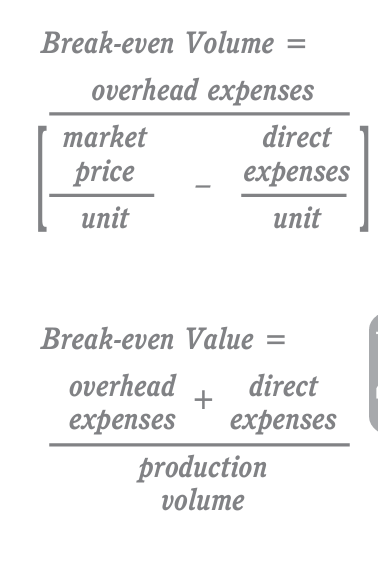
If you intend to sign a market contract or lock in a future price for your product, crunch some numbers to determine what level of production is necessary at that price to break even. Make sure you can cover your variable and fixed costs of production. On the flip side, if your output or production volume is fixed, try calculating a break-even value to determine what product price is necessary to break even on production and marketing-related costs. If neither your price nor output is fixed, these calculations can be used to develop production and price floors for each enterprise—something that will be useful for future monitoring and decision-making.
Calculating a break-even volume. Break-even volumes will tell you the minimum production volume necessary to cover your costs of production. You might consider this a lower size limit for your business. The break-even volume is calculated by dividing total annual fixed costs for the enterprise by the difference between your estimated market value and variable costs for each enterprise. Substitute the DIRTI costs of capital ownership (depreciation, interest, repairs, taxes, and insurance) for the actual cost when estimating the ownership costs of annual fixed expenses. Use the cost estimates that you developed in Worksheet 4.28 along with market values developed in Worksheet 4.9 to calculate break-even volumes. Try experimenting with a range of market prices to see how they affect your break-even production levels.
Calculating a break-even value. If your production volume is fixed—either because of production capacity or sales contracts—calculate a break-even value for your product; in other words, determine what market price is needed to cover your variable and fixed costs. Break-even values are calculated by dividing your total costs for the product or enterprise by the total quantity you expect to produce or sell. Again, your total costs are the sum of your direct and overhead expenses for the enterprise.
Worksheet 4.31 will walk you through a break-even analysis. The Worksheet is not reproduced for the Minars’ bottled milk enterprise for confidentiality reasons. Instead, an example is presented in Figure 88 for an imaginary bed and breakfast business whose annual direct and overhead expenses average $800 and $4,000, respectively. Both a break-even volume and a break-even value are calculated to determine what level of sales and market price would be necessary for the business to cover its full operating costs. In the first example, where the owner expects to charge $75/room, he or she must sell a minimum of 62 rooms each year before breaking even on direct and overhead expenses. In the second example, where the owner’s sales volume is fixed at 80 rooms per year, he or she must charge a minimum of $60/room in order to cover costs.
Figure 88.
Example for Bed and Breakfast Enterprise - Break-even Analysis
Break-even Volume Example
Direct expenses/unit (a) = $10/room (including breakfast)
Overhead expenses (b) = $4,000
Market price/unit (c) = $75/room
Breakeven value (a + b) / (c) = 4,000 / (75 – 10) = 62 rooms/year
Break-even Value Example
Average direct expenses (a) = $800
Average overhead expenses (b) = $4,000
Production volume (c) = 80 rooms
Breakeven value (a + b) / (c) = (4,000 + 800) / 80 = $60/room
Once you’ve calculated one or more break-even numbers for each enterprise or product, compare these numbers against your sales projections (Worksheet 4.2) and your upper limit for production capacity (Worksheet 4.16) or your projected market price (Worksheet 4.6). Are your sales goals financially feasible? Can you produce the break-even volume? Will the market, based on your research, support your minimum break-even value?
Worksheet 4.31 provides the skeleton of an enterprise budget. Use this Worksheet to calculate net returns and break-even numbers for each year during your transition period and for your long run or expected outlook.
If your enterprise doesn’t break even, then you’ll need to take another look at the market or your cost structure. Is there a way to boost your projected market price or to cut input costs? If not—if you can’t break even on your costs—then your business idea for this enterprise is not financially feasible. Stop here, return to your vision and rethink your plan. Is there another way to reach your goals or are you willing to sacrifice income from this enterprise to achieve your vision? On the other hand, if calculations suggest that your enterprise will more than break even, you’re ready to perform a profitability assessment for the whole farm.
Whole Farm Evaluation for Profitability: Partial budgeting and long-range planning. Even more important than the enterprise evaluation is the whole farm financial evaluation. This is where you pull everything together and evaluate whether or not, when all is said and done, the farm will make the profit that you and your family want.
There are two types of financial planning tools available to analyze whole farm profitability: partial budgeting and long-range planning. Both the partial budgeting and long-range planning approaches allow you to compare the outlook of your present farm operation with that of one or more proposed strategic alternatives.
The first tool, partial budgeting, is most useful if your current business is financially sound and the change that you are considering is relatively simple. For instance, Greg Reynolds’ plan to add a staff member and a walk-in cooler would be best analyzed using the partial budget approach since his strategy to relieve seasonal labor constraints does not involve a major change in business operations.
The second tool, long-range planning, is used to project whole farm profitability and cash flow when you are considering substantial reorganization of the business or operations. Long-range planning is different from partial budgeting in that you project the financial status of the business after the change is in place instead of just the financial impact of the change. This planning approach is recommended if your whole farm strategy involves a major change in operations (like the Minars’ addition of an on-farm processing plant and home delivery service) or if you are a beginning farmer with no business history. Long-range planning generally takes more effort than partial budgeting, but there are many advantages to using this tool. After completing a longrange planning analysis you gain a complete financial picture of the farm after implementation and determine if your alternative plans are likely to put your operation on a sound financial course.
Partial budgeting. The partial budget approach uses annual income and expense changes to simultaneously study the impact of a new business idea on your present business’ profitability and cash flow.
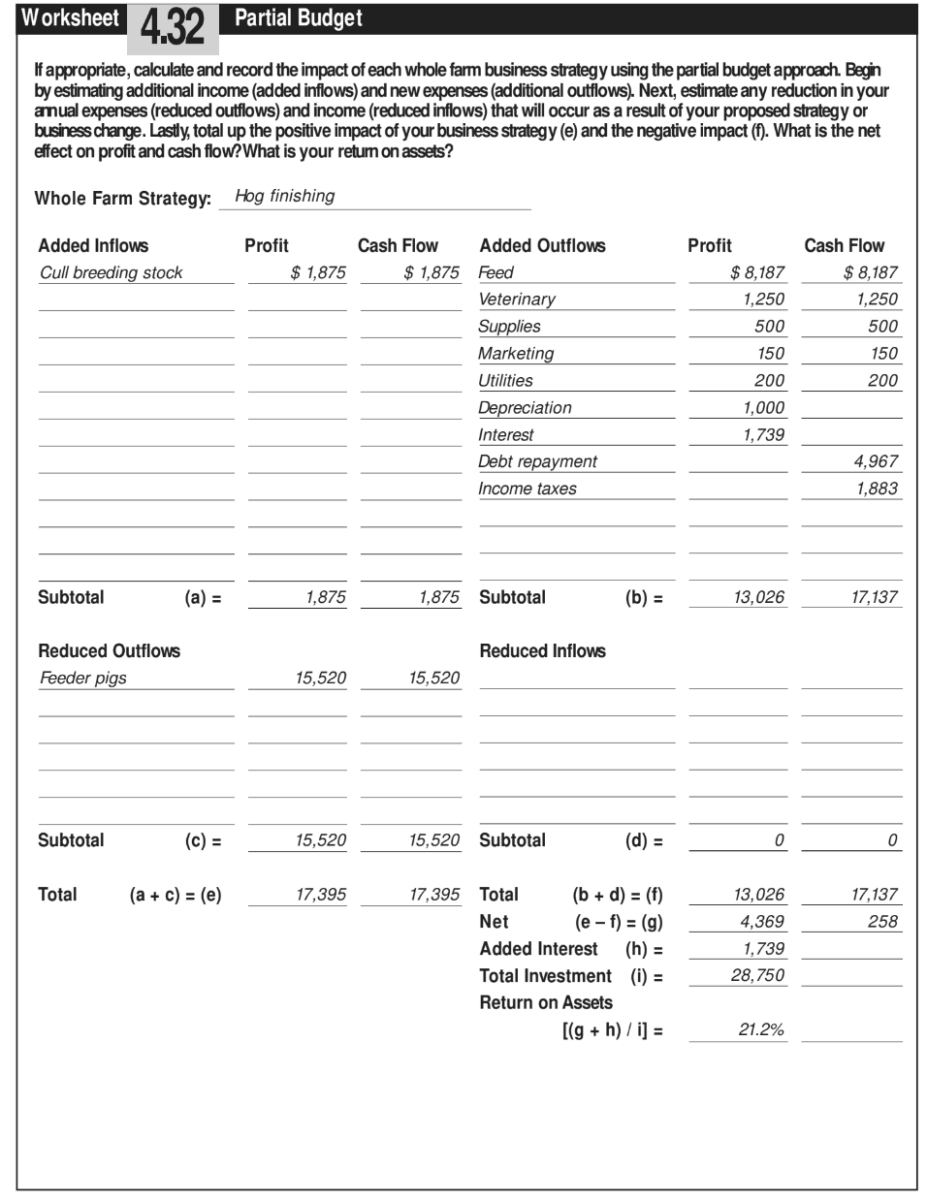
The real-life example in Figure 89 illustrates how partial budgeting can be used to evaluate the financial impact of hoop house and farrowing livestock purchases on a small-scale hog enterprise.66 In this example, the farmer currently purchases and finishes 620 pigs—this is considered her base plan. Alternatively, she would like to farrow and finish 388 pigs in a hoop house (and continue purchasing and finishing out another 230 pigs). With the hoop house and livestock purchases, total costs or outflows for the whole farm increase by $13,026 per year. At the same time, the owner can expect an annual increase in cash inflows equal to $1,875 worth of culled breeding livestock.
The net result shows that the hog operation’s owner will generate $4,369 additional profits from the addition of hoop-house farrowing. The farm owner has captured the ownership cost of the hoop house and breeding livestock by including depreciation and interest on the new investment under the “profit” or long-range income projection. In the cash flow projection depreciation was left out and instead the full value of debt repayment (principal and interest) is added. Dividing the additional income by the $28,750 of new capital, this investment is projected to generate a 21.2 percent annual return on investment.
Worksheet 4.32: Partial Budget (download worksheets for task 4) provides a partial budget format that will help you project the changes in both income and cash flow for relatively minor business changes in marketing, operations, human resources, or finance.
Long-Range planning. The long-range planning approach suggested here is based on the FINPACK software longrange planning module (known as FINLRB). It is designed to project the average expected net farm income for each wholefarm strategy you are considering. Since, in an average year, there will be no inventory change, the format is reasonably simple. Total expenses (variable and fixed) are subtracted from total farm revenue to arrive at net farm income. Cash flow is considered separately and discussed later, when you are measuring liquidity.
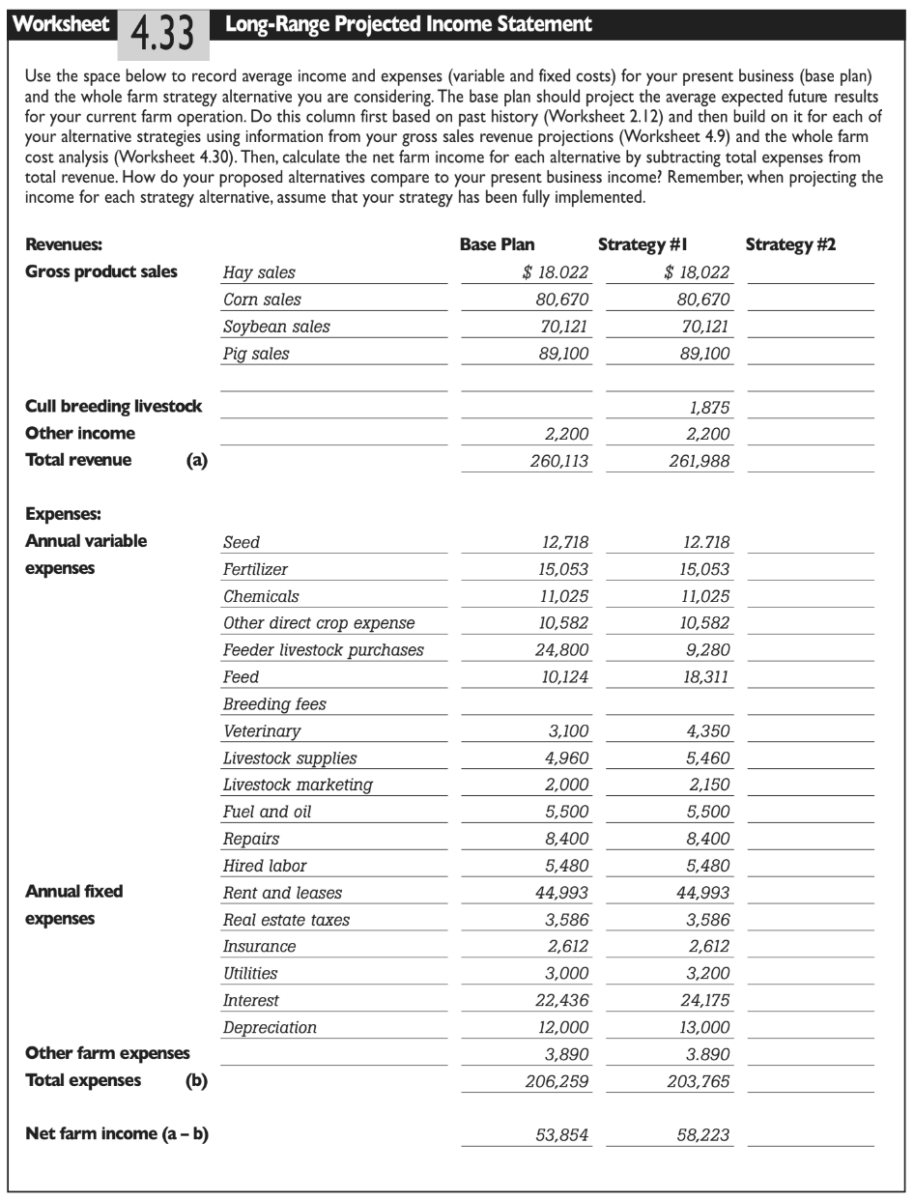
If you choose the long-range planning evaluation method use Worksheet 4.33: Long-Range Projected Income Statement (download worksheets for task 4) to project income and cash flow. Figure 90 shows this Worksheet filled out for the same hog enterprise analyzed in Figure 89.
The base plan projects income and cash flow should the owner continue to purchase and finish out 620 feeder pigs. Strategy 1 reflects the projected income and expenses from farrowing 388 pigs in the hoop house and finishing up to 620 hogs.
Strategy 1 looks slightly more profitable when compared to the base plan. But, there are two other questions that this producer must ask before making a final decision about whether or not to go ahead with plans to farrow and finish in the hoop.
First, will the additional return justify the added investment? While the methodology is not shown here, the hog producer’s FINLRB result shows that the projected rate of return on the added investment is 19.6 percent and that their whole farm rate of return will increase from 6.8 percent to 7.4 percent.
Second, does the projected income and profit from the business satisfy goals for business income? Profitability estimates from the income statement can be compared to the income and quality of life goals (Worksheet 3.3). At a minimum, will the alternative cover a portion or all estimated family living expenses?
Liquidity: Will this new strategy help generate cash flow sufficient to pay back debts in a timely fashion?
Your next task is to look at cash flow for each strategy alternative as well as your base plan. Just because an investment or idea is profitable does not mean that it will generate cash flow to meet debt repayment. The cash flow analysis takes into account owner withdrawals and projected income taxes that were not included in profitability projections.
If you used the partial budget evaluation, return again to Worksheet 4.32 (Partial Budget) and complete the cash flow columns. On the other hand, if you used Worksheet 4.33 (LongRange Projected Income Statement) work through this section using Worksheet 4.34 (Long-Range Projected Cash Flow). Figure 91 shows the projected cash flow for our real-life hog finishing operation and the farrowing alternative.
As you complete Worksheet 4.34: LongRange Projected Cash Flow (download worksheets for task 4), be sure to add depreciation expenses and term debt interest payments to net farm income—this will get you back to a starting cash position. You will have the opportunity to subtract out the full value of principal and interest payments further down on the Worksheet.
Solvency: Will this new strategy lead to growth in the net worth?
When implementing alternative plans you will frequently need to plan for the purchase of additional equipment, machinery, buildings or land. You may plan to sell machinery, land or breeding livestock. Alternative plans that involve these types of capital investments and sales will change the balance sheet and, therefore, the solvency position of the business when they have been implemented.
As discussed in Planning Task Two (History and Current Situation), the balance sheet is a summary of the business’ assets and liabilities at a specific point in time. Your assets, liabilities and possibly net worth as reported on the balance sheet will change significantly with major investment changes (purchases, expansions and reorganizations).
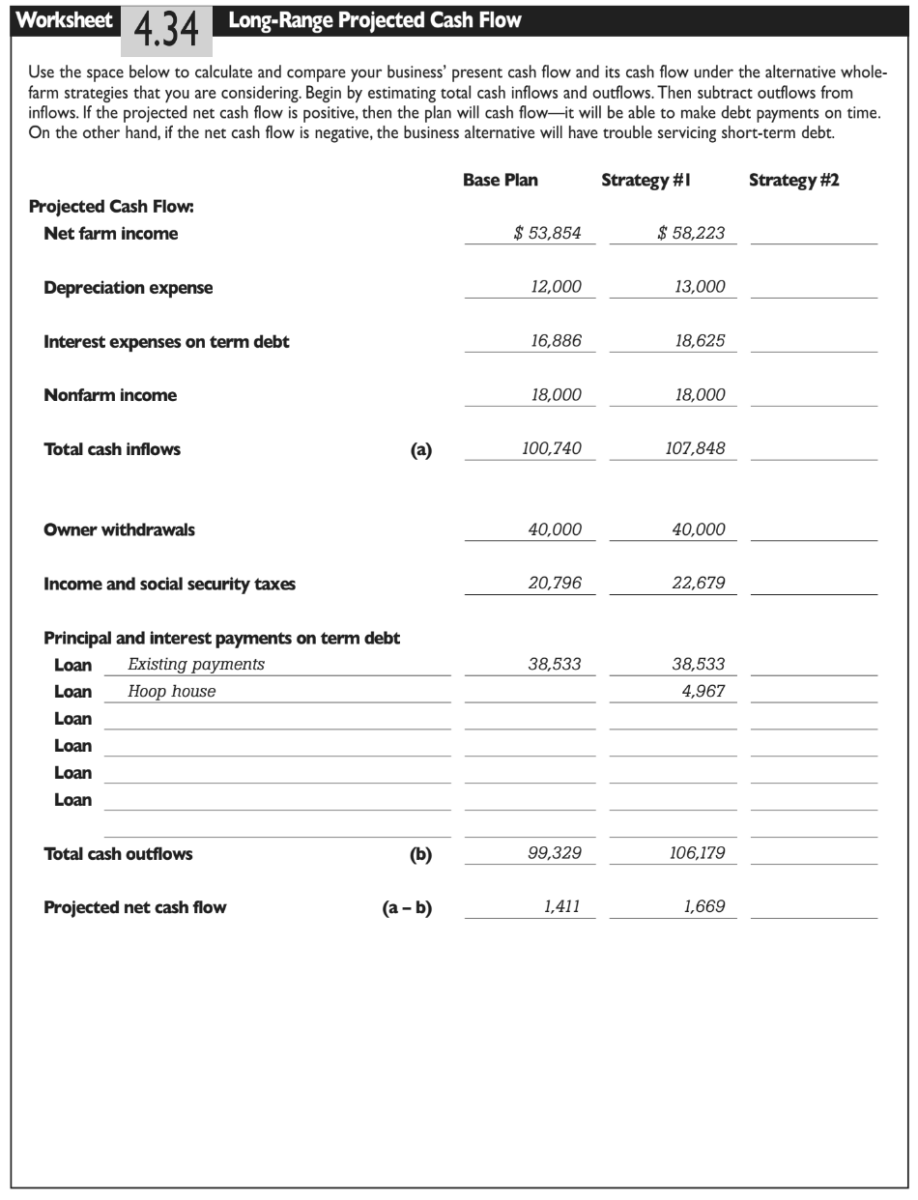
Preparing Worksheet 4.35: Projected Balance Sheet (download worksheets for task 4) will help you work out the impact of your alternative business strategies on equity or future net worth growth. Complete Worksheet 4.35 using either cost or market asset valuation (whichever you used in Planning Task Two). Record “new investments,” “capital sales,” and “liabilities” for your base plan and each whole farm alternative. When doing so, include only the “one-time” changes necessary to move from the base plan to the alternative under consideration. These onetime changes may include the purchase or sale of machinery, buildings and land as well as new investments67 in breeding stock beyond current numbers (including herd sires and additional replacements). Do not include machinery and equipment replacements that are necessary to maintain the existing operation. Moreover, do not include purchases of breeding livestock used to replace cull animals. This Worksheet is only for one-time purchases that are necessary to implement an alternative business plan.
How much equity will your strategy alternative generate in the future compared to your base plan? If your business strategy does not return the level of profit and equity desired or if it cannot service debt, return to your expense estimates, output projections and price forecasts. Is there another alternative you previously ruled out that may be worth reconsidering? The Minars, for instance, could have re-evaluated their plan substituting used equipment for the more expensive, new equipment package had their initial plan failed to cash flow. Is there something you can do differently?
On the other hand, if your strategy appears financially healthy—it yields the profit and equity that you desire and can service debt in a timely manner—then you are ready to shock the analysis. See what happens to your financial picture when market prices decline or input expenses increase. In other words, run through a quick risk analysis of your proposed strategy.
risk: will this new strategy affect the risks faced by the farm business and family?
Like it or not, despite all of your planning, certain aspects of your business are not in your control. Crop yields are subject to weather and disease conditions and other unknowns. Therefore, it’s a good idea to analyze business performance under a range of uncertainties. One way to do this is to project your income and cash flow under the best and worst case scenarios—varying those elements of your business that seem the most vulnerable to uncertainty.
Mabel Brelje, the organic grain farmer, projected income for the four crops in her rotation under best and worst case scenarios. She varied market prices and yields based on her own experience and on conversations with other organic producers. Figure 92 shows how her income for each enterprise will vary with yields (her high and low yield estimates from Worksheet 4.16). Mabel planned for the worst-case yield scenario in her analysis, since she was relatively new to organic production. She also looked for market price contracts, where possible, to secure a profitable market price.
Another way to judge the feasibility of your plan under conditions of uncertainty is to shock the plan. See how sensitive it is to fluctuations in market prices, interest rates, and expenses. Worksheet 4.36 (Risk Analysis) provides a format recommended by Dr. David Kohl of Virginia Tech University.68 His ap proach is to ask what will happen to the financial results if you experience: a five percent reduction in prices; a five percent increase in expenses; or a three percent increase in interest rates?
Figure 93 shows the Risk Analysis Worksheet 4.36 for our example hog enterprise. Note that the base plan and alternative strategy do not cash flow with any of the proposed changes in market price and input expense conditions. The owners of this business would need to consider which plan is more likely to experience a financial shock and make adjustments to reduce their risk.
Figure 92. Income Sensitivity Analysis Prepared by Mabel Brelje
| Yield/Acre | Avg. Projected Market Price/Unit | Gross Income/Acre | Input Cost/Acre | Net Profit/Acre | |
| Best Case Yield Alfalfa Soybeans Wheat Corn | 6 tons 55 bushels 50 bushels 150 bushels | 90 10 3.5 3 | 142 68 73 94 | 142 68 73 94 | 398 482 102 356 |
| Worst Case Yield Alfafa Soybeans Wheat Corn | 3 tons 30 bushels 30 bushels 100 bushels | 90 10 3.5 3 | 270 300 105 300 | 142 68 73 94 | 128 232 32 206 |
In the Minars’ case, the dairy processing alternative was financially superior to their base plan. But which plan is more uncertain? Most would probably agree that the un-established markets assumed in the dairy processing alternative make it more uncertain. So, that uncertainty was something they had to consider in their final decision about whether or not to pursue the milk processing strategy.
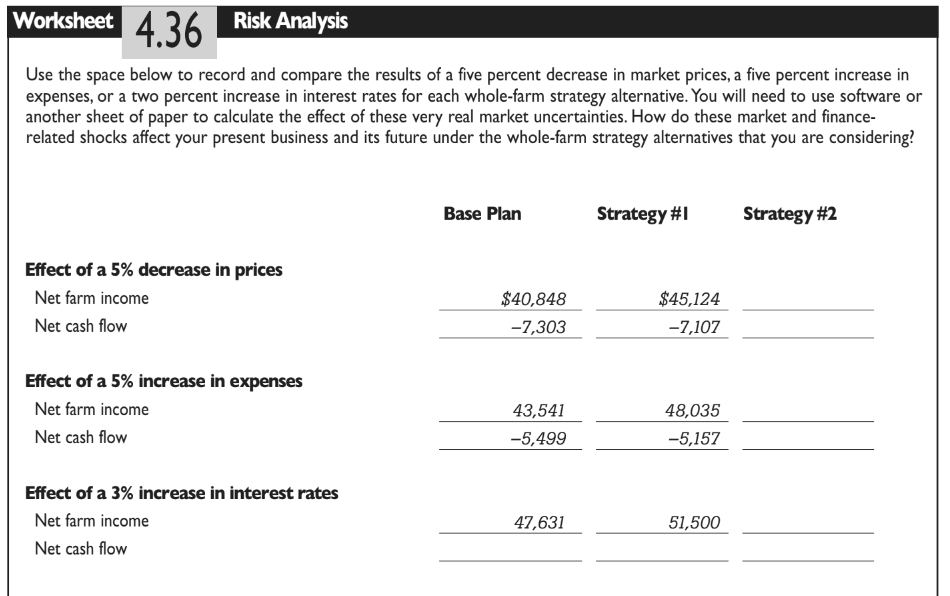
Use Worksheet 4.36: Risk Analysis (download worksheets for task 4) to analyze the financial risk associated with each whole farm strategy that you are considering. If you develop best and worst case scenarios, vary whatever factor seems least controllable—input costs, output, market prices? Likewise, if you choose to shock your original plan, adjust the recommended shocking rate (five percent) based on your own research. Organic producers, for example, have experienced dramatic and steady increases in organic market prices over the past five years as a result of fast growing demand. Conversely, as organic supplies begin to catch up with demand, organic growers could face an equally dramatic decline in prices. What do you think is a reasonable shock based on your own experience?
Transition Period Evaluation
Almost any strategy that you consider will take time to implement and may involve some trade-offs. Sustainable Agriculture author John Mason advises new and existing business owners to expect disruption, even some losses, when transitioning into a new business or management strategy. As you move along the learning curve, things may get worse before they get better. Low yields, high debt payments, unusually high family living expenses, or unexpected machinery replacement needs may cause the cash flow for a profitable farm to be insufficient in a given year.
Figure 94.
What to Do if Your Strategy Isn't Feasible in the Long Run
Financial management specialists recommend the following:
- Change production plans
- Change marketing plans
- Reduce costs
- Reduce consumption
- Refinance
- Institute alternative financing sources and methods
- Consider leasing new capital items
- Postpone expenditures
- Introduce new equity capital
- Seek off farm income
- Sell highly liquid financial assets and inventories
- Downsize the scale of operations
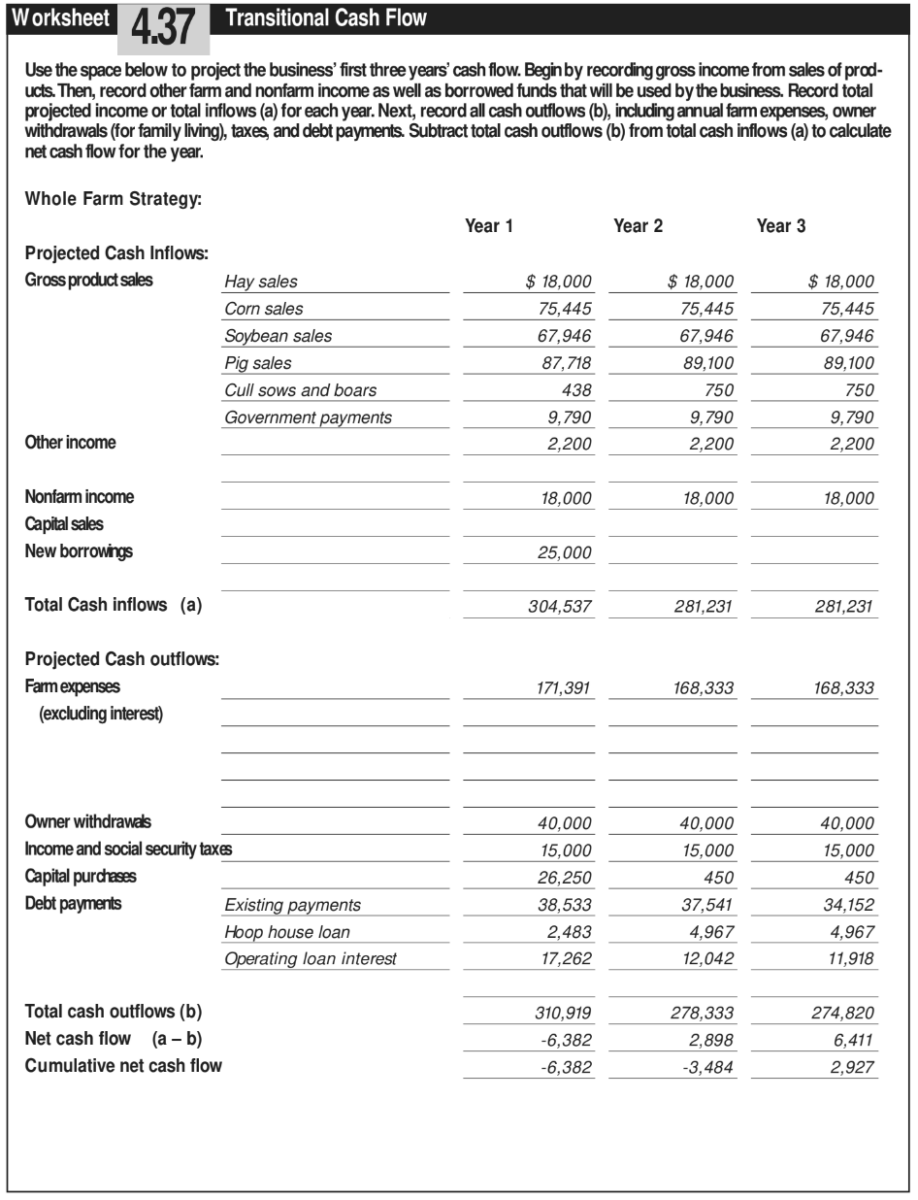
If you are putting together a loan proposal, your lender will probably be more interested in your transitional plans than your long-range plans. The best long-range strategy can be undermined by short-term roadblocks. You need to convince yourself and your external business partners that you can get from here to there.
Your transition plan will be different than the long-range plans that you have already completed.
First, you will prepare a projected cash flow plan for a specific year or years rather than a “typical” or average year in the future. Second, you will use your best estimates of shortterm prices and costs instead of long-range averages. Finally, your transition plans will be affected by your current inventories of crops for sale, feed, market livestock and other products. In your long-range plans, this Guide assumed that you would sell an average year’s production. In transitional planning, you need to work through your projected inventory changes.
Including the change in current inventories is an essential part of developing an accurate cash flow plan. A cash flow plan, which only considers cash transactions without inventory changes, can grossly misrepresent the actual farm financial situation. For example, if two years of crop production are sold in one year, the cash flow will look excellent but the change in current inventories would adjust for the reduction in crop held in storage. Another example might be livestock expansion where the inventories are being built up during the first year but no cash sales occur.
Use Worksheet 4.37: Transitional Cash Flow (download worksheets for task 4) to record your income and expenses during the transition period. You’ll find some of this information on Worksheet 4.31 (Enterprise Budget) where you first recorded expenses.
Figure 95, on the preceding page, shows a summary of the hog producer’s transitional cash flow plan for the first three years of on-farm farrowing. Note that this plan projects that it will take three years before the business will begin to show a positive cash flow. If the hog producer decides to go ahead with her hoop house purchase and farrowing enterprise, she will have to subsidize the business through cash reserves or operating credit during the transition.
There is software available to help you develop transitional cash flow information. The Center for Farm Financial Management’s FINFLO component of FINPACK and most similar software will walk you through a monthly cash flow projection for the next year and then, if need be, push that forward for one or two more years .
Choose the Best Whole Farm Strategy
After all of the brainstorming, analysis and discussion, the final component of strategy formulation is to make a decision—choose a future direction and then implement it. At the end of this section, you will need to make a decision to:
- Stay with the business base plan (make no changes in business).
- Adopt the alternative strategy (implement your new plan).
- Reconsider or brainstorm new alternatives.
If you have done a complete job of laying the foundation and evaluating strategic alternatives, this may be the easiest part. If, for example, you identified a strategic direction that is in tune with your values, moves you toward your personal and family goals, and is technically and financially feasible, it will probably be easy to make this final decision and to get everyone in your family or business on board.
If your decision about which business strategy to pursue is not so clear, you may want to do some more research or explore additional strategy alternatives. Without clarity, each management decision will require a round of agonizing debate and it will be difficult for everyone in your organization to see where the business is headed. These are the types of situations that breed conflict between family members and partners. Your strategic plan should be something that you, your family, and any other stakeholders, can embrace and move toward decisively.
Minnesota economist Kent Olson recommends testing your business strategy or strategies from several perspectives before making the final decision to implement it. Olson outlines a series of subjective “tests” that can be used to rank each of the major strategy alternatives that you are considering (including your base plan) and help you choose the best strategy for your business (Figure 96). He suggests giving each strategy a subjective score, from one to five (five being the highest) for each test. The strategy with the highest score is apparently the best for the farm and for you and your family. You will need to be brutally honest. Take into account the research and evaluation that you have conducted as a team thus far when scoring each whole farm business strategy.
The Minars used the tests to score their base plan and the alternative milk processing strategy (on Worksheet 4.38 as shown in Figure 97). They gave a high score to the processing alternative. It appeared to offer the most promise for future business stability and job creation—objectives that the Minars, as a family, place great importance on. Conversely, the base plan, which reflected their present business, received low scores in all areas related to the family’s future vision. Only those tests related to feasibility and resources (those factors that are known to the Minars) ranked well. Based on this final series of tests, the Minars were very ready to move ahead with their idea to process milk products on the farm.
Figure 96.
Strategy "Best Fit" Tests
Vision Consistency Test. How well does the proposed strategy fit with your whole farm and personal vision? If the strategy does not lead toward your personal and business vision or embrace the core values of your planning team, it should be rejected. Success and enthusiasm will be low and the plan is unlikely to succeed otherwise.
Goodness of Fit Test. How well does the proposed strategy fit with your external analysis of the industry and the internal analysis of your farm? Does the proposed strategy explain how it will build on your business’ current strengths and opportunities while managing for weaknesses and threats? Recall your SWOT analysis from Worksheet 2.18 (in Planning Task Two).
Building for the Future Test. How well does the proposed strategy build for the future? Recall your vision from Planning Task Three. Will your business strategy help get you there? Moreover, will your strategy generate resources, such as soil quality and financial equity, for the next generation? If a strategy uses but does not generate resources, it should receive a low score for this test.
Feasibility and Resource Test. How realistic are the business’ startup and longterm resource needs? In other words, are resources available to implement your whole farm strategy? Review your current list of resources (Worksheet 2.3) and compare them to your resource needs (Worksheet 4.14 in Planning Task Four). Is your soil type appropriate for the crops that you want to grow? Can people be hired to do the work needed? Can financing be obtained?
Performance Test. How well does the proposed strategy help accomplish your marketing, operations, human resources and financial goals for the farm business? What are the projections for income, rates of return, and net worth growth? Most importantly, can your business survive the transition period?
Importance Test. How well does the strategy address the important or critical planning issues that you identified in Introduction Worksheet? Does your strategy focus on these important issues or on the trivial? If a proposed strategy does not address important issues then it should be rejected as written.
Confidence Test. How high is the confidence of your planning team in the anticipated outcomes of the proposed strategy? How high is the risk that events will occur that will change the expected results—particularly in a negative direction?
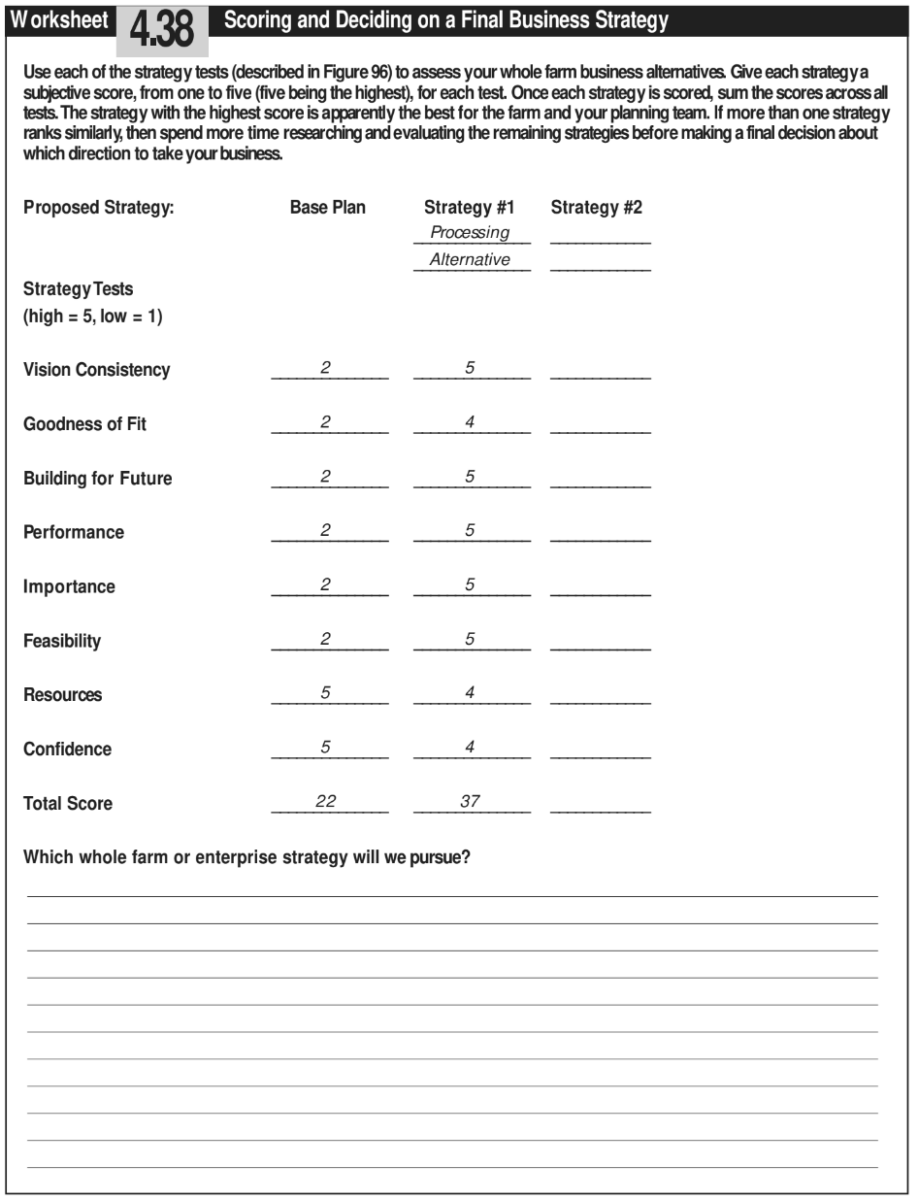
Use Worksheet 4.38: Scoring and Deciding on a Final Business Strategy (download worksheets for task 4) to score your base plan and wholefarm business strategies. How does your new strategy rank? If more than one strategy ranks similarly, then spend more time researching and evaluating the remaining strategies before making a final decision about what direction to take your business. Conversely, if your new strategy is a clear “winner,” move on and begin developing a brief contingency plan for the business.
Develop a Contingency Plan and Exit Strategy
You have confidently chosen a final whole farm strategy based on your thorough research and evaluation. Now, one of your last steps in the planning process is to develop a contingency plan—an action plan for how to respond should conditions within and outside the business change. They will. Contingency planning is important to assure that your business plan will be implemented smoothly.
Throughout the planning process you’ve used your research to inform and make a number of realistic assumptions about the industry, prices, productivity and labor. Assumptions, however, are just that—best guesses that can change. No matter how carefully you plan, the likelihood of everything working out precisely as planned is small. A contingency plan can help you prepare for those situations when things don’t go as planned—when market or economic conditions that are out of your control change. A contingency plan can also help you know when it’s time to exit the business if it is not successful.
Consider how the following problems, for example, could change your cash flow during the transition period:
- New construction costs 20 percent more than planned.
- Funds are borrowed but income flows are delayed for six months.
- Construction is stopped because of a missing regulatory permit.
- Livestock productivity is stunted due to dry pasture conditions.
- The person you hire to manage operations is incompetent or untrustworthy.
- You do not obtain a sales contract for your first year’s production.
- Market prices sink to 15 percent below average historical values. A sound business plan will lay out what needs to be done to avoid or address these delays, inefficiencies, and bottlenecks in the form of a contingency or control plan.
Contingency plans need not be long or complicated. If you intend to share your written business plan with lenders or other external business partners, contingency plans simply need to convince readers that you’ve done a thorough job of planning and that the business is prepared to respond successfully should internal and external conditions change. If your business plan is strictly for family or internal planning purposes, a contingency plan can be used as something to fall back on should marketing prices, labor supplies, family goals, and institutional requirements change unexpectedly. It can also be used to guide discussions about when best to “get out” of the business if too many strategies fail.
Authors of Planning for Contingencies note that there are several ways to incorporate contingency plans into your final business plan: “For example, your financial statements can incorporate a footnote explaining that the projected interest rate can go up by as much as three percent before your profit margin is seriously affected. Or, your discussion of how many employees you’ll need can state that an additional production person will be hired when sales of $X are achieved.”
Begin your contingency planning by identifying events that may throw your strategy off track and necessitate a major change in your business plan—like a change in government policy, market prices, organic certification rules. The Minars, for instance, identified new competition—other farmers or businesses that begin offering non-homogenized or glass-bottled milk—as a source of uncertainty. Their contingency plan could include a number of ideas, such as “frequent customer” discounts, for coping with increased competition. Conversely, the Minars’ contingency plan might include plans to cope with labor and production constraints should home delivery sales exceed their expectations. If for example, 150 customers—rather than the projected 75—sign up for home delivery during the Minars’ first three months of processing, how would they respond? Additional milk would be available for processing, but Dave and Florence might need to hire and train new staff to fill orders or risk losing potential customers.
As stated earlier, your contingency plan need not be complicated. You simply need to show that you have thought through and planned for a range of future scenarios. Take a look at the contingency plan prepared by Greg Reynolds, owner of Riverbend Farm:
“If CSA sales do not materialize, I will sell the produce to restaurants and co-ops. The lack of up-front money will delay the plans to build a root cellar. The need for help and a cooler are crucial to expanding the business. Without the CSAs, weekly sales [to restaurants and co-ops] will have to reach $1,000/week [in order to meet financial goals]. That is about 40 cases per week, harvesting two cases per hour per person or 20 hours of additional labor.”
oreover, your contingency plan should include some parameters that define when it may be time to exit the busines or “cut your losses” should market or personal conditions change dramatically. In this case you should have some idea how to repay investors, for example, and address tax consequences. Lenders, lawyers and business partners may be able to help prepare this section of your contingency plan. What are your contingency plans for the business? Take some time to discuss with your planning team how internal and external conditions may change in the future. Then use Worksheet 4.39: Contingency Statement (download worksheets for task 4) to develop a brief contingency plan for the business.
Prepare the Strategy Section of Your Business Plan
The work that you’ve done in this Planning Task is very much about the planning process. But the culmination of all of your work is the development of a very specific business strategy. This strategy, along with the research that supports it, will become the crux of your written business plan. Take time now to summarize your business strategy for the whole farm.
One way to do this is to draft the Executive Summary for your business plan—to summarize your principal business planning objective, goals, and your strategy (or strategies) for reaching them. Authors of The Executive Summary say “The executive summary is, perhaps, the most important section of your written business plan since many readers, including lenders, will not look beyond the executive summary if it does not communicate careful planning and promise.”
An Executive Summary typically includes information about the business:
- Identity: Who you are (and the name of your business).
- Location: Where the business is located.
- History: How long the business has been in operation.
- Ownership: Current ownership structure.
- Industry and Competition: Brief description of the business’ competitive position.
- Product: What type of product you now offer and plan to market in the future.
- Marketing: Who your potential customers are and what they will value.
- Operations: How you will produce.
- Human Resources: Who will manage and staff the business.
- Finances: How much profit and equity the business will generate, how you intend to finance the business and how you will cope with and manage risk.
The Executive Summary is a snapshot of your business and its strategy. It can be as short as you like but generally no longer than two pages. Most importantly, your Executive Summary should convey credibility and excitement, particularly if you are seeking external financing or new business partners. As an example, the Executive Summary prepared by Dave and Florence Minar for Cedar Summit Farm is reproduced in Figure 98. Look at how they incorporated information about their values, vision, research, and financial analysis into a concise, positive and realistic summary of their strategy to process milk on the farm.
Use Worksheet 4.40: Executive Summary (download worksheets for task 4) to draft an executive summary for your business plan. With an executive summary in hand, you’re ready to write the rest of your plan! Move on to Planning Task Five—Present, Implement, and Monitor Your Business Plan!
